
User Guide
©2011 Sprint. SPRINT and the logo are trademarks of Sprint. Other marks are the property of their respective owners.
11/22/11
Consejo: Para encontrar esta guía para usuarios en español, por favor visita a www.sprint.com y haz clic en Support > Devices.
To find this user guide in Spanish, please visit

www.sprint.com and click Support > Devices.


Important Privacy Message – Sprint’s policies often do not apply to third-party applications. Third-party applications may access your personal information or require Sprint to disclose your customer information to the third-party application provider. To find out how a third-party application will collect, access, use, or disclose your personal information, check the application provider’s policies, which can usually be found on their website. If you aren’t comfortable with the third-party application’s policies, don’t use the application.
Open Source Software – Some software components of this product incorporate source code covered under GNU General Public License (GPL), GNU Lesser General Public License (LGPL), OpenSSL License, BSD License and other open source licenses. To obtain the source code covered under the open source licenses, please visit: http://opensource.samsungmobile.com/index.jsp.
This device uses open source software. Press > >
> About phone > Legal information on the device for more details.
SPH-M580_UG_EK18_LH_112211_F2
Table of Contents
![]()
![]()
Tip: Looking for something? If you don’t see it in the headings listed here, try the Index on page 211.
Introduction . . . . . . . . . . . . . . . . . . . . . . . . . . . . . . . i Your Device’s Menu . . . . . . . . . . . . . . . . . . . . . . . . i Section 1: Getting Started . . . . . . . . . . . . . . . . . 1
1A. Setting Up Service . . . . . . . . . . . . . . . . . . . 2
Setting Up Your Device . . . . . . . . . . . . . . . . . . . . . . 2
Activating Your Device . . . . . . . . . . . . . . . . . . . . . . 4
Setting Up Your Voicemail . . . . . . . . . . . . . . . . . . . 6
Sprint Account Passwords . . . . . . . . . . . . . . . . . . . 7
Getting Help . . . . . . . . . . . . . . . . . . . . . . . . . . . . . . . 8
Section 2: Your Device . . . . . . . . . . . . . . . . . . . 11
2A. Device Basics . . . . . . . . . . . . . . . . . . . . . . 12
Your Device . . . . . . . . . . . . . . . . . . . . . . . . . . . . . . . 13
Viewing the Display Screen . . . . . . . . . . . . . . . . . 17
Turning Your Device On and Off . . . . . . . . . . . . . 20
Battery and Charger . . . . . . . . . . . . . . . . . . . . . . . 20
Device Function Keys . . . . . . . . . . . . . . . . . . . . . . 24
Navigation and Customization . . . . . . . . . . . . . . 28
Displaying Your Phone Number . . . . . . . . . . . . . 42
Entering Text Using the Onscreen Keyboards . 42
Entering Text Using the QWERTY Keyboard . . 46
Creating a Google Account . . . . . . . . . . . . . . . . 50
2B. Making and Answering Calls . . . . . . . . . 51
Making Calls . . . . . . . . . . . . . . . . . . . . . . . . . . . . . 51
Dialing Options . . . . . . . . . . . . . . . . . . . . . . . . . . . 52
Answering Calls . . . . . . . . . . . . . . . . . . . . . . . . . . 52
Missed Call Notification . . . . . . . . . . . . . . . . . . . . 53
Calling Emergency Numbers . . . . . . . . . . . . . . . 54
In-Call Options . . . . . . . . . . . . . . . . . . . . . . . . . . . . 55
Additional Calling Options . . . . . . . . . . . . . . . . . . 56
Saving a Phone Number . . . . . . . . . . . . . . . . . . . 56
Finding a Phone Number . . . . . . . . . . . . . . . . . . 57
Dialing From the Contacts List . . . . . . . . . . . . . . 57
Speed Dialing . . . . . . . . . . . . . . . . . . . . . . . . . . . . 57
Plus (+) Code Dialing . . . . . . . . . . . . . . . . . . . . . . 58
2C. Settings . . . . . . . . . . . . . . . . . . . . . . . . . . . . 59
Sound Settings . . . . . . . . . . . . . . . . . . . . . . . . . . . 59
Display Settings . . . . . . . . . . . . . . . . . . . . . . . . . . . 62
Language Settings . . . . . . . . . . . . . . . . . . . . . . . . 64
Location Settings . . . . . . . . . . . . . . . . . . . . . . . . . 64
Synchronizing Accounts . . . . . . . . . . . . . . . . . . . 65
Search Settings . . . . . . . . . . . . . . . . . . . . . . . . . . . 69
Call Settings . . . . . . . . . . . . . . . . . . . . . . . . . . . . . . 70
Airplane Mode . . . . . . . . . . . . . . . . . . . . . . . . . . . . 70
TTY Use With Sprint Service . . . . . . . . . . . . . . . . 71
Security Settings . . . . . . . . . . . . . . . . . . . . . . . . . . . 72
2D. Call Logs . . . . . . . . . . . . . . . . . . . . . . . . . . . 79
Viewing Call Logs . . . . . . . . . . . . . . . . . . . . . . . . . . 79
Call log Options . . . . . . . . . . . . . . . . . . . . . . . . . . 80
Making a Call From Call log . . . . . . . . . . . . . . . . 82
Saving a Number From Call log . . . . . . . . . . . . 82
Altering a Number From Call log . . . . . . . . . . . 83
Erasing the Call log Entries . . . . . . . . . . . . . . . . . 83
2E. Contacts . . . . . . . . . . . . . . . . . . . . . . . . . . . 84
Creating a New Contacts Entry . . . . . . . . . . . . . 84
Saving a Phone Number . . . . . . . . . . . . . . . . . . 86
Confirming Contact Synchronization . . . . . . . . 86
Contacts Menu Options . . . . . . . . . . . . . . . . . . . 88
Contacts Entry Options . . . . . . . . . . . . . . . . . . . . 88
Editing a Contacts Entry . . . . . . . . . . . . . . . . . . . . 89
Adding a Number to a Contacts Entry . . . . . . . 89
Editing a Contacts Entry’s Number . . . . . . . . . . . 90
Sharing Contacts . . . . . . . . . . . . . . . . . . . . . . . . . . 90
Assigning a Picture to an Entry . . . . . . . . . . . . . . 91
Deleting Entries . . . . . . . . . . . . . . . . . . . . . . . . . . . 91
Adding Entries to Your Favorites . . . . . . . . . . . . . 92
2F. Calendar & Tools . . . . . . . . . . . . . . . . . . . 93
Before You Begin . . . . . . . . . . . . . . . . . . . . . . . . . . 93
Calendar . . . . . . . . . . . . . . . . . . . . . . . . . . . . . . . . . 93
Clock . . . . . . . . . . . . . . . . . . . . . . . . . . . . . . . . . . . . 98
Calculator . . . . . . . . . . . . . . . . . . . . . . . . . . . . . . . 100
Updating Your Device Firmware . . . . . . . . . . . . 101
Updating Your Profile . . . . . . . . . . . . . . . . . . . . . 103
Updating Your PRL . . . . . . . . . . . . . . . . . . . . . . . 103
Update Your Samsung Software . . . . . . . . . . . 103
2G. Voice Services . . . . . . . . . . . . . . . . . . . . 104
Voice Dialing . . . . . . . . . . . . . . . . . . . . . . . . . . . . . 104
Opening Menus With Voice Dialer . . . . . . . . . . 105
Voice Recognizer . . . . . . . . . . . . . . . . . . . . . . . . . 106
Text-to-Speech . . . . . . . . . . . . . . . . . . . . . . . . . . . 106
Voice Search . . . . . . . . . . . . . . . . . . . . . . . . . . . . 107
2H. microSD Card . . . . . . . . . . . . . . . . . . . . . 108
Your Device’s microSD Card and Adapter . . . 108
Connecting Your Device to Your Computer . . 110 microSD Card Settings . . . . . . . . . . . . . . . . . . . . 114
Important Connection Information . . . . . . . . . . 114
2I. Camera . . . . . . . . . . . . . . . . . . . . . . . . . . . 116
Taking Pictures . . . . . . . . . . . . . . . . . . . . . . . . . . . 116
Recording Videos . . . . . . . . . . . . . . . . . . . . . . . . 120
2J. Bluetooth . . . . . . . . . . . . . . . . . . . . . . . . . . 124
Turning Bluetooth On and Off . . . . . . . . . . . . . . 124
Using the Bluetooth Settings Menu . . . . . . . . . 125
Pairing Bluetooth Devices . . . . . . . . . . . . . . . . . 126
Sending Contacts via Bluetooth . . . . . . . . . . . . 127
Disconnecting Bluetooth Connection
During an Active Call . . . . . . . . . . . . . . . . . . . . . 129
Section 3: Sprint Service . . . . . . . . . . . . . . . . 131
3A. Sprint Service: The Basics . . . . . . . . . . 132
Voicemail . . . . . . . . . . . . . . . . . . . . . . . . . . . . . . . . 132
Text Messaging (SMS) . . . . . . . . . . . . . . . . . . . . 133
Multimedia Messaging (MMS) . . . . . . . . . . . . . 135
Caller ID . . . . . . . . . . . . . . . . . . . . . . . . . . . . . . . . 139
Call Waiting . . . . . . . . . . . . . . . . . . . . . . . . . . . . . 139
Making a 3-Way Call . . . . . . . . . . . . . . . . . . . . . 140
Call Forwarding . . . . . . . . . . . . . . . . . . . . . . . . . . 141
Roaming . . . . . . . . . . . . . . . . . . . . . . . . . . . . . . . . 141
3B. Web and Data Services . . . . . . . . . . . . . 143
Getting Started With Data Services . . . . . . . . . 143
Navigating the Web . . . . . . . . . . . . . . . . . . . . . . 145
Wi-Fi . . . . . . . . . . . . . . . . . . . . . . . . . . . . . . . . . . . 151
Email . . . . . . . . . . . . . . . . . . . . . . . . . . . . . . . . . . . 154
Books . . . . . . . . . . . . . . . . . . . . . . . . . . . . . . . . . . 169
Using the Android Market . . . . . . . . . . . . . . . . . 170
Downloading Applications From the Web . . . 172
Sprint Applications . . . . . . . . . . . . . . . . . . . . . . . 172
Data Services FAQs . . . . . . . . . . . . . . . . . . . . . . 176
3C. Entertainment: TV and Music . . . . . . . . 178
Getting Started with Sprint TV,
Music, and Movies . . . . . . . . . . . . . . . . . . . . . . . 178
Sprint Music . . . . . . . . . . . . . . . . . . . . . . . . . . . . . 179
Music Player . . . . . . . . . . . . . . . . . . . . . . . . . . . . . 179
Sprint Radio . . . . . . . . . . . . . . . . . . . . . . . . . . . . . 180
Sprint TV & Movies . . . . . . . . . . . . . . . . . . . . . . . | . 181 | User Guide Proprietary Notice . . . . . . . . . . . . . . 202 |
YouTube . . . . . . . . . . . . . . . . . . . . . . . . . . . . . . . . | 182 | 4B. Manufacturer’s Warranty . . . . . . . . . . . 203 |
3D. GPS Navigation . . . . . . . . . . . . . . . . . . . . | 184 | Manufacturer’s Warranty . . . . . . . . . . . . . . . . . . . 203 |
GPS Services . . . . . . . . . . . . . . . . . . . . . . . . . . . | 184 | Index . . . . . . . . . . . . . . . . . . . . . . . . . . . . . . . . . . . 211 |
Google Maps . . . . . . . . . . . . . . . . . . . . . . . . . . . | 184 | |
Navigation . . . . . . . . . . . . . . . . . . . . . . . . . . . . . . | 186 | |
TeleNav GPS Navigator . . . . . . . . . . . . . . . . . . . | 186 | |
Getting Driving Directions . . . . . . . . . . . . . . . . . | 188 |
Section 4:
Safety and Warranty Information . . . . . . . . . 193
4A. Important Safety Information . . . . . . . . 194
General Precautions . . . . . . . . . . . . . . . . . . . . . . 194
Maintaining Safe Use of and
Access to Your Phone . . . . . . . . . . . . . . . . . . . . 195
Using Your Phone With a
Hearing Aid Device . . . . . . . . . . . . . . . . . . . . . . 196
Caring for the Battery . . . . . . . . . . . . . . . . . . . . 198
Radio Frequency (RF) Energy . . . . . . . . . . . . . 199
Samsung Mobile Products
and Recycling . . . . . . . . . . . . . . . . . . . . . . . . . . . 201
Owner’s Record . . . . . . . . . . . . . . . . . . . . . . . . . 201
Introduction
![]()
This User Guide introduces you to Sprint® service and all the features of your new device. It’s divided into four sections:
• Section 1: Getting Started
• Section 2: Your Device
• Section 3: Sprint Service Features

• Section 4: Safety and Warranty Information

Note: Because of updates in your device’s software, this printed guide may not be the most current version for your device. Visit www.sprint.com and sign on to My Sprint to access the most recent version of the user guide.
WARNING: Please refer to the Important Safety Information section on page 194 to learn about information that will help you safely use your device. Failure to read and follow the Important Safety Information in this device guide may result in serious bodily injury, death, or property damage.
Your Device’s Menu
![]()
The following table outlines your device’s main menu structure. For more information about using your device’s menus, see “Navigation and Customization” on page 28.![]()
From the Home screen, press ![]() to open the menu:
to open the menu:
• Add ( )
• Wallpaper ( )
• Settings ( )
• Switch ID ( )
• Search ( )
• More ( )
Tap these onscreen buttons to reveal these additional options and features.
Device menus with additional options (“sub-options”)
appear with ![]() adjacent to the list entry.
adjacent to the list entry.
i
> Add | ||
1: Shortcuts | ||
1: Applications 2: Bookmark 3: Contact 4: Direct dial 5: Direct message 6: Directions & Navigation 7: Email 8: Gmail label 9: Music playlist 10: Settings | ||
2: Widgets | ||
1: Analog clock 2: Calendar 3: Google Search 4: Home screen tips 5: Latitude 6: Market 7: Music 8: News & Weather 9: Picture frame 10: Power Control 11: Rate Places 12: Traffic 13: Tutorial #1 14: Tutorial #2 15: Tutorial #3 16: Tutorial #4 17: Tutorial #5 18: YouTube | ||
3: Folders | ||
1: New folder 2: All contacts 3. Bluetooth received 4: Contacts with phone numbers 4: Google Contacts 5: Recent documents 6: Starred contacts |
![]()
![]()
![]()
ii
5: Bluetooth settings | ||
1: Bluetooth (On/Off) 2: Device name 3: Discoverable (On/Off) 4: Discoverable timeout 5: Scan for devices 6: <detected Bluetooth devices> | ||
6: Tethering | ||
1: USB tethering (On/Off) 2: Help | ||
7: USB connection | ||
1: Charging 2: Mass storage 3: Tethered mode 4: Ask on connection | ||
8: VPN settings | ||
1: Add VPN | ||
9: Mobile networks | ||
1: 3G data (On/Off) | ||
10: Roaming | ||
1: Roaming mode 2: Roaming settings 3: Roaming guard | ||
| > Settings > Call settings | |
1: North American dialing (On/Off) | ||
2: International dialing |
![]()
iii
Feedback | ||
1: Audible touch tones (On/Off) | ||
2: Audible selection (On/Off) | ||
3: Screen lock sounds (On/Off) | ||
4: Haptic feedback (On/Off) | ||
> Settings > Display settings | ||
1: Brightness | ||
2: Auto-rotate screen (On/Off) | ||
3: Animation | ||
1: No animations 2: Some animations 3: All animations | ||
4: Screen timeout | ||
1: 15 seconds 2: 30 seconds 3: 1 minute 4: 2 minutes 5: 10 minutes | ||
5: Keyboard timeout | ||
1: 3 seconds 2: 6 seconds 3: 15 seconds 4: Same as Screen timeout | ||
6: Notification flash (On/Off) |
![]()
![]()
iv

![]() > Settings > Privacy
> Settings > Privacy
Personal data
1: Factory data reset
> Settings > Storage
SD card
1: Total space
2: Available space
3: Mount/Unmount SD card
4: Erase SD card
Internal storage
![]() 1: Available space
1: Available space
> Settings > Language &
keyboard
Language settings
1: Select language
1: English 2: Espanol
v
2: User dictionary | ||
Keyboard settings | ||
1: Android keyboard (On/Off) | ||
2: Android keyboard | ||
1: Vibrate on keypress 2: Sound on keypress 3: Popup on keypress 4: Touch to correct words 5: Auto-capitalization 6: Show settings key 7: Voice input 8: Input languages 9: Quick fixes 10: Show suggestions 11: Auto-complete | ||
3: Built-in keyboard | ||
1: Auto-replace (On/Off) 2: Auto-cap (On/Off) 3. Auto-punctuate (On/Off) | ||
> Settings > Voice input & output | ||
Voice input | ||
1: Voice recognizer settings | ||
1: Language 2: Safe Search 3: Block offensive words 4: Personalized recognition 5: Google Account dashboard |
![]()
![]()
![]()
vi
5: Use 24-hour format (On/Off) | ||
6: Select date format | ||
1: Normal (MM/DD/YYYY) 2: MM/DD/YYYY 3: DD/MM/YYYY 4: YYYY/MM/DD | ||
> Settings >About phone | ||
1: System Updates | ||
1: Update Firmware 2: Update Profile 3: Update PRL 4: Update Samsung Software | ||
2: Status | ||
1: Battery status 2: Battery level 3: My phone number 4: MSID 5: PRL Version 6: MEID 7: Network 8: Signal strength 9: Service state 10: Roaming 11: User name 12: Mobile network state 13: Wi-Fi MAC address 14: Bluetooth address 15: Up time 16: Channel/SID | ||
3: Battery use | ||
4: Legal information | ||
1: Open source licenses 2: Google legal 3: Privacy Alert from Sprint | ||
5: Model number |
![]()
![]()
vii

Section 1
Getting Started
![]()
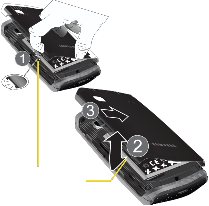
1A. Setting Up Service

• Setting Up Your Device (page 2)
• Activating Your Device (page 4)
• Setting Up Your Voicemail (page 6)
• Sprint Account Passwords (page 7)
• Getting Help (page 8)
Setting Up Your Device
![]()
1. Install the battery.
• Remove the battery from its packaging.
• Grasp the device firmly and locate the cover release latch.
• Place your fingernail in the opening and firmly “pop” the cover off the device (similar to a soda can).
Release Latch
• Insert the battery into the opening in the back of the device, making sure the connectors align. Gently press down to secure the battery.
• Position the battery cover over the battery compartment and press down until you hear a click.
2 1A. Setting Up Service
![]()
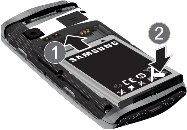
2. Press and hold ![]() to turn the device on.
to turn the device on.
• If your device is activated, it will turn on, search for
Sprint service, and enter standby mode.![]()
3. Make your first call.
• Press to access the Home screen and touch to access the onscreen keypad.
• Use the onscreen dialpad to enter a phone
![]()
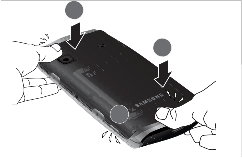
3

4
Note: Your device’s battery should have enough charge for your device to turn on and find a signal, set up your voicemail, and make a call. You should fully charge your battery as soon as possible.
![]()
5
Note: To unlock your phone from this screen, touch and
drag the lock screen.
1A. Setting Up Service 3
Activating Your Device
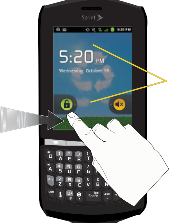
Unlock Screen
![]()
e If you purchased your device at a Sprint Store, it is probably activated and ready to use.
e If you received your device in the mail and it is for a new Sprint account or a new line of service, it is designed to activate automatically. To confirm your activation, make a phone call.
e If you received your device in the mail and you are activating a new device for an existing number on your account, (you’re swapping phones), you can activate on your computer online or directly on your phone.
• Activate on your computer:
● Go to sprint.com/activate and follow the instructions.![]()
• Activate on your phone:
Important: For security reasons, you will need your Sprint phone number and PIN to use this activation method.
1. Turn on your new phone. (Make sure the old one is turned off.) Your phone will automatically attempt Hands-Free Activation.
4 1A. Setting Up Service
Note: Your phone will need to complete one hands-free activation attempt before you can continue.
Note: If you don’t override Hands-Free Activation, your phone will attempt to auto activate five times. Wait for Retry to appear on your screen. Tap Retry and then tap Activate.

2. Follow the on-screen prompts to complete the activation process.
3. After you have completed the wizard, make a phone call to confirm your activation.
![]()
If your device is still not activated or you do not have access to the Internet, contact Sprint Customer Service at 1-888-211-4727 for assistance.
Note: If you are having difficulty with activation, contact Sprint
Customer Service by dialing 1-888-211-4727 from any
![]()
Sprint ID
Once your device is activated, you have the option of installing an ID Pack. ID Packs are bundles of applications, ringtones, wallpapers, settings, and more. ID Packs are installed using an application called Sprint ID.
You can install as many as five ID Packs at any one time, and you can easily switch from one ID Pack to another without losing any applications already installed.
For example, when you install the Sprint ID pack, Sprint applications such as Sprint TV, TeleNav™ GPS Navigator, NASCAR Sprint Cup Mobile, and Sprint Football Live will remain in your applications.
Installing Your First ID Pack

other phone. Note: Your device must be activated, your battery should be
fully charged, and you should be in a network coverage
area before you install an ID Pack.
1. From the home screen, tap
2. On the Welcome to Sprint ID screen, tap Continue.
1A. Setting Up Service 5
• If your device is in PowerSave mode, press ![]() to reactivate the screen.
to reactivate the screen.
• If the lock screen appears, unlock it by dragging the Unlock icon ![]() to the right side of the
to the right side of the![]()
screen.)
Note: You also have the ability to place an emergency call directly from the Welcome to Sprint ID screen.
3. Tap Get New ID Packs on the Choose your ID
screen. (My ID is the default ID Pack.)![]()
4. Tap an ID Pack on the Sprint ID screen.
Note: The Sprint ID pack comes with wallpapers, ringtones, and applications.
5. Read the information screen for a description of the ID Pack and touch Install.
6. Read the Terms & Conditions and tap Agree.
7. Wait for the download and install to finish. (If prompted, tap Complete Install.)![]()
8. Tap OK.
WARNING: DO NOT interrupt the download process.
Switching ID Packs
1. Press ![]() >
> ![]() (Sprint ID).
(Sprint ID).
2. Tap an ID Pack to replace your current pack.
– or –![]()
Tap Get New to install a new ID Pack and follow steps 4-8 of “Installing Your First ID Pack”.
Note: Certain features of Sprint ID are subject to change. For the most up-to-date information about using Sprint ID, please visit www.sprint.com.
Setting Up Your Voicemail
![]()
Your device automatically transfers all unanswered calls to voicemail, even if your device is in use or turned off. You should set up your Sprint Voicemail and personal greeting as soon as your device is activated. Always use a password to protect against unauthorized access.![]()
1. From the phone standby mode, touch and hold 1 .
6 1A. Setting Up Service
2. Follow the system prompts to:
• Create your password.
• Record your name announcement.

• Record your greeting.
Note: Voicemail Password
Sprint strongly recommends that you create a password when setting up your voicemail to protect
against unauthorized access. Without a password, anyone who has access to your device is able to access your voicemail messages.
Sprint Account Passwords
![]()
Account Username and Password
If you are the account owner, you will create an account username and password when you sign on to www.sprint.com. (Click Need to register for access? to get started.) If you are not the account owner (if someone else receives the bill for your Sprint service), you can get a sub-account password at www.sprint.com.
Voicemail Password
You’ll create your voicemail password (or passcode) when you set up your voicemail. See “Setting Up Your Voicemail” on page 6 for more information on your
voicemail password.
As a Sprint customer, you enjoy unlimited access to your personal account information, your voicemail account, and your data services account. To ensure that no one else has access to your information, you will need to create passwords to protect your privacy.
Data Services Password
With your Sprint device, you may elect to set up an optional data services password to control access and authorize Premium Service purchases.
For more information, or to change your passwords, sign on to www.sprint.com or call Sprint Customer Service at 1-888-211-4727.
1A. Setting Up Service 7
Getting Help
![]()
From Your Sprint Phone
![]()
![]()
e Tap
4 G H I
to check minute usage and
Managing Your Account
![]()
account balance.
Online: www.sprint.com![]()
e Tap
e Tap
3 D E F
2 A B C
to make a payment.
to access the Sprint Zone
e Access your account information.
e Check your minutes used (depending on your Sprint service plan).
e View and pay your bill.
e Enroll in Sprint online billing and automatic payment.
e Purchase accessories.
e Shop for the latest Sprint phones.
e View available Sprint service plans and options.
e Learn more about data services and other products like Sprint Picture Mail, games, ringers, screen savers, and more.
where you can get a summary of your Sprint service, contact Sprint, or get answers to other questions.
From Any Other Phone
e Sprint Customer Service: 1-888-211-4727.
e Business Customer Service: 1-800-927-2199.
8 1A. Setting Up Service
![]()
Sprint 411
Sprint 411 gives you access to a variety of services and information, including residential, business, and government listings; movie listings or showtimes; driving directions, restaurant reservations, and major local event information. You can get up to three pieces of information per call, and the operator can automatically connect your call at no additional charge.
There is a per-call charge to use Sprint 411, and you will be billed for airtime.
� Tap
![]()
![]()
![]()
4 G H I 1 1 .
Sprint Operator Services
Sprint Operator Services provides assistance when you place collect calls or when you place calls billed to a local telephone calling card or third party.![]()
� Tap 0 + .
For more information or to see the latest in products and services, visit us online at www.sprint.com.
1A. Setting Up Service 9

Section 2
Your Device
![]()

2A. Device Basics

• Your Device (page 13)
• Viewing the Display Screen (page 17)
• Turning Your Device On and Off (page 20)
• Battery and Charger (page 20)
• Device Function Keys (page 24)
• Navigation and Customization (page 28)
• Displaying Your Phone Number (page 42)
• Entering Text Using the Onscreen Keyboards (page 42)
• Entering Text Using the QWERTY Keyboard (page 46)
• Creating a Google Account (page 50)
Tip: Device Software Upgrades – Updates to your device’s software may become available from time to time. Sprint will automatically upload critical updates to your device.
• You can also use the menu to manually check for and download updates. Press > and tap
> About phone > System Updates > Update Firmware or Update Samsung Software to search for and download available updates.
12 2A. Device Basics
Your Device Key Functions
![]()
1. Service LED blinks red when you receive a new
1. Service
LED
2. Status Bar
Icons
3. Display
Screen
4. MENU Key
5. HOME Key

6. Microphone
12. External
Speaker
13. Camera
Lens
7. Proximity
Sensor
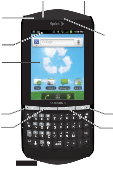
8. Lock/POWER Key
9. Earpiece
10. SEARCH Key
11. BACK Key
voice message, prompting you to call your voicemail.![]()
2. Status Bar Icons provide information about your device’s status and options, such as signal strength, roaming, ringer setting, messaging, signal strength, and battery charge.
3. Display Screen displays all the information needed to operate your device, such as the call status, the Contacts list, and the date and time.
4. MENU Key allows you to access your device’s main functions menu: Add, Wallpaper, Settings, Switch ID, Search, Manage apps, and Notifications. While in a menu, touch to open a list of actions available from the current screen or onscreen option.
• During an active call, press to open additional call options.
5. HOME Key returns you to the Home screen. Press and hold to open the recently-used applications window.
2A. Device Basics 13
6. Microphone allows other callers to hear you clearly when you are speaking to them.
7. Proximity Sensor detects how close an object is to the surface of the LCD. This is typically used to detect when your face is pressed up against the LCD, such as during a phone call.
8. Lock/POWER Key lets you turn the device on or off, end a call, or turn off the LCD.
• When the screen is turned off, press once to return to Screen lock mode.
• While the device is unlocked and not on an active call, press and hold to display the Phone options menu (Silent mode, Airplane mode, Power off).
9. Earpiece lets you hear the caller and automated prompts.
10. SEARCH Key displays the Quick Search box that can be used to search for a key term both on the phone or online. It’s the ultimate search field (page 25).
• For example, entering the word “Pa”, will display any matching entries from your device’s Contacts list, current device applications, online Android/ Google apps, or from any online Web page via Google search.
• Press and hold to launch Voice Search where you can initiate a Google™ search by verbally entering a text string. The device recognizes your spoken words and initiates a Web search.
11. BACK Key deletes characters from the display in text entry mode. When in a menu, pressing the Back key returns you to the previous menu, closes a dialog box, or exits an onscreen menu/option.
12. External Speaker lets you hear the different ringers and sounds. You can mute the ringer when receiving incoming calls by pressing the volume button. The speaker also lets you hear the caller’s voice in speakerphone mode.
13. Camera Lens, as part of the built-in camera, this
2.0 megapixel camera lets you take pictures and videos.
14 2A. Device Basics
14. Volume Button allows you to adjust the ringer volume in standby mode, the voice volume during a call, and media playback volume.
15. Voice Dialer allows you to launch the built-in automatic speech recognition (ASR) software.
16. Camera Button lets you activate the camera and camcorder and take pictures and videos.
17. Headset Jack allows you to plug in an optional headset for convenient, hands-free conversations. CAUTION! Inserting an accessory into the incorrect jack may damage the device.
18. microSD Card Slot lets you use a microSD card to expand the memory of your phone.
19. Charger/Accessory Jack allows you to connect the phone charger or a USB cable (included). CAUTION! Inserting an accessory into the incorrect jack may damage the device.

14. Volume
Button
![]()

15. Voice Dialer
16. Camera
Button
17. Headset Jack
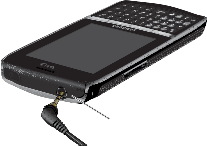
2A. Device Basics 15
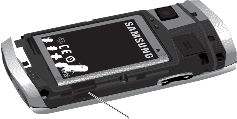

Keyboard Features
20. QWERTY Keyboard
21. Fn Key
22. Shift
Key
23. Smiley Key
26. Delete Key
25. Enter
Key
24. Space/SYM Key
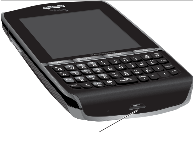
18. microSD Card Slot
20. QWERTY Keyboard provides an alphanumeric character keyboard layout. Lets you enter numbers, letters, and characters, as well as navigate within menus.
21. fn Key (Function) key ![]() , toggle to access the numbers/symbols atop each key on the QWERTY keyboard.
, toggle to access the numbers/symbols atop each key on the QWERTY keyboard.
22. Shift Key lets you toggle alphabet characters between mixed case, uppercase and lowercase. Character case remains as selected until the Shift key is pressed again.
19. Charger/Accessory Jack
16 2A. Device Basics
23. Smiley Key (when used with the ![]() key) lets you access Smiley icons (Emoticons).
key) lets you access Smiley icons (Emoticons).
24. Space/SYM Key lets you add spaces between words and characters.
25. Enter Key lets you enter additional lines of text.
26. Delete Key deletes characters from the display in text entry mode.
Viewing the Display Screen
![]()
![]()
![]()
Your device’s display screen provides information about your device’s status and options. This list identifies the symbols you’ll see on your device’s display screen:
Status Bar – Service Icons | |
| Airplane Mode On – Your device will not make or receive calls, or provide data access. Local applications are still available. |
| Roaming – Your device is “roaming” off the Nationwide Sprint Network. |
| 3G Available – Sprint 3G data service is active. |
| 3G Communicating – Sprint 3G data service is active and communicating. When active, the icon is animated. |
![]()
Status Bar – Status Icons
Call in Progress – A voice call is in progress. Audio is routed through either the earpiece or external speaker.
Bluetooth Call in Progress – A voice call is being routed through a Bluetooth headset.
Missed Call – You have missed an incoming call.
Call Muted – The device microphone has been muted.
![]()

2A. Device Basics 17
Status Bar – Status Icons
![]()
Wi-Fi Connected – Wi-Fi is connected, active, and communicating with a Wireless Access
Point (WAP).
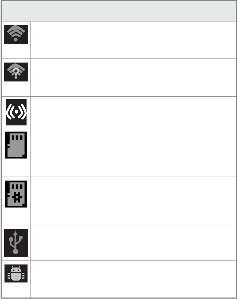
![]() Wi-Fi Connection Issue – Wi-Fi is active but there
Wi-Fi Connection Issue – Wi-Fi is active but there
is a communication issue with the target
![]() Wireless Access Point (WAP).
Wireless Access Point (WAP).
Sprint Hotspot Active – The Sprint Hotspot
![]() feature has been activated (page 154).
feature has been activated (page 154).
microSD Unmounted – The External SD card
(internal microSD) has been disconnected
(unmounted) from the device and is now ready ![]() for either removal or formatting.
for either removal or formatting.
![]()
Preparing for Mounting – The External SD card
is being prepared for mounting to the device. This is required for communication with the External SD card.
![]()
USB Connection – The device has detected an active USB connection.
USB Debug Connection – The device has
![]() detected an active USB connection and is in a
detected an active USB connection and is in a
USB Debugging mode.
18 2A. Device Basics
Status Bar – Status Icons | |||
| Sign-in/Sync Error – There has been an issue with your connection to the Google server, or you were not properly signed into your account. In order to use Google application or sync features, you must set up and sign into an active Google account. | ||
| Silence All – All incoming sounds are turned off. | ||
| Vibrate Only – The ringer is set to vibrate only. | ||
| Data Synchronization – Application sync is active and synchronization is in progress for Gmail™, Calendar, and Contacts. | ||
| Android OS Update Available – A new Android operating system update is available for download. | ||
| System Updates Available – A new system update is available for download. | ||
| Files Downloading – The device is downloading selected files. | ||
| Download Successful – A recent software download was successfully downloaded. |
![]()
![]()
![]()
![]()
![]()
![]()
![]()
![]()
2A. Device Basics 19
Turning Your Device On and Off
![]()
Turning Your Device On
� Press and hold ![]() .
.
Once your device is on, it may display “Searching for Service.” When your device finds a signal, it enters standby mode – the device’s idle state. At this point, you are ready to begin making and receiving calls.
If your device is unable to find a signal after 15 minutes of searching, a Power Save feature is automatically activated. When a signal is found, your device automatically returns to standby mode.![]()
In Power Save mode, your device searches for a signal periodically without your intervention. You can also initiate a search for Sprint service by pressing any key (when your device is turned on).
Tip: The Power Save feature conserves your battery power when you are in an area where there is no signal.
Turning Your Device Off
1. Press and hold ![]() for two seconds until you see the Phone options menu.
for two seconds until you see the Phone options menu.
2. Tap ![]() Power off and then tap OK to power off the device.
Power off and then tap OK to power off the device.
Your screen remains blank while your device is off
(unless the battery is charging).
Battery and Charger

![]()
WARNING: Use only Sprint-approved or Samsung-approved batteries and chargers with your device. The failure to use a Sprint-approved or Samsung- approved battery and charger may increase the risk that your device will overheat, catch fire, or explode, resulting in serious bodily injury, death, or property damage.
Sprint-approved or Samsung-approved batteries and accessories can be found at Sprint Stores or through Samsung; or call 1-866-866-7509 to order. They’re also available at www.sprint.com.
20 2A. Device Basics
Battery Capacity
Your device is equipped with a Lithium Ion (Li-Ion) battery. It allows you to recharge your battery before it is fully drained. The battery provides up to 6.0 hours of continuous digital talk time and 230.0 hours of standby time.
At 5% of charge capacity, there are only a few minutes of talk time left, the device sounds an audible alert, displays a critical charge icon ( ), and then turns off.
Note: Long backlight settings, searching for service, vibrate mode, browser use, and other variables may reduce the battery’s talk and standby times.
Tip: Watch your device’s battery level indicator and charge the battery before it runs out of power.
Installing the Battery
� See “Setting Up Your Device” on page 2.
Removing the Battery
1. Make sure the power is off so that you don’t lose any stored numbers or messages.
2. Grasp the device firmly, locate the cover release latch, and then place your fingernail in the opening and firmly “pop” the cover off the device.
![]()
3. Carefully remove the battery from the device.
![]()
WARNING: Do not handle a damaged or leaking Li-Ion battery as you can be burned.
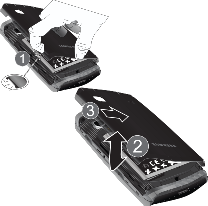
2A. Device Basics 21
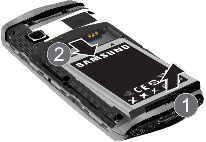
Incorrect
Charging Head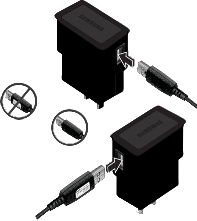
USB Cable
Charging the Battery
![]()
Keeping track of your battery’s charge is important. If your battery level becomes too low, your device automatically turns off, and you will lose any information you were just working on.
Note: Although the battery comes partially charged. It is recommended you fully charge the battery before using your device for the first time.
1. Connect the USB cable to the charging head.
Correct
2. Insert the USB cable into the device’s charger/
accessory jack.
3. Plug the charging head into a standard AC power outlet.
22 2A. Device Basics
Correct
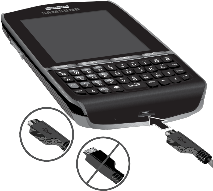
Incorrect

� Plug the flat end of the charger into the device’s charger jack and the other end into an electrical outlet. The device turns on in with the screen locked and indicates both its charge state and percent of charge.
![]()
WARNING: While the device is charging, if the touch screen does not function due to an unstable power supply unplug the USB power adapter from the power outlet or unplug the USB cable from the device.
With the Sprint-approved Li-Ion battery, you can recharge the battery before it becomes completely run down.
Extending Your Battery Life
Active applications, light levels, Bluetooth usage, and
GPS functionality all act to drain your battery. The
Always use a Sprint-approved or Samsung-approved
desktop charger, travel charger, or vehicle power adapter to charge your battery.
following is a list of helpful tips that can help conserve your battery power:
e Reduce your backlight on time. See “Changing the
Backlight Time Length” on page 62.
e Turn Bluetooth off when not is use. See “Turning
Bluetooth On and Off” on page 124.
2A. Device Basics 23
e Turn Wi-Fi off when not is use. See “Turning Wi-Fi On and Off” on page 152.
e Deactivate the GPS when not needed. Most applications using this function will periodically query the GPS satellites for your current location; each query drains your battery. See “Activating Location Mode” on page 184.
e Do not wait until your battery is completely depleted before charging your device. Repeating this process of a complete discharge and recharge can over time reduce the storage capacity of any battery.
e Turn off Automatic application sync. See
“Synchronizing Accounts” on page 65.
e Use the Power Control Widget to deactivate hardware functions such as Wi-Fi, Bluetooth, GPS, Synchronization, or LCD brightness setting.
e Check the Running Services and close any unnecessary applications.
Device Function Keys
![]()
The Samsung Replenish™ offers four main function keys that can be used on any screen to provide added functionality.
Menu Key
The Menu key ( ![]() ) activates an available menu function for the current screen or application. When on the Home screen, the following menu options are available:
) activates an available menu function for the current screen or application. When on the Home screen, the following menu options are available:
• Add ( ![]() ) adds one of the following functions to a selected screen: Widgets, Shortcuts, Folders, and Wallpapers. (See “Customizing Your Home
) adds one of the following functions to a selected screen: Widgets, Shortcuts, Folders, and Wallpapers. (See “Customizing Your Home
Screen” on page 35.)
• Wallpaper ( ![]() ) lets you to customize the current screen’s wallpaper image. You can obtain this image from either your Pictures folder, from any of the available images within the device’s
) lets you to customize the current screen’s wallpaper image. You can obtain this image from either your Pictures folder, from any of the available images within the device’s
Wallpaper gallery, or from the animated Live Wallpapers. (See “Changing the Display Screen” on page 63.)
24 2A. Device Basics
• Settings ( ![]() ) provides quick access to the device’s settings menu. (See “2C. Settings” on page 59.)
) provides quick access to the device’s settings menu. (See “2C. Settings” on page 59.)
• Switch ID ( ![]() ) allows you to customize your
) allows you to customize your
Sprint ID.
• Search ( ![]() ) displays the Google Search box that you can use to search for a key term both on the phone and online. (See “Search Key” on
) displays the Google Search box that you can use to search for a key term both on the phone and online. (See “Search Key” on
page 25.)
● For example, entering the word “Pa” will display any matching entries from your device’s Contacts list, current device applications, online Android/Google apps, or from any online Web page via Google search.
• More ( ![]() ) allows you to manage applications and notifications:
) allows you to manage applications and notifications:
● Manage apps lets you manage your running applications.
● Notifications allows you to open the notifications panel to provide more detailed information about the current onscreen notification icons. (See “Using the Notifications Panel” on page 41.)
Home Key
The Home key ( ![]() ) takes you back to your Home screen (#3 of the 5 total available screens).
) takes you back to your Home screen (#3 of the 5 total available screens).![]()
Back Key
The Back key ( ![]() ) returns you to the previously active screen. If the onscreen keyboard is currently open, this key closes the keyboard.
) returns you to the previously active screen. If the onscreen keyboard is currently open, this key closes the keyboard.
Search Key
The Search key ( ![]() ) displays the Google Search box that can be used to search for a key term both on the device and online. In some instances, this key opens a search box specific only to the current application.
) displays the Google Search box that can be used to search for a key term both on the device and online. In some instances, this key opens a search box specific only to the current application.
2A. Device Basics 25

Using Your Device to Search
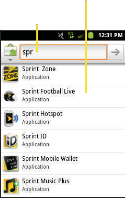
Use the Google Search box to manually search for a term on both your
Search Results
(Device & Web)
Search Options
Search Field
Voice Search
device and on the Web.![]()
1. Press to
Quick Search
Box
(All/Web/Apps/Contacts)
• Press ![]() to launch the Google Search box.
to launch the Google Search box.![]()
– or –
Press ![]() and tap >
and tap > ![]() .
.
• Touch and hold to launch the Voice Search
function.
launch the Google
Search box.
2. Tap ![]() to select a search area.
to select a search area.
• All searches your device, the Web, Contacts, and the Android Market for your search term.
• Web searches for your term only on the Web using the Google search engine.
• Apps searches for your term only within the
Android Market.
26 2A. Device Basics
• Contacts searches for your term only within your current Contacts entries.
![]()
● Search preferences and settings can be configured to display suggestions in a different manner. (See “Search Settings” on page 69.)
Note: To hide the onscreen keyboard and see more of your | ||
search matches, press | . |
3. Tap a match from the list of suggestions, phone search results, or previously chosen search matches. Once touched, the item opens in the appropriate application.
– or –
Touching Voice Search ( ![]() ) lets you speak into
) lets you speak into
your device's microphone to enter a search term.
To search the device and Web by entering text:
1. Press ![]() to launch the Google Search box.
to launch the Google Search box.
2. Use the onscreen keyboard to enter your search term. (See “Entering Text Using the Onscreen Keyboards” on page 42).
As you type, matching items on your device and matches from Google’s Web search are added to the onscreen list of previously chosen search results.![]()
• Search preferences and settings can be configured to display suggestions in a different manner. (See “Search Settings” on page 69.)
Note: To hide the onscreen keyboard and see more of | ||
your search matches, press |
| . |
3. Tap a match from the list of suggestions, phone search results, or previously chosen search matches. Once touched, the item opens in the appropriate application.
To search the device and Web via Voice Search:
![]()
1. Press ![]() and touch
and touch ![]() (microphone icon on the side of the Google Search box).
(microphone icon on the side of the Google Search box).
Note: Touching in an application’s search box, searches the application by voice, not the Web.
2. From the open dialog, say what you want to search for.
3. Once complete, the Voice Search application analyzes your spoken words and displays a list of matching keyword terms.
2A. Device Basics 27
Note: It is recommended that you use this feature in a quiet room. Loud ambient or background noises can confuse the application and result in inaccurate search results.

To use additional Voice Search functions:
From an open Voice Search dialog, speak the following words to access additional features:
• voice actions allows you to search the web by speaking the search parameters.
• send text allows you to open the Messaging screen.
• navigate to allows you to receive directions via Google maps™. Use either an Address name, Business name, business type, or other navigation information to get the desired directions.
• call allows you to open the phone dial and automatically
• send email allows you to open your email account and compose a new email message.
• map of allows you to view a map of an area via Google maps. Use either an Address name, Business name, zip code, or other navigation information.
• go to allows you to navigate to any component of your device.
• note to self allows you to search for a note save to your Memo Pad.
• directions to allows you to receive a list of websites that contain the spoken address via Google™. Use an Address name for the desired result list.
Navigation and Customization
![]()
![]()
The Samsung Replenish™ is a touch-sensitive device which allows you to not only select an onscreen option with a single tap, but also scroll through long menu lists.
Tip: Some menu options are also accessed by pressing and holding an onscreen item, such as a Contact entry from the Contacts tab.
28 2A. Device Basics
Home Screen Overview
The Home screen is the starting point for many applications and functions, and it allows you to add items like application icons, shortcuts, folders, or widgets to give you instant access to information and applications.
This is the default page and accessible from any menu by pressing ![]() .
.
e Status bar: located at the top of the screen, displays
both Notification and Status icons.
e Notification area: displays icons associated with end-user notifications such as: email messages, calls (missed, call in progress), new voicemail, upcoming event, USB connection, emails, and Text/MMS messages. (See “Using the Notifications Panel” on page 41.)
• These notifications appear at the top-left of the screen (within the Status bar) and display important user information.
• This information can be accessed by either swiping down from the Status bar (page 41) or by
accessing the Notifications by pressing ![]() >
> ![]() >
> ![]() > Notifications.
> Notifications.
![]()
e Status area: displays icons associated with the status of the device such as communication, coverage, Bluetooth, 3G and Wi-Fi communication, battery levels, GPS, etc.
e Main Home Screen: a customizable screen (3) that provides information about notifications and device status, and allows access to application Widgets.
e Extended Home Screens: the device’s screen extends beyond the current visible screen width to provide more space for adding icons, widgets, and more.
• There are five available screens, each populated with its own default shortcuts or widgets. Each of these screens can be customized and the current screen is indicated at the top by a larger numeric circle.
2A. Device Basics 29
• Press ![]() to access the main Home screen (3) which appears as the default “page” on the device and then slide your finger horizontally across the screen to go to the left or right extended screens. There are four "additional" screens apart from the main Home screen, two on the left and two on the right.
to access the main Home screen (3) which appears as the default “page” on the device and then slide your finger horizontally across the screen to go to the left or right extended screens. There are four "additional" screens apart from the main Home screen, two on the left and two on the right.![]()
• Think of it as having a desktop so wide that your screen can only display a portion at a time.
![]()
Note: The Status bar is visible across all Home screens.
![]()
Note: Screen #3 is the Home screen.
Note: Both the status bar and primary shortcuts are visible across all screens (Home and Extended).
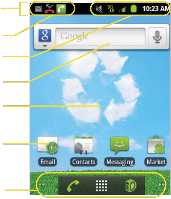
Status bar
Notification area
Status area
Google search
Main Home
Screen
Shortcuts
![]() Primary Shortcuts
Primary Shortcuts
e Google search: is an onscreen Internet search engine powered by Google™. Touch ![]() to access the
to access the
Voice Search feature where you can verbally enter a
search term and initiate an online search.
30 2A. Device Basics
e Widgets: self-contained onscreen applications (not shortcuts). These can be placed onto any of the available screens (Home or extended). (See “Adding and Removing Widgets” on page 38.)
e Shortcuts: are icons that launch available device applications such as Voicemail, Contacts, Phone, Email, Alarm Clock, etc. These function the same as shortcuts on your computer.
• Although some may already be found on the Extended Home screens, the majority can also be found within the Applications screens.
• The Application screens can be accessed by
tapping Applications ( ![]() ) from the Primary shortcuts area.
) from the Primary shortcuts area.
• Shortcuts can be removed from a screen and added back any number of times. (See “Creating Shortcuts” on page 35.)
e Primary Shortcuts: are three shortcuts present throughout all of the available screens (all 5) and can be used to both navigate within the device or launch any of the following functions:
• Phone ( ![]() ) launches the phone-related screen
) launches the phone-related screen![]()
functions (Phone, Call Log, Contacts, and
Favorites).
• Applications/Home toggles functionality between the Home and Application screens.
● Tap Applications ( ![]() ) to access the
) to access the
Application screens loaded with every
available local application.
● While in the Applications screen, tap the Home icon (![]() ) to easily return to the Home screen.
) to easily return to the Home screen.
• Sprint ID ( ![]() ) lets you quickly change the ID
) lets you quickly change the ID
packet you're currently using. Touch Get New to
download and install a new ID.
2A. Device Basics 31
e Page Navigation is a visual indication of the currently active page. The onscreen dots (located at the bottom left and right of the screens) indicate your current page location.
• When on the Home screen, two dots appear at both locations (this indicates there are two pages at either side of the current page).
• Touch and hold ![]() to reveal the Quick Screen
to reveal the Quick Screen
Access. Tap a preview to launch the selected
screen.
Using the Applications Screens
All of your device’s applications are located within the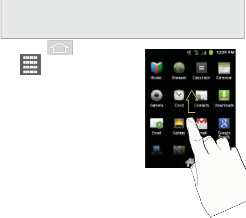
![]()
Applications screens.
Note: These screens house all default and downloaded applications (installed from Android Market or from the Web).
1. Press and tap
to open the screen.
• To close the Applications screen, tap or press .
2. Scroll through the screens and tap an icon to launch the associated application.
• The screens contains device applications such as Contacts, Calendar, Camera, Gmail, Messaging, Sprint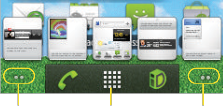
Pages on left
Quick Screen Access
(touch and hold)
Pages on right
Hotspot, Sprint ID, and many more.
32 2A. Device Basics
Applications
![]()
![]()
![]()
![]()
![]()
![]()
![]()
The following is a listing of the current applications available via both the Primary shortcuts area and via the Applications screens.
Application Icons | |||
Books – Allows you to purchase and download ebooks from the Google ebooks Website. | |||
Books – Allows you to purchase and download ebooks from the Google ebooks Website. | |||
Books – Allows you to purchase and download ebooks from the Google ebooks Website. | |||
| Browser – Launches the Sprint Powerdeck browser (page 146). | ||
| Calculator – Launches the onscreen calculator application (page 100). | ||
| Calendar – Launches the Calendar applications that syncs itself to either your Google or Outlook® Work calendar (page 93). Events can only be synched to a managed account (page 93). | ||
| Camera – Launches the built-in camera (page 116). | ||
| Clock – Accesses the Clock application (page 98). |
![]()
![]()
![]()
2A. Device Basics 33
Application Icons | |
| Maps – Launches a Web-based dynamic map that helps you find local businesses, locate friends, view maps and get driving directions (page 184). |
| Market – Find and download free and for- purchase applications on Android Market (page 170). |
| Messaging – Provides access to text and multimedia messaging (SMS and MMS) (page 133). |
| Music – Launches the built-in Music Player (page 179). |
| My Files – Launches a file browser that allows you to view only supported image files and text files. |
| Navigation – Uses your current location to provide various location-based services (page 186). |
| News & Weather – Launches a Web-based news and weather feed based on your current location. |
![]()
![]()
![]()
![]()
![]()
![]()
![]()
34 2A. Device Basics
![]()
Note: The Email application includes access to both Exchange Server-based email (also known as Work email) and other Internet-based email providers such as Yahoo! and Gmail.
![]()

![]() Customizing Your Home Screen
Customizing Your Home Screen
You can customize your Home screen by doing the
following:
![]() e Creating Shortcuts
e Creating Shortcuts
e Adding and Removing Widgets
e Repositioning Widgets
e Creating Folders
![]() e Changing the Background (Wallpapers)
e Changing the Background (Wallpapers)
Creating Shortcuts
Shortcuts activate a feature or launch an application. ![]() Widgets are already open and active onscreen
Widgets are already open and active onscreen
applications.![]()
2A. Device Basics 35
Note: To move a shortcut from one screen to another, you must carefully touch and hold the shortcut and slowly drag it to the edge of the screen. As the shortcut enlarges, you can begin to move it to the adjacent screen.
If this does not work, delete it from its current screen. Activate the new screen and then add the selected shortcut.

To add a shortcut from the Applications screens:
1. Press ![]() to activate the Home screen.
to activate the Home screen.
2. Select a location (screen) for your new shortcut by scrolling across your available screens until you reach the desired one. (See “Home Screen Overview” on page 29.)
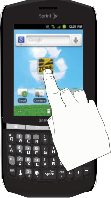
3. Tap Applications ( ![]() )
)
to reveal all your current
available applications. By default, applications are listed in a Grid view.
4. Scroll across the screens and locate your desired application.
5. Touch and hold the onscreen icon. The new shortcut then appears to hover over the current screen.
6. While still holding the onscreen icon, position it on the current screen.

Once complete, release the screen to lock the shortcut into its new position.
Note: The same shortcut can be added to any of the available screens (Home or Extended). The application you add to the screen will still appear within the Applications screens.
36 2A. Device Basics
To add a shortcut via the Add to Home screen:
1. Press ![]() to activate the Home screen.
to activate the Home screen.
2. Touch and hold on an empty area of the screen.
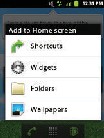
3. From the Add to Home screen window tap Shortcuts.
4. Tap a selection from the available list:
• Applications
• Bookmark
• Contact
• Direct dial
• Direct message
• Directions & Navigation
• Gmail label
• Music playlist
• Settings
5. Follow the onscreen instructions to add the new shortcut to your current Home screen.
To delete a shortcut:
1. Press ![]() to activate the Home screen.
to activate the Home screen.
2. Touch and hold the desired shortcut. This unlocks it from its location on the current screen.
3. Drag the icon over the
Delete tab ( ![]() ) and release it.
) and release it.
![]()
Delete (Shortcut or Widget)
2A. Device Basics 37
Adding and Removing Widgets
Widgets are self-contained applications that can be placed on either the Home screen or an extended screen. Unlike shortcuts, widgets appear as onscreen applications.
e Widgets
• Choices include: Analog Clock, Calendar, Google Search, Home screen tips, Latitude, Market, Music, News & Weather, Picture frame, Power Control, Rate Places, Traffic, Tutorials #1-5, and YouTube.
To add a Widget:
1. Press ![]() to activate the Home screen.
to activate the Home screen.
2. Touch and hold on an empty area of the screen.
3. From the Add to Home screen window tap Widgets.
4. Tap an available widget to place it on your current screen.
To remove a Widget:
1. Touch and hold a widget until you can move it around on the screen.
2. Drag the widget over the Delete tab ( ![]() ) and release it.
) and release it.
• As you place the widget into the Trash, both items turn red.
• This action doesn’t delete the widget, it just removes it from the current screen.
To place a Widget onto a different screen:
1. Touch and hold the widget until it becomes enlarged.
2. Drag it to the edge of your screen.
3. Slowly drag it past the edge of the screen until it enlarges.
4. Add the widget to the new screen.
5. Repeat these steps to continue moving it to other adjacent screens.
Creating and Managing Folders
Folders are located on any of the five available screens and contain both files (such as data and images) and Contact or entries.
To create a folder onscreen:
1. Press ![]() to activate the Home screen.
to activate the Home screen.
2. Touch and hold on an empty area of the screen.
38 2A. Device Basics
3. From the Add to Home screen window tap Folders.
4. Tap an available folder type to place it on your current screen.
![]()
• Choices include New folder, All contacts, Bluetooth received, Contacts with phone numbers, Google Contacts, Recent documents, and Starred contacts.
Note: Starred contacts are those Contact entries tagged as very important.
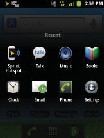
Accessing Recently- Used Applications
Your device keeps a running list of your eight most recently used applications.
1. Press and hold ![]() to open the recently-used applications window.
to open the recently-used applications window.
2. Tap an icon to open an application.
Changing the Screen Orientation
![]()
The Samsung Replenish™ is capable of automatically changing the orientation of some onscreen content. The device’s built-in accelerometer senses movement and changes its angle/orientation.
This allows the device to change the onscreen content (images, video, Web pages) to properly display based on the current angle (some screens may not automatically change).
2A. Device Basics 39

Portrait View
Landscape View
To manually activate the auto-rotate feature:
1. Press ![]() >
> ![]() >
> ![]() > Display settings.
> Display settings.
– or –
Press ![]() and tap
and tap ![]() >
> ![]() > Display settings.
> Display settings.
2. Scroll down and tap Auto-rotate screen. A checkmark indicates the feature is enabled. (See “Changing the Screen Orientation” on page 62.)
• Clear the Auto-rotate screen checkmark to disable this automatic orientation adjustment.
Selecting Menu Items
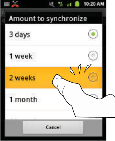
As you navigate through the menu, you activate menu options by tapping the onscreen entry. Select any option by tapping it.
1. Tap an onscreen icon to launch a menu or feature.
2. Flick up or down the screen to navigate through a menu list (bottom up or top down).
40 2A. Device Basics
3. Tap a menu item to make a selection or activate a field.
To launch the keypad:
� Tap ![]() from the Home screen.
from the Home screen.
Using Context Menus
Context menus (also called pop-up menus) contain options that apply to a specific item on the screen. They function similarly to menu options that appear when you right click your mouse on your desktop computer.
� Touch and hold an item onscreen to open its context menu.
![]()
Note: Not all items have context menus. If you touch and hold an item that has no context menu, nothing happens.
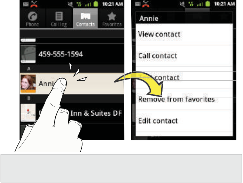
Using the Notifications Panel
The Notification area indicates new message events (data sync status, new messages, calendar events, call status, etc). You can expand this area to provide more detailed information about the current onscreen notification icons.
2A. Device Basics 41
4. Tap the status bar to reveal the Notifications tab,
Displaying Your Phone Number
and then drag the tab to the bottom of the screen ![]()
![]()
![]()
to open the Notifications panel (1).![]()
5. Tap a notification entry to open the associated application (2).
Note: The Notifications panel can also be opened on the Home screen by pressing > > Notifications.
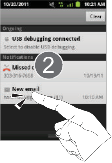
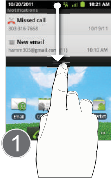
42 2A. Device Basics
� Press > > > About phone >
Status. (Your phone number and other information about your device and account is displayed.)
Entering Text Using the Onscreen
Keyboards
![]()
When you activate a field where you can enter text, numbers, symbols, etc., you can either use the onscreen keyboard or QWERTY keyboard.
Onscreen keyboard entry can be used only in Landscape orientation. The Landscape orientation provides more space and results in slightly bigger onscreen keys. If you prefer to enter text using larger keys, use this orientation.
Activating the Landscape Keyboard
Although the device can also be set to automatically change its orientation to Landscape once the phone is rotated, Samsung Replenish™ can also be set to automatically change its orientation. To use the onscreen keyboard in Landscape mode, this feature must first be enabled.
See “Changing the Screen Orientation” on page 62.
Selecting a Text Input Mode
Your device provides convenient ways to enter letters, numbers, and symbols whenever you are prompted to enter text (for example, when adding a Contacts entry or when using email and text messaging).![]()
In this section we’ll cover the steps necessary to enter text using the onscreen keyboard, where the touch screen is the primary method of both text and character entry.
Note: Some characters and types, such as some symbols and Emoticons, are not accessible from the onscreen keyboard.
1. From a screen where you can enter text, tap the input field to reveal the onscreen keyboard.
2. Select one of the following Text mode options:
![]()
• ABC to use alphabetic characters from the onscreen keyboard (See page 45.)
![]()
• ?123 to enter numbers by pressing the numbers on the onscreen keyboard. (See page 45.)
Tip: When entering text, tap to change letter capitalization.
• Voice Input allows the device to use its built-in voice recognition software to hear your voice and transcript it directly into text.
To change the input method:
1. From an active text input screen, touch and hold a text input field.
2. Select Input Method from the onscreen context menu.
Onscreen Keyboard Overview
e Entry field: a field where text, number, or other characters can be entered.
2A. Device Basics 43

Text Entry
Complete
Entry field
Suggested words
Delete
Caps/ALT
Text mode Voice Input Enter
When in ?123 mode, this key can show additional symbol characters.
• Capitalization in Abc mode can be altered by using the Caps button. See “ABC Mode” on page 45.
• Symbol used in ?123 mode can be enhanced by accessing additional symbol characters. See “Entering Numbers and Symbols” on page 45.
e Text mode: There are two available modes; ABC and
?123.
![]()
• ABC mode contains only characters. Text mode button indicates ?123 .![]()
• ?123 mode contains only symbols. Text mode button indicates ABC .
e Voice Input mode: Tapping this button activates the
e Suggested Word choices: a row of selectable word choices based on the current set of entered text. Tap an onscreen choice to insert the selection into your text entry field at the current cursor position.
e Delete: deletes characters from the entry field.
e CAPS/ALT: When in ABC mode, this key changes the capitalization of the subsequent entered characters.
built-in microphone and voice recognition software.![]()
• Speak clearly into the microphone. When complete, your spoken words are recognized, converted to text, and inserted into your current cursor position.
Note: It is recommend that to avoid incorrect conversions, you use this feature in an area relatively free from background noises.
44 2A. Device Basics
ABC Mode
In ABC mode, you can enter only alphabetic![]()
characters from the onscreen keyboard. The text mode shows ?123 .
1. Select the ABC mode. (See “Selecting a Text Input
Mode” on page 43.)
• Capitalization in ABC mode can be altered by using the Caps button.![]()
next character is lowercase.
only the next character is uppercase.![]()
all subsequent characters are uppercase.
Note: A green circle on the shift key above indicates the keyboard is set to “Shift-Lock” where all characters are entered in uppercase.
![]()
2. Tap the corresponding onscreen keys to begin typing your word.
• If you make a mistake, tap to erase a single character. Touch and hold to erase an entire word.)
By default, the first letter of an entry is capitalized and the following letters are lower case. After a character is entered, the cursor automatically advances to the next space after two seconds or when you enter a character on a different key.![]()
Entering Numbers and Symbols
![]()
In ?123 mode, you can only enter symbols characters from the onscreen keyboard. The text mode shows
ABC .
To enter numbers:
![]()
1. Tap ABC to enter the ?123 mode.
2. Tap the appropriate numeric key. (See “Selecting a
Text Input Mode” on page 43.)
To enter symbols:
![]()
1. Tap ABC to enter the ?123 mode.
2. Tap the appropriate numeric key.
– or –![]()
![]()
Tap ALT to select from additional symbol characters. The key shows ALT when the additional character set is active.
2A. Device Basics 45
Entering Text Using the QWERTY Keyboard
![]()
Accessing the QWERTY Keyboard
The Samsung Replenish™ has a built-in, keyboard- style keypad, referred to as a full QWERTY keyboard. The keyboard is located beneath the display screen.
Using the QWERTY keyboard, you can type letters, numbers, punctuation, and other special characters into text entry fields or other applications simpler and faster than using the onscreen keyboard.
To reveal additional QWERTY text editing options:
1. Touch and hold the text entry field.
2. From the Edit text context menu, tap an available function:
• Select all highlights all characters in the text message field.
• Select word lets you manually highlight characters in the text message field.
• Cut deletes the selected characters in the current text message field.
• Copy copies selected characters in the current text message field.
• Paste inserts the previously copied text into the message field.
• Input method provides additional text input methods. The default is Android keyboard.
• Add XXX to dictionary adds the currently highlighted word to your device’s dictionary.
46 2A. Device Basics
Using the Keyboard
In this section we’ll cover the steps necessary to enter text using the QWERTY keyboard. Using your device's QWERTY keyboard is just like using any standard computer keyboard.![]()
![]()
![]()
![]()
![]()
![]()
The following keys perform special functions when entering text:
Delete: Deletes the previous character, similar to the backspace key on a computer keyboard.
![]()
![]()
From a text entry screen, use the keyboard to enter different character types. Select one of the following character types:
• Letters to enter the alphabetic characters associated with each key. (See page 48.)
• Numbers to enter numbers by pressing the numbers on the keyboard. (See page 48.)
• Symbols to enter symbols. (See page 49.)
![]()
• Smileys to enter smileys or “Emoticons.” (See page 49.)
Tip: When entering text, press to change letter capitalization (ABC > Abc > abc).
The keyboard provides dual-use keys labeled with alphabetic characters on the lower half and numbers and symbols on the upper half. Press the key corresponding to the character you want to enter.
2A. Device Basics 47
Entering Characters
The entered character (of a field or new sentence) is always an initial uppercase letter. By default, text is entered in lowercase characters unless altered by pressing ![]() .
.
To enter uppercase and lowercase characters:
![]()
1. Press to make the next character uppercase.
Characters revert back to lowercase after the next character is typed.
– or –
Press ![]() twice to make all subsequent characters uppercase (all new characters are in uppercase).
twice to make all subsequent characters uppercase (all new characters are in uppercase).
• Pressing ![]() cycles through the capitalization modes (all lowercase, initial uppercase, and all uppercase).
cycles through the capitalization modes (all lowercase, initial uppercase, and all uppercase).
2. Press the corresponding keys:
• For example, to enter the word “Bill” within a text field, type the keypad sequence below.
![]()
• If you make a mistake, press to erase a single character. Press and hold to erase all previously entered text.
![]()
![]()
B i l l

• To enter all uppercase characters, quickly press twice.
![]()
B I L L
Entering Numbers
The keyboard can be used to enter numbers, letters, and symbols. The number keys are located along the top on the QWERTY keyboard.
1. Press the numeric key corresponding to your desired number choice.
48 2A. Device Basics
![]()
• If you make a mistake, press to erase a single character. Press and hold to erase all previously entered text.
• For example, to enter “9:30,” you would use the keyboard sequence shown below.
![]()
![]()
![]()
![]()
![]()
![]()
![]()
![]()
9 : 3 0
Symbols and Smileys
Symbols are accessed by combining the ![]() key with the correct number key.
key with the correct number key.
Smileys (Emoticons) are accessed by pressing ![]() and then selecting an image from the Insert Smiley page that is then inserted at your current cursor position.
and then selecting an image from the Insert Smiley page that is then inserted at your current cursor position.
To enter symbols:
![]()
1. Position the cursor where you want the symbol to appear within your message.
2. Press ![]() and then press the key corresponding to the symbol you want to insert.
and then press the key corresponding to the symbol you want to insert.
![]()
![]()
• For example, to enter “I’m #1,” you would use the keyboard sequence shown below.
![]()
![]()
![]()
I’m #1
2A. Device Basics 49
To enter “smileys” (Emoticons):
1. Position the cursor where you want the symbol to appear within your message.
2. Press ![]() >
> ![]() to open the onscreen smiley page.
to open the onscreen smiley page.
3. Scroll through the list and select a smiley by touching the onscreen icon.
Creating a Google Account
![]()
You will need a Google account to access several device features such as Gmail, Google Maps, Google Talk, and the Android Market applications. Before you are able to access Google applications, you must enter your account information. These applications sync between your device and your online Google account.
1. From a computer, launch a Web browser and navigate to www.google.com.
2. On the main page, click Sign-in > Create an account now.
3. Follow the onscreen prompts to create your free account.
4. Look for an email from Google in the email box you provided, and respond to the email to confirm and activate your new account.
Signing In to Your Google Account
1. Launch an application that requires a Google account (such as Android Market or Gmail).
![]()
2. Click Next > Sign in.
Note: If you do not already have a Google account, touch Create and follow the onscreen prompts to create your new account.
3. Touch the Username and Password fields and enter your information.
4. Tap Sign in. Your device communicates with the
Google servers to confirm your information.
5. If prompted, create a new Gmail username by entering a prefix for your @gmail.com email address.
For additional information about synchronizing accounts, see “Synchronizing Accounts” on page 65.
50 2A. Device Basics
2B. Making and Answering
Calls

• Making Calls (page 51)
• Dialing Options (page 52)
• Answering Calls (page 52)
• Missed Call Notification (page 53)
• Calling Emergency Numbers (page 54)
• In-Call Options (page 55)
• Additional Calling Options (page 56)
• Saving a Phone Number (page 56)
• Finding a Phone Number (page 57)
• Dialing From the Contacts List (page 57)
• Speed Dialing (page 57)
• Plus (+) Code Dialing (page 58)
![]()
Making Calls
1. Press and then tap .
2. Enter a phone number using the onscreen keypad and tap ![]() .
.![]()
• If you make a mistake while dialing, touch ![]() to erase the numbers.
to erase the numbers.
Tip: To redial a recent number, press , tap a number from the Call Log list, and press Call.
![]()
You can also place calls from your device by speed dialing numbers from your Contacts (page 57) and using your Logs listings (page 79).
If you exit the current call screen and return to the Home screen, you are visually notified that you are still on an active call by the black bar within the Status bar.
In Call notification 
2B. Making and Answering Calls 51
Dialing Options
e Add wait to insert a hard pause within the number
string (the phone waits for your input). A wait requires
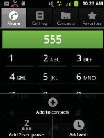
When you enter numbers on the Keypad, you will see three onscreen options.
From the Keypad screen, you have the following options:
e Call (![]() ) to call the entered number.
) to call the entered number.
e Delete (![]() ) to delete digits from the current number.
) to delete digits from the current number.
e Voicemail (![]() ) to access your voicemail messages.
) to access your voicemail messages.
To initiate additional options, tap ![]() and select an option.
and select an option.
e Add to Contacts to add the current number to either a new or existing Contacts entry.
e Add 2-sec pause: to insert a 2-second pause to enter a 2-second delay within a number string (the phone continues dialing after 2 seconds without any additional keys being pressed).
that any consecutive numbers be manually sent by touching Yes.
Answering Calls
![]()

1. Make sure your device is on. (If your device is off, incoming calls go to voicemail.)
Note: All call answering options listed below require you touch and hold the button to activate the function.
When unlocked, some functions can be activated by tapping the onscreen button.
2. Touch and drag to the right to answer an incoming call.

• To decline a call and send it directly to your voicemail, touch and drag to the left.
Note: All incoming call options listed below require you to touch and hold the button to activate the function.
When unlocked, some functions can be activated by tapping the onscreen button.
52 2B. Making and Answering Calls
Tip: To silence the ringer on an incoming call, press either the up or down Volume button.
![]()
Your device notifies you of incoming calls in the following ways:
e The phone rings or vibrates.
e The backlight illuminates.
e The screen displays an incoming call message.
If the incoming call is from a number stored in your Contacts, the entry’s name is displayed. You may also see the caller’s phone number, if available.
Answering a Roaming Call With Call
Guard Enabled
Call Guard is an option that helps you manage your roaming charges when making or receiving calls while outside the Nationwide Sprint Network. (Please see “Roaming” on page 141 for more information.)![]()
� Touch OK to answer the call.
Ending a Call
� Touch and drag ![]() to the left to end the call.
to the left to end the call.
Missed Call Notification
![]()
When you do not answer an incoming call, the Status bar indicates ![]() .
.
To display a Missed Call entry from the Home screen:
![]()
1. Touch and hold the Status bar, and then slide your finger down the screen.
2. Tap the Missed call entry (![]() ). This opens the
). This opens the
Call Log screen.
3. Tap an entry and select Return call.
– or –
Touch and hold an entry from the Call log list and from the context menu, select Call [number]. (See “Using Context Menus” on page 41.)
Note: When your device is off, calls go directly to voicemail.
2B. Making and Answering Calls 53
Calling Emergency Numbers
![]()
You can place calls to 911 (from the Keypad, enter
Enhanced 911 (E911) Information
This device features an embedded Global Positioning
System (GPS) chip necessary for utilizing E911![]()
![]()
![]()
![]()
9 W X Y Z 1 1
), even if your device is
emergency location services where available.![]()
locked or your account is restricted.
Note: When you place an emergency call, your device automatically enters Emergency mode.
During an emergency call, select an option.
e Speaker On to activate speakerphone mode. (If you are in speakerphone mode, the option is displayed as Speaker Off to deactivate.)
e Dialpad/Hide dialpad to show or hide the onscreen dialpad.
e End call to end the current call.

To exit Emergency mode:
� Touch and drag to the left to end a 911 call.
Note: When you end the 911 call, you are returned to the
Emergency Call Back mode.

When you place an emergency 911 call, the GPS feature of your device seeks information to calculate your approximate location.
Note: Depending on several variables, including availability and access to satellite signals, it may take up to 30 seconds or more to determine and report your approximate location.
Important: Always report your location to the 911 operator when placing an emergency call. Some designated emergency call takers, known as Public Safety Answering Points (PSAPs) may not be equipped to receive GPS location information from your device.
Within the Emergency Call Back mode, press the
Home key to use another menu.
54 2B. Making and Answering Calls
In-Call Options
![]()
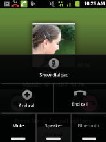
Once you initiate a call, you will see six onscreen options. Tap an option to select it.
e Show dialpad to use the onscreen dialpad to enter additional numbers, for example, an extension or access code.
e Add call touch to initiate a
3-way call (page 140).
e End call to end the current call.
![]()
e Mute to mute the microphone during an active call. Tap again to unmute the microphone.
Note: If Mute is activated, the speaker mode is deactivated.
e Speaker to route the device’s audio through the speaker (On) or through the earpiece (Off).
� Deactivate Speaker to use the device’s earpiece.
e Bluetooth to route the device’s audio through a connected Bluetooth headset (On) or through the speaker (Off). (See “2J. Bluetooth” on page 124.)
![]()
• When the call is routed to a Bluetooth headset, the current call area shows the Bluetooth call icon ( ).
Note: The Headset button is activated to show the current call is routed to the connected Bluetooth headset.
![]()
● To route the current call back to the device, tap Bluetooth to temporarily use the device. Tap it again to route the call back to the connected Bluetooth headset.
• When Bluetooth or the Bluetooth headset is turned off, the call is routed through either the earpiece or speaker and shows ( ).
WARNING: Because of higher volume levels, do not place the device near your ear during speakerphone use.
� Activate Speaker to route the device’s audio
Touch and drag up Dialpad (
Dialpad
) to use the
through the speaker. (You can adjust the speaker volume using the volume buttons.)
onscreen dialpad to enter additional numbers, for
example, an extension or access code.
2B. Making and Answering Calls 55
• For example: When you call your bank’s 800
Saving a Phone Number
number, use your dialpad to enter your account
number and PIN.
Additional Calling Options
![]()
To obtain additional options such as phone number and the duration of the call, you must access the Call log screen. (See “2D. Call Logs” on page 79.)
The number of Contacts entries you can store in your device is limited only by available memory space. Your device automatically sorts the Contacts entries alphabetically. (For more information, see “2E. Contacts” on page 84.)
To save a new number from the Home screen:
![]()
![]()
![]()
1. Press and then tap > Call log .
1. Tap >
Phone
and enter a number.
2. Tap an entry from the list and then tap:
• Call/Call again/Call back/Return call to dial the selected number and call the recipient.
• Send text message to send the selected number a text message.
• Add to contacts/View contact to add the new number to your Contacts. (See “Saving a Phone Number” on page 56.)
56 2B. Making and Answering Calls
2. Press and tap Add to contacts.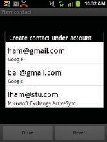
3. Tap
(Create new contact).
4. Tap a destination for your new contact to be synchronized. With each new email account you create, the list of options grows.
• The new contact can be easily synchronized to either:
● Google (Gmail account).

● Microsoft Exchange ActiveSync (Outlook- Exchange Server).
Note: You will not see the above option to select a destination unless you have previously established a Google or Corporate account on the device. (See “Synchronizing Accounts” on page 65.)
5. Touch the First name and Last name fields.
6. Touch Done to store and update the new entry.
Finding a Phone Number
![]()
You can search Contacts for entries by name.
1. Press ![]() and tap
and tap ![]() .
.![]()
– or –
From the Keypad screen, tap .
– or –![]()
![]()
Press > .
2. Enter the first letter or letters of an entry. (The more letters you enter, the more specific the search.)
3. To display contact details, tap an entry from the list.

Dialing From the Contacts List
1. Press and tap .
Shortcut: From the Keypad screen, tap Contacts ( ) to list entries.
![]()
2. Scroll through the list and tap the entry you want to call.
3. Tap a phone number.
Speed Dialing
![]()
Dialing From Favorites
You can quickly dial contacts you call frequently by adding them to your Favorites list. Although not assigned to a speed dial number, this is a quick and easy way to dial your favorite Contacts. (See “Adding Entries to Your Favorites” on page 92.)
2B. Making and Answering Calls 57
To speed dial a contact from Favorites:
1. Press ![]() and tap
and tap ![]() > Favorites.
> Favorites.
2. Scroll through the list and tap the contact.
3. Tap Call to place a call or tap Message to send a text to the contact.
Dialing a number from the Favorites tab is similar to dialing one from the Contacts tab. (See “Dialing From the Contacts List” on page 57.)
Plus (+) Code Dialing
![]()
![]()
When placing international calls, Plus Code Dialing automatically enters the international access code for your location (for example, 011 for international calls made from the U.S.). (See “Activating Plus Code Dialing” on page 70.)![]()
1. Press and tap .
3. Dial the country code and phone number, and then tap ![]() . (The device automatically prepends the access code for international dialing,
. (The device automatically prepends the access code for international dialing,
followed by the country code and phone number.)
2. Touch and hold 0 +
until you see a “+” on the
display screen. This is equivalent to manually entering a “011” for international dialing.
58 2B. Making and Answering Calls
2C. Settings

• Sound Settings (page 59)
• Display Settings (page 62)
• Language Settings (page 64)
• Location Settings (page 64)
• Synchronizing Accounts (page 65)
• Search Settings (page 69)
• Call Settings (page 70)
• Airplane Mode (page 70)
• TTY Use With Sprint Service (page 71)
• Security Settings (page 72)
The Settings menu can be accessed by one of two ways on the Samsung Replenish™:
� Press ![]() >
> ![]() >
> ![]() (Settings).
(Settings).
![]()
![]()
![]()
– or –
Press and tap > .
Sound Settings
![]()
Ringer Types
Ringer types help you identify incoming calls and messages. You can assign ringer types to individual Contacts entries, types of calls, and types of messages.
Selecting Ringer Types for Voice Calls
Your device provides a variety of ringer options that allow you to customize your ring and volume settings.
1. Press ![]() >
> ![]() >
> ![]() > Sound settings > Phone ringtone.
> Sound settings > Phone ringtone.
2. Tap a ringtone from the available list. The ringtone briefly plays when selected.
![]()
3. Tap OK to assign a ringer.
Selecting Ringer Types for Notifications
The notification area displays icons associated with user notifications such as email messages, missed calls, voicemail, upcoming events, USB connections, or Text/MMS messages. You can select the ringtone that plays when your device receives new notifications.
2C. Settings 59
1. Press ![]() >
> ![]() >
> ![]() > Sound settings > Notification ringtone.
> Sound settings > Notification ringtone.
2. Tap a notification ringtone from the available list.
The ringtone briefly plays when selected.
3. Tap OK to assign a ringer.
Activating Feature Sounds
You can select whether your device plays a sound when using the dialpad, when making an onscreen selection, and when an SD card notification occurs.
1. Press ![]() >
> ![]() >
> ![]() > Sound settings.
> Sound settings.
2. Tap a feature to enable it. (If a green checkmark appears to the right of the feature, it is already enabled.)
• Audible touch tones plays a tone while using the dialpad.
• Audible selection plays a sound when making any onscreen selection.
• Screen lock sounds plays a sound when locking or unlocking the screen.
![]()
• Haptic feedback causes the device to vibrate when pressing onscreen keys or with certain UI interactions.
Note: To download additional ringers, visit www.sprint.com and click Digital Lounge.
Adjusting the Volume Settings
Adjust the volume settings to suit your needs and your environment.
1. Press ![]() >
> ![]() >
> ![]() > Sound settings > Volume.
> Sound settings > Volume.
2. Touch and drag the onscreen sliders to assign to volume level settings for the following:
• Ringtone, Media, or Alarm.
3. Select Use incoming call volume for notifications, if desired, by putting a checkmark in the box.![]()
4. Tap OK to assign the volume levels.
Tip: You can adjust the ringer volume in standby mode (or the earpiece volume during a call) by using the volume button on the left side of your device.
60 2C. Settings
Vibrate
To set your device to vibrate for incoming calls and silent for notifications:
� Press the volume button down in standby mode until you see ![]() on the screen.
on the screen.
To set your device to vibrate for incoming calls:
1. Press ![]() >
> ![]() >
> ![]() > Sound settings.
> Sound settings.
2. Tap Vibrate and select Always, Never, Only in Silent
Mode, or Only when not in Silent mode.
To set your device to vibrate while using the dialpad and making onscreen selections:
1. Press ![]() >
> ![]() >
> ![]() > Sound settings.
> Sound settings.
2. Tap Haptic feedback. (If you have already checked the option, tapping it again deselects the option.)
• This provides a physical feedback when interacting with the onscreen options.
Silent Mode
The Silence All option allows you to mute all sounds without turning your device off (except for Media volume).
To activate Silence All:
![]()
� Press and hold the volume button down in standby mode until you see ![]() on the screen.
on the screen.
Note: If you set your Vibrate options to Always or Only in
silent mode, you will see on the screen.
To deactivate Silence All:
� Press the volume button up repeatedly to select a volume level.
![]()
To set your device to silent mode:
1. Press ![]() >
> ![]() >
> ![]() > Sound settings.
> Sound settings.
2. Tap Silent mode. This option silences all audio on the device except for media and alarms. (If you have already checked the option, tapping it again deselects this option.)
2C. Settings 61
Display Settings
![]()
Changing the Screen Orientation
This feature can be manually enabled to change the orientation for all screens when rotation is detected. (See “Changing the Screen Orientation” on page 39.)
1. Press ![]() >
> ![]() >
> ![]() > Display settings.
> Display settings.
2. Tap Auto-rotate screen (enabled by default). A
green checkmark indicates the feature is enabled.
• Clear the Auto-rotate screen checkmark to disable this automatic orientation adjustment.
Window Animation
This feature provides the use of animation when onscreen windows are opened and closed. If deactivated, windows pop on and off and no transitions are applied.
1. Press ![]() >
> ![]() >
> ![]() > Display settings.
> Display settings.
2. Tap Animation and select No animations,
Some animations, or All animations.
Changing the Backlight Time Length
Select how long the display screen remains lit after you press any key.
1. Press ![]() >
> ![]() >
> ![]() > Display settings > Screen timeout.
> Display settings > Screen timeout.
2. Tap a time setting (15 seconds, 30 seconds,![]()
1 minute, 2 minutes, or 10 minutes).
Note: Long screen backlight settings reduce the battery’s talk and standby times.
Changing the Brightness
Adjust your screen’s brightness to suit your surroundings.
1. Press ![]() >
> ![]() >
> ![]() > Display settings.
> Display settings.
2. Tap Brightness.
3. Touch and drag Brightness slider left or right to adjust the screen contrast and tap OK.
62 2C. Settings
Notification Flash
Select whether or not the LED light flashes repeatedly when you receive a notification.
1. Press ![]() >
> ![]() >
> ![]() > Display settings.
> Display settings.
2. Tap Notification flash to disable the feature by removing the checkmark.
Viewing Battery Use
Review which applications are draining your battery.
1. Press ![]() >
> ![]() >
> ![]() > About phone > Battery use.
> About phone > Battery use.
2. Tap an item to see more detailed information.
Changing the Display Screen
Choose what you see on the Home screen (behind your shortcuts and widgets) while powering on or off the device, and when in standby mode.![]()
![]()
![]() and tap (Wallpaper).
and tap (Wallpaper).
2. Tap Eco Wallpapers, Gallery, ID wallpapers, Live wallpapers, or Wallpapers.
• Eco Wallpapers lets you choose from preloaded ecological (eco) wallpapers that display scenes from nature.
• Gallery lets you choose from pictures taken using the built-in camera or copied to your device as a wallpaper. You can crop the picture before setting it as a wallpaper. (See “Assigning a Picture to an Entry” on page 91 to learn how to crop the picture.)
• ID Wallpapers lets you choose from wallpapers available from the currently assigned ID pack.
• Live wallpapers provides a selection of preloaded animated video wallpapers.
![]()
• Wallpapers provides a selection of preloaded wallpaper images.
3. Scroll through available images and tap a selection to preview it.
4. Tap Set wallpaper to assign the new wallpaper.
– or –
Tap Save to assign a picture as a wallpaper.
2C. Settings 63
Adjusting the Date and Time
Your device obtains its time and date information by using the network-provided date, time, and time zone. These values can be manually altered.
1. Press ![]() >
> ![]() >
> ![]() > Date & time.
> Date & time.
![]()
2. Tap Automatic to disable the feature.
Note: If enabled, you can not alter the date, time zone or time values.
3. Tap Set date. Adjust the date, month, and year by tapping ![]() or
or ![]() . Tap Set when finished.
. Tap Set when finished.
4. Tap Select time zone, and then select a time zone from the onscreen list. Scroll down the list to view additional time zones.
5. Tap Set time. Adjust the hour and minute by tapping ![]() or
or ![]() . Tap the am or pm icon to change the value. Tap Set when finished.
. Tap the am or pm icon to change the value. Tap Set when finished.
6. Tap Use 24-hour format to toggle between using a
12-hour or a 24-hour format.
7. Tap Select date format to select how the date information is displayed on your device. The selected date format is also applied to the date displayed within the device’s Alarm Clock.
Language Settings
![]()
You can assign the default language used by the
Android operating system.
1. Press ![]() >
> ![]() >
> ![]() > Language &
> Language &
keyboard > Select language.
2. Tap either English or Español. All menus are then updated to the new language.
Location Settings
![]()
Your device is equipped with a Location feature for use in connection with location-based services.
The Location feature allows the network to detect your position. Turning Location off will hide your location from everyone except 911.
64 2C. Settings
Note: Turning Location on will allow the network to detect your position using GPS technology, making some Sprint applications and services easier to use. Turning Location off will disable the GPS location function for all purposes except 911, but will not hide your general location based on the cell site serving your call. No application or service may use your location without your request or permission. GPS-enhanced 911 is not available in all areas.
3. Tap Agree. Enabling this feature allows Google to collect anonymous location data whether or not any location application or other related feature is active or in use.
• Tap Use wireless networks > Disagree to disable the collection of data. Enabling this feature can utilize more resources and slow performance.
Synchronizing Accounts
To enable your device’s GPS Location feature:
1. Press ![]() >
> ![]() >
> ![]() > Location & security.
> Location & security.
2. Tap Use GPS satellites. A green checkmark indicates the GPS location feature is enabled.
To enable Location via wireless networks:
1. Press ![]() >
> ![]() >
> ![]() > Location & security.
> Location & security.
2. Tap Use wireless networks. A green checkmark indicates the feature is enabled.
• This service uses available wireless networks to pinpoint your location within certain applications such as Google Maps (page 184).
Your device provides the ability to synchronize data from a variety of different sources or sites. Account types include Google Email, and Corporate Exchange Email Server.![]()
Corporate and Google accounts provide the ability to synchronize Calendar events and Contacts.
To enable the auto-sync feature:
1. Press ![]() >
> ![]() >
> ![]() > Accounts & sync.
> Accounts & sync.
2. Tap Auto-sync. A green checkmark indicates the feature is enabled.
• This feature enables the synchronization of data between your device and external sites or servers.
2C. Settings 65

• The two main components are Contacts and Calendar Events. Before these can be synchronized, they must be added to the managed accounts list.
Important: Any new email account should be managed and synchronized via the Accounts & sync menu. This process is not automatic for some accounts. If a new email account does not appear in this menu, it must be manually added and synchronized.
Synchronizing Your Google Account
By default, there are no accounts managed by the device. These must be manually added.
To add and manage an existing Google account:
1. Press ![]() >
> ![]() >
> ![]() > Accounts & sync.
> Accounts & sync.
2. Tap Add account > Google.![]()
3. Click Next > Sign in.
Note: If you do not already have a Google account, touch Create and follow the onscreen prompts to create your new account.
4. Touch the Username (@gmail.com) and Password
fields and enter your information.
5. Tap Sign in. Your device then communicates with the Google servers to confirm your information. Your existing Gmail account then appears within the Manage accounts area of the screen.
• Any changes or updates to your Gmail account are then automatically updated to your device.
To configure the Google management settings:
![]()
1. Press > ![]() >
> ![]() > Accounts & sync.
> Accounts & sync.
2. Tap within the Google account field to reveal the account’s synchronization settings screen.
3. Tap the parameters you wish to synchronize (Sync Books, Sync Contacts, Sync Gmail, Sync Calendar). A green checkmark indicates the feature is enabled.![]()
4. Press to return to the previous screen.
66 2C. Settings
Synchronizing Your Corporate Account
![]()
By default, there are no Corporate Calendar events managed by the device. These must be manually added. (See “Synchronizing Corporate Calendar Events” on page 93.)
Note: Once a corporate email account is created, it is automatically added as a managed account.
To add a new Corporate account:
1. Press ![]() >
> ![]() >
> ![]() > Accounts & sync.
> Accounts & sync.
2. Tap Add account > Microsoft Exchange ActiveSync.
3. Follow the onscreen prompts to create your new Corporate email account. (See “Corporate Email (Outlook)” on page 163.)
• Any changes or updates to your Corporate/ Outlook account are then automatically updated to your device.
To configure the Corporate management settings:
![]()
![]()
![]()
1. Press > > > Accounts & sync.
2. Tap ![]() within the Corporate account field to reveal the account’s synchronization settings
within the Corporate account field to reveal the account’s synchronization settings
screen.
3. Tap the parameters you wish to synchronize.
• Account settings allows you to configure:
● Account name displays the name used by the device to track the account.
● Your name allows you to enter a personal name to associate with the account.
![]()
● Amount to synchronize to assign the sync range for your incoming and outgoing emails between your device and your external exchange server. How many days worth of emails should the device and server synchronize. Choose from: 1 day, 3 days,
1 week, 2 weeks, 1 month, or All emails.
● Default account assigns this account as the default used when sending out new emails.
● Out of office settings activates and personalizes an automatic return email informing senders that you are unavailable.
2C. Settings 67
● Empty deleted items: Allows you to delete your email account’s trash bin remotely.
● Sync schedule: Allows you to configure your email sync schedule.
● Email size: Configures the incoming email size allowed to pass through to your device automatically without user interaction. Larger emails will have to be retrieved manually. Choose from: Headers only, Half KB, 1 KB, 2 KB,
5 KB, 10 KB, 20 KB, 50 KB, 100 KB, or All.
● Email notifications enables the device to display a status bar icon ![]() when new emails have been received.
when new emails have been received.
● Select ringtone assigns an audible ringtone when a new or upcoming event is pending.
● Vibrate assigns a vibration when a new or upcoming event is pending.
● Incoming settings provides access to the Domain, password, and exchange server settings.
● Sync Contacts synchronizes the contacts between your device and the remote exchange server. A checkmark indicates the feature is enabled.
● Sync Calendar synchronizes your exchange calendar entries between your device and the remote exchange server. A checkmark indicates the feature is enabled.
● Period to sync Calendar assigns a period for your device to sync calendar events. Choose from: 2 weeks, 1 month, 3 months, 6 months, or All calendar.
● Add signature: Activates the email signature feature.
● Signature allows you to create an outgoing email signature attached to new emails sent from your device.
• Sync Contacts allows you to manually synchronize the contacts from the corporate server to the device. A checkmark indicates the feature is enabled.
68 2C. Settings
• Sync Calendar allows you to manually synchronize calendar events from the corporate server to the device. A checkmark indicates the feature is enabled.
4. Press ![]() to return to the previous screen.
to return to the previous screen.
For more detailed Work/Corporate email information, see “Corporate Email (Outlook)” on page 163. For more information on Corporate Calendar synchronizing, see “Synchronizing Corporate Calendar Events” on page 93.
Search Settings
![]()
You can use your device’s search preferences to configure some aspects of Google Web search (for example, whether it makes suggestions below the Quick Search Box as you type), and what phone features you want to include in searches.
Configuring the Search Settings
![]()
1. Press > ![]() and tap
and tap ![]() .
.
2. Press and tap Search settings.
3. Tap any of the following search parameters to then alter the settings:
• Google search opens a screen where you can set your Google search preferences.
● Show web suggestions also includes search matches from Google’s online search engine.
● Use My Location uses your My Location information for Google search results and services.
● Search history determines whether you also wish to included personalized search history results in the list of matches.
● Manage search history helps to manage the personalized search history associated with your current registered Google account.
![]()
• Searchable items opens a screen where you can choose the search categories included in device searches.
● Categories include: Web, Apps, Books,
Contacts, Messaging, Music, and Voice Search.
• Clear shortcuts erases the history of recently selected search results.
2C. Settings 69
Call Settings
![]()
Your device allows you to configure call settings such as Plus Code dialing, other international dialing options, and TTY configuration.
Activating Plus Code Dialing
Plus Code dialing allows you to have the phone automatically dial the international access code for
2. Tap North American dialing to deactivate the feature. This enables the International Dialing field.
3. Tap International Dialing.
4. Tap the entry field and press ![]() from the onscreen keyboard to delete the previous value.
from the onscreen keyboard to delete the previous value.
5. Enter a new value and tap OK.
6. Tap North American dialing to reactivate the feature.
This disables the International Dialing field.![]()
your location once you touch and hold 0 + .
(See “Plus (+) Code Dialing” on page 58.)
1. Press ![]() >
> ![]() >
> ![]() > Call settings.
> Call settings.
2. Tap North American dialing to activate the feature
(a green checkmark appears in the adjacent field).
Changing the International Dialing Code
By default, the international dialing prefix (code) is set to 011. This code can not be changed until the feature is temporarily disabled. Once disabled, the field becomes accessible and can be altered.
1. Press ![]() >
> ![]() >
> ![]() > Call settings.
> Call settings.
70 2C. Settings
Airplane Mode
![]()
Airplane Mode allows you to use many of your device’s features, such as Games, Memo, and Music, when you are in an airplane or in any other area where making or receiving calls or data is prohibited. When you set your device to Airplane Mode, it cannot send or receive any calls or access online information.
1. Press and hold ![]() to reveal the Phone options.
to reveal the Phone options.
2. Tap ![]() Airplane mode.
Airplane mode.
– or –![]()
![]()
![]()
1. Press > > > Wireless & networks.
2. Tap Airplane mode to place a checkmark in the adjacent field.
While in Airplane Mode, your device’s Status area will display (![]() ).
).
To deactivate Airplane Mode:
1. Press and hold ![]() to reveal the Phone options.
to reveal the Phone options.
2. Tap ![]() Airplane mode.
Airplane mode.
– or –
1. Press ![]() >
> ![]() >
> ![]() > Wireless & networks.
> Wireless & networks.
2. Tap Airplane mode to remove the checkmark.
TTY Use With Sprint Service
Your device and TTY device will connect via a special cable that plugs into your phone’s headset jack.
If this cable was not provided with your TTY device, contact your TTY device manufacturer to purchase the connector cable.
To turn TTY Mode on or off:
1. Press ![]() >
> ![]() >
> ![]() > Call settings > TTY.
> Call settings > TTY.
(You will see an informational message.)
2. Touch TTY Off to turn TTY mode off.
– or –
Touch any of the following to enable the feature:
• TTY HCO, TTY VCO, or TTY Full.
To access the state Telecommunications Relay Service
A TTY (also known as a TDD or Text Telephone) is a![]()
(TRS) for assistance with TTY calls:
telecommunications device that allows people who are
� Dial
![]()
![]()
![]()
7 P Q R S 1 1
![]()
to reach an
deaf, hard of hearing, or who have speech or language
disabilities, to communicate by telephone.
Your device is compatible with select TTY devices. Please check with the manufacturer of your TTY device to ensure that it is compatible with digital cell phones.
operator.
For additional information about Sprint Relay Services and TTY compatibility, call Sprint Relay Customer Service at 800-676-3777 or visit www.sprintrelay.com.
2C. Settings 71
For additional technical support you may call
Security Settings
1-888-987-4357, or access the following website:
www.samsung.com/us/consumer/learningresources/
mobile/accessibility/pop_accessibility.html.
Note: In TTY Mode, your device will display the TTY access icon.

If TTY mode is enabled, the audio quality of non-TTY devices connected to the headset jack may be impaired.
WARNING: 911 Emergency Calling
Sprint recommends that TTY users make emergency calls by other means, including Telecommunications Relay Services (TRS),
analog cellular, and landline communications. Wireless TTY calls to 911 may be corrupted when received by public safety answering points
(PSAPs), rendering some communications unintelligible. The problem encountered appears related to software used by PSAPs. This matter
has been brought to the attention of the FCC, and the wireless industry and the PSAP community are currently working to resolve this.
Accessing the Security Menu
All of your device’s security settings are available through the Security menu. You can secure your data and limit phone access by requiring a screen unlock pattern every time your device is turned on or every time it wakes up from sleep mode (screen where the screen turns off).
� Press ![]() >
> ![]() >
> ![]() > Location & security.
> Location & security.
Your Device’s Screen Lock Feature
Locking Your Device Screen
When your device is locked, you can only receive incoming calls or make calls to 911.
� Press ![]() . Locking the screen prevents accidental screen touches from activating phone functions.
. Locking the screen prevents accidental screen touches from activating phone functions.
72 2C. Settings
Unlocking Your Device Screen
1. Press ![]() to awaken the device.
to awaken the device.
2. Touch and drag the lock icon to the right.
Your Device’s Unlock Pattern Feature
You can increase your device’s security by creating a screen unlock pattern (disabled by default). When enabled, you must draw the correct unlock pattern on the screen to unlock and regain access to the device.
Creating an Unlock Pattern
![]()
![]()
![]()
1. Press > > > Location & security.
2. Scroll down to the menu list and tap Set up screen lock > Pattern.
3. Read the information on the screen, and then tap Next.
4. Review the onscreen tutorial on pattern creation, and then tap Next.
5. Draw your pattern by
![]()

touching your first onscreen point. Then, without removing your finger from the screen, drag your finger over adjacent points until the gray trace line overlaps each point and they are highlighted with a green circle.
Important: You must slide your finger on the screen to create the pattern and not touch individual dots. If you make a mistake or a point is not properly selected, a red circle will appear.
2C. Settings 73
6. When you have connected at least four dots in a vertical, horizontal or diagonal direction, lift your finger from the screen.
7. Tap Continue to record the pattern.
8. Confirm the new pattern by redrawing it and then tapping Confirm.
After enabling the feature, additional unlock pattern options are enabled within the Location & security menu list.
Configuring the Unlock Pattern Settings
To require the pattern for access:
1. Press ![]() >
> ![]() >
> ![]() > Location & security.
> Location & security.
2. Place a checkmark adjacent to the
Use visible pattern field.
To remove the visible unlock pattern from the Lock screen:
1. Press ![]() >
> ![]() >
> ![]() > Location & security.
> Location & security.
2. Remove the checkmark adjacent to the
Use visible pattern field.
![]()
• Removing this checkmark prevents the unlock pattern from displaying on the unlock screen when you draw the pattern.
Tip: You can also enable or disable tactile feedback (vibration) for the unlock pattern with the Use tactile feedback option.
What to do if you have forgotten your pattern:
If you fail to draw the correct unlock pattern on the screen after five attempts, you are prompted to wait for
30 seconds before you can try again.
� If you have forgotten your screen unlock pattern, tap Forgot pattern?.
• Sign in using your Google account name and password. Create a new screen unlock pattern before regaining access to the Home screen.
Changing the Unlock Pattern
1. Press ![]() >
> ![]() >
> ![]() > Location & security > Change screen lock.
> Location & security > Change screen lock.
2. Draw the current pattern on the screen.
3. Draw and repeat a new pattern. (See “Creating an
Unlock Pattern” on page 73.)
74 2C. Settings
Calling in Lock Mode
When your device is locked, you can only receive incoming calls or make calls to 911or Sprint Customer Service.![]()
1. Press ![]() to reveal the lock screen.
to reveal the lock screen.
Note: The Unlock Pattern applies if the Require Pattern
setting is enabled.
2. Tap Emergency call to reveal the Emergency
Keypad to place your emergency call.
• Draw your unlock pattern to regain access to the full dialer and unlock the device.
Using a PIN
Creating a PINs to Unlock the Screen
1. Press ![]() >
> ![]() >
> ![]() > Location & security.
> Location & security.
2. Scroll down to the menu list and tap Set up screen lock > PIN.
3. Use the onscreen keyboard to enter a numeric PIN
and tap Continue.
4. Re-enter the same numeric sequence and tap OK.
To change your PIN:
1. Press ![]() >
> ![]() >
> ![]() > Location & security.
> Location & security.
2. Scroll down to the menu list and tap
Change screen lock.
3. Use the onscreen keyboard to enter your current numeric PIN and tap Continue.
4. Tap PIN.
5. Use the onscreen keyboard to enter a new numeric PIN and tap Continue.
6. Re-enter the same numeric sequence and tap OK.
Using a Password
Creating a Password to Unlock the Screen
![]()
1. Press ![]() >
> ![]() >
> ![]() > Location & security.
> Location & security.
2. Scroll down to the menu list and tap
Set up screen lock > Password.
3. Use the onscreen keyboard to enter an alphanumeric password and tap Continue.
4. Re-enter the same alphanumeric sequence and tap OK.
2C. Settings 75
To change your Password:
1. Press ![]() >
> ![]() >
> ![]() > Location & security.
> Location & security.
2. Scroll down to the menu list and tap
Change screen lock.
3. Use the onscreen keyboard to enter your current alphanumeric password and tap Continue.
4. Tap Password.
5. Use the onscreen keyboard to enter a new password and tap Continue.
6. Re-enter the same password and tap OK.
Using Visible Passwords
When enabled, this feature allows you to view the text being entered into a password field as you type it. Many times, other applications insert an asterisk (*) as you type. This can cause issues and confusion. What if you mis-typed the password or used the wrong case? When enabled, you can see your entry. This feature is enabled by default.
To disable visible passwords:
1. Press ![]() >
> ![]() >
> ![]() > Location & security.
> Location & security.
76 2C. Settings
2. Tap Visible passwords (to remove the checkmark on the option).
Managing Your Available Memory
You can manage the information and configuration related to both your microSD card and built-in device storage memory.
To view your device’s total available memory:
1. Press ![]() >
> ![]() >
> ![]() > Storage.
> Storage.
2. Review the two memory sections for available space information:
• SD card displays the memory information specific to an installed microSD card. This amount of space can be altered by replacing the current microSD card.
• Internal storage displays the memory information specific to the built-in device memory. This memory amount can not be altered because it is part of the device hardware.
To view your microSD card storage information:
![]()
![]()
![]()
1. Press > > > Storage.
2. Locate the SD card section.
3. Review the available fields:
• Total space indicates the total size of the inserted microSD card. This includes both available and used space information.

● To determine the amount of memory currently used on the card, subtract the remaining available space from the total space.
Note: Not all of the microSD card is registered in the available space, as a small percentage of the storage is unread. A 16GB microSD card will show approximately
14.73GB of total space.
• Available space indicates the amount of remaining free memory space available on the microSD card.
• Unmount SD card allows you to “unmount” the microSD card from its communication to the device. This severs the connection so the card can be safely removed or reformatted.
• Erase SD card allows you to format (erase data
To view your device’s storage information:
1. Press ![]() >
> ![]() >
> ![]() > Storage.
> Storage.
2. Locate the Internal storage section indicating the available storage space within the device’s memory.
Manage Running Services
This service efficiently manages power consumption and processor/memory resources. Processes can be stopped until the device is restarted.
To stop a currently running service:
1. Press ![]() >
> ![]() >
> ![]() > Applications > Running services.
> Applications > Running services.
![]()
2. Tap Running, select an onscreen process entry, and touch Stop.
3. Read the Stop system service? dialog and touch
OK.
Note: These stopped processes are restarted once the device is restarted (power cycled).
from) the microSD card. This can only be done
after a card that has been properly unmounted.
Third-party Task Manager applications are also available from the Google Marketplace.
2C. Settings 77
Erasing Device Content
Use the Manage applications menu to quickly erase selected content and uninstall third-party applications stored in your device.
To clear an application’s cache:
1. Press ![]() >
> ![]() >
> ![]() > Applications > Manage applications.
> Applications > Manage applications.
2. Press ![]() and tap Sort by size. This option sorts the current Manage applications listing to display those applications by amount of memory or cache usage.
and tap Sort by size. This option sorts the current Manage applications listing to display those applications by amount of memory or cache usage.
3. Tap the application whose cache you wish to delete.
4. From the Application info screen, tap Clear data
and/or Clear defaults.
To uninstall third-party applications:
1. Press ![]() >
> ![]() >
> ![]() > Applications > Manage applications.
> Applications > Manage applications.
Important: Only third-party applications can be uninstalled.
Applications preinstalled on the device can not be removed.
![]()
2. Tap the third-party application, and from the
Application info screen, tap Uninstall.
Resetting Your Device
![]()
Resetting the device restores all the factory defaults, including the ringer types and display settings. All data, including downloaded applications are deleted.
Important: Back up your important data before you perform a factory reset of the device.
1. Press > > > Privacy > Factory data reset. (You will see a disclaimer.)
2. To clear music, pictures, and other user data, add a checkmark to Erase SD Card.
3. Read the disclaimer and tap Reset phone.
4. If you are certain that you would like to restore all factory settings, tap Erase everything.
78 2C. Settings
![]()

The Notification area of the Home screen (upper-left)
displays phone notifications, status, or alerts such as:
2D. Call Logs Call in progress: Indicates there is
a call currently active and in progress.
• Viewing Call Logs (page 79)
• Call log Options (page 80)
• Making a Call From Call log (page 82)
• Saving a Number From Call log (page 82)
Missed Call: Indicates an incoming call was missed.
To access the Call Logs screen:
• Altering a Number From Call log (page 83)
![]()
![]()
1. Press and tap >
![]()
Call log .
• Erasing the Call log Entries (page 83)
Viewing Call Logs
![]()
Call log (Call History) is a list of the phone numbers (or Contacts entries) for calls you placed, accepted, or missed. The Call log screen makes redialing a number fast and easy. It is continually updated as your device automatically adds new numbers to the beginning of the list and removes the oldest entries from the bottom of the list.![]()
2. Tap an entry to view available options.
Note: Call log records only calls that occur while the device is turned on. If a call is received while your device is turned off, it will not be included in history.
From within the Call log screen, each entry contains the phone number (if it is available) and Contacts entry name (if the number is in your Contacts).
2D. Call Logs 79
| Dialed: Indicates all outgoing calls made from your device. |
| Received: Indicates any received calls that were answered. |
| Missed: Indicates any missed calls. These are routed to your voicemail. |
Accessing Call Logs From Notifications
You can also access the Call log screen from a Missed Call notification. (See “Using the Notifications Panel” on page 41.)
1. Locate ![]() from the Notifications area of the
from the Notifications area of the
Status bar.
2. Touch and hold the Status bar, and then slide your finger down the screen.
3. Tap the Missed call entry to open the Call log screen.
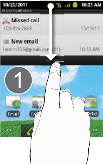
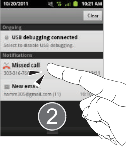
Call log Options
![]()
This list provides easy access to redial an entry, or you can also choose to access two types of history entry lists depending on how they are touched.
e Tap an entry from the list and tap Call to quickly redial the selected entry. (See “Making a Call From Call log” on page 82.)
80 2D. Call Logs
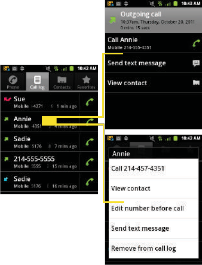
call options
(tap) Call log screen
entry-specific context menu
(touch and hold)
![]()
e Tap a contact entry name or number to reveal the
call options screen:
• Time provides the time and date of the call and its duration.
• Call allows you to redial the entry by name or number.
• Send text message allows you to create a new text message to the selected entry.
• Add to contacts/View Contact to save the number if it is not already in your Contacts. (See “Saving a Number From Call log” on page 82.)
e Touch and hold an entry to display the entry-specific
context menu:
• Call [Number] to redial the current phone number.
• View contact to open the contact details screen.
• Edit number before call to make alterations to the current phone number prior to redial. (See “Altering a Number From Call log” on page 83.)
• Send text message allows you to create a new text message to the selected entry.
2D. Call Logs 81
• Add to Contacts to save the number if it is not already in your Contacts. (See “Saving a Number From Call log” on page 82.)
• Remove from call log to delete the entry from the
Logs list.![]()
Making a Call From Call log
1. Press and tap > Call log .
2. Tap an entry, and then tap Call.
– or –![]()
Touch and hold an entry name/number from the list, and then tap Call [Number].
Note: You cannot make calls from the Logs screen to entries identified as Unknown, No ID, Restricted or Private Number.
![]()
Saving a Number From Call log
1. Press and tap > Call log .
2. Tap an entry > Add to Contacts.
3. Select Create new contact within the saved contacts list.
4. Tap a destination type (Phone, Google, or
Corporate).
Note: The option to select a destination is only available if you have previously established a Google or Corporate account on the device.
If you are currently signed into your Gmail account, “Phone” will not display as a destination type.
5. Tap the First name and Last name fields and enter a name for the contact.
6. Tap Done when you have finished entering information for the contact.![]()
After you have saved the number, your device displays the new Contacts entry in place of the previous number. (See “Contacts Entry Options” on page 88.)
Note: You cannot save phone numbers already in your Contacts or from calls identified as Unknown, No ID, Restricted or Private Number.
82 2D. Call Logs
Altering a Number From Call log
![]()
![]()
If you need to make a call from the Call log screen and you need to alter the number prior to dialing, you can add the appropriate prefix by prepending the number.
1. Press ![]() and tap
and tap ![]() > Call log .
> Call log .
2. Touch and hold an entry to access the entry-specific options menu.
3. Tap Edit number before call.
4. Edit the number using the onscreen dialpad or delete digits by pressing ![]() to erase the
to erase the
numbers.
5. Tap once the number has been changed.
Note: To edit a number and save it to Contacts, tap View contact in step 2 above, and then edit the number and tap Save. (See “Editing a Contacts Entry” on page 89.)
![]()
Erasing the Call log Entries
![]()
You can delete either an individual call log entry or all current entries from the Call log list.
To clear a single entry from the Call log list:
![]()
1. Press ![]() and tap
and tap ![]() > Call log .
> Call log .
2. Touch and hold an entry and tap Remove from call log.
To clear all entries from the Call log list:
![]()
![]()
1. Press and tap ![]() > Call log .
> Call log .
2. Press and touch Clear call log > OK.
2D. Call Logs 83
2E. Contacts

• Creating a New Contacts Entry (page 84)
• Saving a Phone Number (page 86)
• Confirming Contact Synchronization (page 86)
• Contacts Menu Options (page 88)
• Contacts Entry Options (page 88)
• Editing a Contacts Entry (page 89)
• Adding a Number to a Contacts Entry (page 89)
• Editing a Contacts Entry’s Number (page 90)
• Sharing Contacts (page 90)
• Assigning a Picture to an Entry (page 91)
• Deleting Entries (page 91)
• Adding Entries to Your Favorites (page 92)
Important: To verify your Contacts appear on your device, you must sync your email accounts after setup (Settings > Accounts and sync). (See “Confirming Contact Synchronization” on
page 86.)

Creating a New Contacts Entry
![]()
![]()
If existing Google and Corporate email accounts have been synchronized to your device, these will be made available to your device during the creation of new entries. These new Contacts entries can be assigned or saved to synced accounts such as Phone, Google, or Corporate.
Note: The option to select a destination is only available once you have established a Google or Corporate account on the device.
84 2E. Contacts
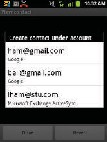
Your device automatically sorts the Contacts entries alphabetically. You can create either a Google or Corporate contact.
e Google contacts are shared with your existing Google account and can also be imported to your device after you have created a Google Mail account.
e Corporate (also known as Work or Outlook) contacts are those contacts that are intended to be shared with either an Exchange Server or from within Microsoft® Outlook®.
1. Press ![]() and tap
and tap ![]() .
.
2. Tap ![]() > New contact (to open the New contact
> New contact (to open the New contact![]()
screen).
Shortcut: Enter a phone number from the keypad and tap Add to Contacts > . Proceed with steps 3–8.
3. Tap a destination type (Phone, Google, or![]()
Corporate).
Note: You will not see the option to select a destination unless you have previously established a Google or Corporate account on the device.
![]()
4. Tap the First name and Last name fields, and enter a name for the new entry.
5. Tap the label button (to the left of the Phone field) to select a category such as Home, Mobile (default), Work, Work Fax, Home Fax, Pager, Other, or Custom.
6. Tap a phone number field and enter a phone number.
• Tap ![]() to remove a previously entered phone number.
to remove a previously entered phone number.
7. Enter additional information such as: Email, Postal address, Organization or More to input additional category information.
• Use your finger to slide the page up or down to see additional fields and categories.
8. Tap Done to complete and store the new entry.
2E. Contacts 85

After saving the number, your device displays the new entry within the Contact list. (See “Contacts Entry Options” on page 88.)
Tip: ICE – In Case of Emergency
To make it easier for emergency personnel to identify important contacts, you can list your local emergency contacts under “ICE” in your device’s Contacts list. For
example, if your mother is your primary emergency contact, list her as “ICE–Mom” in your Contacts. To list more than one emergency contact, use “ICE1– ,”
“ICE2– _,” etc.
Saving a Phone Number
![]()
To save a number from the keypad:
1. Press ![]() and tap
and tap ![]() .
.
2. Enter a phone number using the onscreen dialpad.
3. Press ![]() and tap Add to Contacts > Create new contact.
and tap Add to Contacts > Create new contact.
• If you're updating an existing contact, proceed to step 6.
4. Tap a destination type (Phone, Google, or![]()
Corporate).
Note: You will not see the option to select a destination unless you have previously established a Google or Corporate account on the device.
5. Tap the First name and Last name fields, and enter a name for the new entry.
6. Tap the label button (to the left of the Phone field) to select a category such as Home, Mobile (default), Work, Work Fax, Home Fax, Pager, Other, or Custom.
7. Tap Done to complete and store the new entry.
Confirming Contact
Synchronization
![]()
Syncing data from your managed accounts allows you to add and manage a new or existing contact from your online or remote accounts to your device. Prior to syncing, you must first have an active Google or Corporate account with current Contact entries, and be signed into your account via the device.
86 2E. Contacts
With syncing, any Contacts entries (with phone numbers, email addresses, pictures, etc.) are updated and synced with your Samsung Replenish™.
For more information about syncing existing managed accounts, see “Synchronizing Accounts” on page 65.
1. Press ![]() >
> ![]() >
> ![]() > Accounts & sync.
> Accounts & sync.
2. Locate the email account containing the contacts you wish to synchronize.
3. Tap ![]() within the adjacent account field to reveal the account’s synchronization settings screen.
within the adjacent account field to reveal the account’s synchronization settings screen.
4. To synchronize Gmail Contacts, tap Sync Contacts.
A green checkmark indicates the feature is enabled.
– or –
To synchronize Corporate Contacts, tap Sync Contacts. A green checkmark indicates the feature is enabled.
Note: Any change on either side (Phone, Gmail, or Corporate/Outlook Contacts), is reflected on the other side after a sync process.
![]()
The process of updating your Contacts tab can take several minutes. If after 10-20 minutes, your list has not been updated, repeat step 2-3.

5. Your Contacts tab then reflects any updated
Contact information.![]()
• This update process works both ways. For example, any changes on the device are updated to your Gmail Contacts list after sync.
Note: Syncing of contacts requires you are logged into your
Gmail and Corporate accounts via the device.
2E. Contacts 87

![]()
![]()
Contacts Menu Options
1. Press and tap .
2. Touch and hold an entry and select from the available contact menu options:
• View contact to view the
Contact’s overview screen.
• Call contact to call a Contact's available number.
• Text contact to send the Contact a new text message.
• Add to/Remove from favorites to add or remove the current Contacts entry to or from the Favorites tab.
• Edit contact to edit the currently selected Contacts
Note: Prior to using the Bluetooth feature, it must first be enabled, and the recipient’s device must be visible.
In addition to Contact’s information, other file types
(video, image, or audio) can be sent using Bluetooth.

Contacts Entry Options
![]()

1. Press ![]() and tap
and tap ![]() .
.
2. Touch an entry to display
the Contact entry’s overview screen. This screen contains Name, contact numbers, email, and linked contact information.
3. Press ![]() to reveal the context menu specific to this entry.
to reveal the context menu specific to this entry.
entry. (See “Editing a Contacts Entry” on
page 89.)
4. Tap an available option. (See “Contacts Menu
Entry’s Overview screen
• Delete contact to erase the currently selected
Contacts entry. (See “Deleting Entries” on page 91.)
Options” on page 88 for descriptions.)
88 2E. Contacts
Editing a Contacts Entry
![]()
1. From the Contact’s overview screen, press ![]() and tap Edit contact.
and tap Edit contact.
2. Tap an option, such as First Name or Email address, to begin editing.
• [image icon] to assign a picture to the entry. (See
“Assigning a Picture to an Entry” on page 91.)
• First name/Last name to edit the current name.
• Phone to add or delete a phone number. (See “Adding a Number to a Contacts Entry” on page 89.)
• Email to add or delete an email address.
• Postal address to enter a physical address for the contact. Choose from Home, Work, Other, or Custom.
• Organization to enter business information such as company name
• More to add additional information, such as
![]()
IM, Notes, Nickname, Website, and Internet call.
Note: Some fields may appear in different order or within the
Add more fields menu.
3. Tap Done to complete and store the new entry.
Adding a Number to a Contacts
Entry
![]()
![]()
1. From the Contacts screen tap an entry.
2. From the Contact’s overview screen, press ![]() and tap Edit contact.
and tap Edit contact.![]()
3. From the Phone field section, tap ![]() (add phone number) to create a new Phone number field within the selected phone number category.
(add phone number) to create a new Phone number field within the selected phone number category.
• Tap to enter an additional phone number.
• Tap to remove a previously entered phone number.
4. Tap the label button (to the left of the Phone field) to select a category such as Home, Mobile (default), Work, Work Fax, Home Fax, Pager, Other, or Custom.
5. Tap the Phone field to enter the new number.
6. Tap Done to update the new number to the existing
Contacts entry.
2E. Contacts 89
![]()
Editing a Contacts Entry’s Number
1. From the Contact’s overview screen, press and tap Edit contact.
2. Tap an existing phone number field.
Note: Touch and hold the Phone number field to activate the
Edit text menu.
3. Tap to clear one digit at a time.
4. Re-enter or edit the number using the QWERTY
keyboard.
5. Tap Done to update the number to the existing
Contacts entry.
Sharing Contacts
![]()
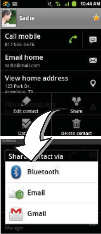
1. Press ![]() and tap
and tap![]()
.
2. Touch an entry to open its overview page.
3. Press ![]() and tap Share to send the current Contact entry’s information to an external recipient via either:
and tap Share to send the current Contact entry’s information to an external recipient via either:
• Bluetooth to transmit this contact to another bluetooth-compatible device.
• Email to attach the contact card to a new outgoing email (Exchange or Internet).
• Gmail to attach the
contact card to a new outgoing Internet-based email.
90 2E. Contacts
Assigning a Picture to an Entry
Applying a picture to your Google Contact from within your
online Gmail:
Assign a picture to display each time a certain contact calls you.
Assigning a picture via the device:
1. From the Contact’s overview screen, press ![]() and tap Edit contact.
and tap Edit contact.
2. Tap a contact image (upper-left).
1. Log into your Gmail account and go to your
Contacts page.![]()
2. Select your Contacts entry (with a checkmark) and click the image area (Change Picture).
3. Click Browse to locate a local copy of your image.
• You can also choose an image from other
®
• Open an image location (Take photo or Select
sources such as Picasa
Web.
photo from Gallery) and tap an onscreen image to prepare it for use.
● Press ![]() to return to the Select picture page where you can now select the new image.
to return to the Select picture page where you can now select the new image.
3. Touch and drag along the sides of the yellow border box to begin cropping the desired area, and then tap Save to assign selected picture.
4. To save the phonebook, touch Done.
4. Crop the visible area of your selected picture and click Apply Changes.
5. Sync your new contact from your online Gmail to your device. (See “Confirming Contact Synchronization” on page 86.)
Deleting Entries
![]()
1. From the Contact’s overview screen, touch and hold an entry from the list.
2. From the Contacts Entry context menu, tap Delete contact.
2E. Contacts 91
3. Tap OK to confirm the deletion.
Adding Entries to Your Favorites
![]()
The Favorites tab is a listing that can help you quickly access your most used or preferred Contacts entries.
1. Press ![]() and tap
and tap ![]() .
.
2. Touch and hold the entry name from the Contacts
tab listing.
3. From the Contacts Entry context menu, tap Add to favorites.
Note: Another method to add or remove an entry from your favorites is to toggle the state of the star icon on the Contact’s details page (upper-right). Tap to add the entry to your favorites (star is lit), tap again to remove.
92 2E. Contacts
2F. Calendar & Tools

• Before You Begin (page 93)
• Calendar (page 93)
• Clock (page 98)
• Calculator (page 100)
• Updating Your Device Firmware (page 101)
• Updating Your Profile (page 103)
• Updating Your PRL (page 103)
• Update Your Samsung Software (page 103)
Before You Begin
![]()
Prior to using Google applications such as Gmail and calendar, you will need to have an active Google account (page 50).
Google Calendar is an application that synchronizes new and existing entries between your device and your online Google account.
Calendar
![]()
Synchronizing Corporate Calendar Events
Corporate calendars are not synchronized to your device by default; this account type must be manually added. Although we previously described how to add a corporate account to your list of managed accounts, this only allows your device to track that account type’s email.![]()
Calendar events must be added and tracked by your device separately.
To add corporate calendar events to your device’s managed account tracking:
1. Press ![]() >
> ![]() >
> ![]() > Accounts & sync.
> Accounts & sync.
2. Locate the corporate email account within the
Managed accounts area of the screen.
• If not present, you will have to add this account
(page 67).
3. Tap ![]() within the Corporate account field to reveal the account’s synchronization settings screen.
within the Corporate account field to reveal the account’s synchronization settings screen.
2F. Calendar & Tools 93
![]()
4. Tap Sync Calendar to activate the synchronization of calendar events between your device and the remote exchange server. A green checkmark indicates the feature is enabled.
Note: It might be necessary to toggle the feature on and off to force a re-sync.
To manually sync your calendar events to a managed corporate account:
![]()
1. Press > ![]() >
> ![]() > Accounts & sync.
> Accounts & sync.
2. Tap within the Corporate account field.
3. Tap the green checkmark to toggle it off then back on. (See “Synchronizing Your Corporate Account” on page 67.)
Configuring Calendar Settings
![]()
![]()
1. Press and tap > ![]() (Calendar).
(Calendar).
2. Tap > Settings.
3. Tap an onscreen option:
• Calendars displays the currently managed accounts. Tap an entry to change the sync state of the account.
• Calendar sync provides access to the sync settings screen where you can enable/disable the sync status of your managed accounts and add more accounts.
• Default calendar allows you to select a calendar from the list that will automatically display when opening the Calendar.
• Default view configures the current Calendar default view for events. Month view is the default. Choose from: Month, Week, Day or List.
• Day views configures how the available events are displayed onscreen. Choose from Time grid or Event list.
• First day of week sets the calendar week to start with either Sunday or Monday.
• Hide declined events hides (checked) or displays (unchecked) those events that have been declined via the calendar application.
• Lock time zone allows you to maintain your selected timezone even if you move into a different one.
• Select time zone allows you to select a specific time zone.
94 2F. Calendar & Tools
• Set alerts & notifications allows you to choose whether or not you receive a status bar notification.
• Vibrate configures the vibration settings for event notifications. Only in Silent mode is the default. Choose from: Always, Only in Silent mode, or Never.
• Select ringtone assigns a notification ringtone for event alerts.
Adding an Event to the Calendar

Your Calendar helps you organize your time and reminds you of important events.
1. Press and tap > .
Note: To synchronize calendar events among your Google and Corporate accounts, make sure they are being managed by your device (page 65).
• The default view for the Calendar is the Month
view.
• To change the view, tap the available tabs along the top (in portrait view) or the left (in landscape view) of the Calendar screen. Choose from Month, Week, Day, and List.![]()
Views 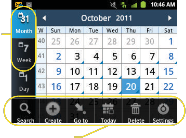
Calendar Menu Options
2. Tap a day to which you would like to add an event to reveal the Create event screen.
3. Tap the Tap to enter title field and enter a title for the event.
2F. Calendar & Tools 95
4. Select a From/To date for the event by tapping the corresponding fields, and adjusting the month, day, and year by tapping ![]() or
or ![]() .
.
• Tap Set when finished.
5. Select a time for the event by tapping the time field and then adjusting the hour and minute by tapping ![]() or
or ![]() .
.
• Tap the AM or PM button to change the value.
• Tap Set when finished.
6. Select a Time zone.
7. Tap the All day field to assign this as an all day event. If assigned as an all day event, the time fields are removed as options.
8. Assign the new calendar event to a current account by tapping the Calendar field and then selecting an account. For this example we are choosing a Google account.
• My calendar are calendar entries that are stored locally on the device and not part of an email account.
• Google/Gmail are calendar entries that are synchronized between your device and your online Google account.

• Corporate are calendar entries that are synchronized between your device and either an Exchange Server or available from within Microsoft® Outlook®.
Note: Some of the previous options appear when compatible email accounts (such as Outlook) have been created and synced. If also supported, additional categories appear: Business, Red Category+, Important, and Personal.
• Tap OK when finished.
9. Enter a location for the event in the Location field.
10. Enter participants in the Participants field.
11. Select Alarm to set a reminder about the event.
Choose from None, On time, 5 mins before,
15 mins before, 1 hour before, 1 day before,
2 days before, 1 week before, or Customize.
12. Select a recurrence cycle for the event by tapping the Repeat field.
96 2F. Calendar & Tools
13. Enter a description for the event in the Description
field.
14. Tap Save to store the new event and synchronize it with your selected account.
Event Reminders
When your device is turned on and you have an event alarm scheduled, there are several ways your device alerts you to scheduled events:
e By playing a short beep.
e By illuminating the backlight.
e By indicating a ![]() icon within the Status bar.
icon within the Status bar.
To view additional options:
1. Tap the Status bar, and then slide your finger down the screen to open the Notifications panel.
2. Tap the upcoming event name from the onscreen list to display the event within the Calendar notifications screen.
3. Tap an option.
• Snooze all to snooze all event reminders for five minutes.
• Dismiss all to dismiss all event reminders.
• Press ![]() to keep these reminders in place and close the Notifications panel.
to keep these reminders in place and close the Notifications panel.
Viewing Events
1. Press ![]() and tap
and tap ![]() >
> ![]() . Once an event has been created, entries are shown in the default
. Once an event has been created, entries are shown in the default
view.
2. To view a Calendar event farther out, tap either
![]()
Week or Month.
3. Tap the day for which you would like to view events. (Your device lists events in chronological order.)
4. To display an event’s details, tap it from the current screen.

Going to the Current Day’s Calendar Menu
� From Calendar view, press and tap Today.
Note: If in the Month view (tab), days containing calendar events are indicated by a blue triangle. Tap a day from this view to display a list of event within the Day tab.
2F. Calendar & Tools 97
Editing an Existing Event
1. Press ![]() and tap
and tap ![]() >
> ![]() .
.
2. Tap an event to reveal its details.
3. Press ![]() and tap Edit.
and tap Edit.
4. Make your modifications (event name, location, participants, alarm, repetition, etc).
5. Tap Save to store the new updates and synchronize them with your assigned account.
Erasing a Day’s Events
1. Press ![]() and tap
and tap ![]() >
> ![]() .
.
2. Tap the Day tab on the Calendar screen.
3. Press ![]() and tap Delete.
and tap Delete.
4. Tap Select all to delete all events on this day.
– or –
Place a checkmark only on those events you want deleted.
5. Tap Delete to erase the selected events and then synchronize this action with your managed account.
Erasing All Events
1. Press ![]() and tap
and tap ![]() >
> ![]() .
.
2. From the main Calendar screen (Month tab view),
press ![]() and tap Delete.
and tap Delete.
3. Tap Select all to delete all events currently available for this managed account.
– or –
Place a checkmark only on those events you want deleted.
4. Tap Delete to erase the selected events and then synchronize this action with your managed account.
Clock
![]()
Your device comes with a built-in Alarm clock function.
Alarm Clock
The alarm clock that has multiple alarm capabilities. There is no limit to the number of alarm events you can create.
98 2F. Calendar & Tools
To create an Alarm event:
1. Press ![]() and tap
and tap ![]() >
> ![]() (Clock). This allows access to the alarm and media application
(Clock). This allows access to the alarm and media application
screen.![]()
![]()
![]()
![]()
![]()
![]()
2 (Alarm) to launch the alarm screen.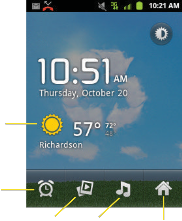
Weather
Information
Alarm
Picture Gallery
Music Player Home screen
Note: Upon your first launch of the Alarm Clock application, two alarm presets are set up by default and ready for you to customize. These alarms are turned off by default.
3. Tap to activate an alarm.

4. To activate an existing alarm, tap the clock icon.
5. To edit an alarm, tap the entry and then tap the
Time field to adjust the alarm time.
• Adjust the hour and minute by tapping either ![]() or
or ![]() .
.
2F. Calendar & Tools 99
• Tap the AM or PM button to change the value.![]()
• Tap Set when finished.
Note: The number of hours and minutes left before the alarm goes off is briefly displayed onscreen after you set the new alarm time.
6. Tap the Repeat field to select a repeating status for the alarm.
• Place a green checkmark adjacent to the desired repetition days and tap OK.
7. Tap Ringtone to select an audio ringtone that will sound with the alarm.
• Tap a ringtone to hear an audio sample.
• Tap OK to accept the ringtone assignment.
8. Tap Vibrate to add a vibration feature to the alarm.
9. Select a unique name for this alarm event by tapping the Label field, entering a new label, and tapping OK.![]()
10. Tap Done to store the new alarm event.
Note: To allow the alarm to sound even while the device is in silent mode, press and tap Settings, then activate the Alarm in silent mode field.
To delete an Alarm event:
1. Press ![]() and tap
and tap ![]() >
> ![]() >
> ![]() .
.
2. Touch and hold a desired alarm event.
3. From the onscreen context menu, tap Delete alarm
and then tap OK.
To disable an Alarm event:
1. Press ![]() and tap
and tap ![]() >
> ![]() >
> ![]() .
.
2. Touch and hold a desired alarm event.
3. From the onscreen context menu, tap Turn alarm off.
– or –
4. Touch the active alarms event’s green icon until it turns gray.
Calculator
![]()
Your device comes with a built-in calculator.
1. Press ![]() and tap
and tap ![]() >
> ![]() (Calculator).
(Calculator).
2. Enter numbers by tapping the onscreen keyboard.
3. Touch and hold CLEAR to clear all numbers.
100 2F. Calendar & Tools
Updating Your Device Firmware
![]()
You can update your device's software using the
Update Firmware option.
Before Updating Your Firmware
Updating your device firmware will erase all user data from your device. You must back up all critical information before updating your device firmware.
Back Up All Data Prior to Update
To back up your Gmail information:
1. Press ![]() >
> ![]() >
> ![]() > Accounts & sync.
> Accounts & sync.
(See “Synchronizing Accounts” on page 65.)
2. Tap the Auto-sync option to enable the feature (checkmark). (See “Configuring Data Synchronization Settings” on page 169.)
• If the Auto-sync option is on, email, Calendar and Contacts automatically synchronize whenever a change is made.
• If the Auto-sync option is off, simply tap ![]() within the account field to reveal the account’s synchronization settings screen.
within the account field to reveal the account’s synchronization settings screen.
To back up your Exchange Mail information:
1. Press ![]() >
> ![]() >
> ![]() > Accounts & sync. (See “Corporate Email (Outlook)” on page 163 and “Synchronizing Accounts” on page 65.)
> Accounts & sync. (See “Corporate Email (Outlook)” on page 163 and “Synchronizing Accounts” on page 65.)
![]()
2. Tap ![]() within the Corporate account field to reveal the account’s synchronization settings screen.
within the Corporate account field to reveal the account’s synchronization settings screen.
3. Toggle the onscreen checkmark to manually synchronize the desired parameters (Contacts or Calendar).
To back up stored text messages:
1. Press ![]() and tap
and tap ![]() .
.
2. Select the text message from the list to view the message thread.
3. Touch and hold on a portion of the text message from the string. The Message options context menu appears.
2F. Calendar & Tools 101
Note: You can back up stored text messages by forwarding them to your own phone number. Open the messages after you have updated your firmware.
![]()
4. Tap Forward.
5. Enter the recipient’s phone number and tap Send.
To back up your Google applications:
Your Google™ application purchases are reloaded remotely and can be re-installed after the update is applied. (See “Selecting and Installing a Google Application” on page 170.)
1. Log into your Google account via the device.
![]()
2. Press and tap ![]() .
.
3. Press and tap Downloads or My apps.
4. Scroll through the list of previously downloaded Google applications and choose the one you wish to reinstall.
5. Follow the onscreen instructions.
102 2F. Calendar & Tools
As an added precaution, to preserve any data on your microSD card, please remove it from your device prior to starting the update process. (See “Removing the microSD Card” on page 108.)
Updating Your Device Firmware
Once you have backed up all your data, use the Update Firmware option to update your device firmware.
1. Press ![]() >
> ![]() >
> ![]() > About phone > System Updates.
> About phone > System Updates.
2. Tap Update Firmware. (Your device automatically downloads and installs any available updates. You may be required to power your device off and back on to complete the software upgrade.)
– or –
1. Locate the System Update Available icon ( ![]() ) in
) in
Notifications.
2. Touch and hold the Status bar, and then slide your finger down the screen.
![]()
3. Tap to open the System Updates screen.![]()
4. Tap Download and follow the onscreen instructions. ( appears within the Status bar to indicate the device is downloading the necessary files.)![]()
5. Touch Restart and install to complete the process.
Note: The Notifications panel can also be opened on the Home screen by pressing and then tapping Notifications.
Confirm Your Current Device Firmware
1. Press ![]() >
> ![]() >
> ![]() > About phone.
> About phone.
2. Scroll to the bottom of the page and locate the
Baseband version read-only field.
Updating Your Profile
![]()
This option allows you to automatically update your online user profile information. If you choose to change your user name and select a new one online, you must then update the user name on your device.
1. Press ![]() >
> ![]() >
> ![]() > About phone > System Updates > Update Profile.
> About phone > System Updates > Update Profile.
![]()
2. Follow the onscreen instructions.
Note: If your data services or account syncing ever seems to go out unexpectedly, use this feature to reconnect with the network.
Updating Your PRL
![]()
This option allows you to download and update the preferred roaming list (PRL) automatically.![]()
1. Press ![]() >
> ![]() >
> ![]() > About phone > System Updates > Update PRL.
> About phone > System Updates > Update PRL.
2. Follow the onscreen instructions.
Update Your Samsung Software
![]()
This option allows you to download and automatically update the latest software version over the air (OTA).
1. Press ![]() >
> ![]() >
> ![]() > About phone > System Updates > Update Samsung Software.
> About phone > System Updates > Update Samsung Software.
2. Follow the onscreen instructions.
2F. Calendar & Tools 103
2G. Voice Services

• Voice Dialing (page 104)
• Opening Menus With Voice Dialer (page 105)
• Voice Recognizer (page 106)
• Text-to-Speech (page 106)
![]()
• Voice Search (page 107)
Important: The Voice Control (Speech to Action) feature will not launch if you are currently in an active menu.
Voice Dialing
![]()
You can use your device’s built-in automatic speech recognition (ASR) software, called Voice Dialer, to dial a phone number in your Contacts or to launch phone functions. All you have to do is to talk into the phone, and ASR will recognize your voice and complete tasks by itself.
Activating Voice Dialer
� Press ![]() and tap
and tap ![]() >
> ![]() (Voice Dialer). The screen displays
(Voice Dialer). The screen displays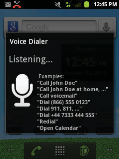
“Listening” and the phone
prompts you to say the name of the command you want to use. To complete your task, simply follow the voice prompts or touch an onscreen option.
Available ASR commands include:
e Call <Name> to call an entry in your Contacts list. (See “Calling a Contact With Voice Dialer” on page 105.)
e Dial <Number> to call a spoken phone number.
e Redial to redial the last number dialed.
e Open <Menu> to jump directly to menu items or applications. (See “Opening Menus With Voice Dialer” on page 105.)
104 2G. Voice Services
Tip: Use Voice Dialer in a quiet environment so it can accurately recognize your commands.
![]()
Calling a Contact With Voice Dialer
1. Press ![]() and tap
and tap ![]() >
> ![]() .
.
2. When you see “Listening,” say “Call” followed by the name and the label for the contact you wish to call. For example, say “Call John Smith Mobile.” The device dials the number stored for the contact “John Smith” with the label “Mobile.”
Calling a Phone Number With Voice Dialer
1. Press ![]() and tap
and tap ![]() >
> ![]() .
.
2. When you see “Listening,” say “Call” followed immediately by a valid string of digits to be dialed, for example, say “Call 555 555 5555.”
Speak naturally and clearly and remember to speak one digit at a time—1-800 should be pronounced “One Eight Zero Zero.”
Opening Menus With Voice Dialer
• If the location is not recognized or the name does
not have a phone number stored in Contacts, you will see an onscreen list of possible options.
• If a name has only a single number, or if you know the name but are not sure which number to call, say “Call” followed by the name only. For example, say “Call John.”
● If the name is recognized and there is only one phone number for the name, your device immediately places the call.
● If there are multiple numbers, you will see a list; tap a number to place the call.
![]()
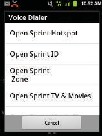
You can jump directly to many menu items or applications by saying “Open” followed by a menu option.![]()
1. Press and tap ![]()
> .
2. When you see “Listening,” say “Open.” list of valid actions is displayed.
2G. Voice Services 105
![]()
3. Tap an option to open the selected menu.
Tip: You can also say "Open" and the name of the item you want to open. You will see the item displayed. Tap OK to open it.
![]()
![]()
Voice Recognizer
1. Press > > >
Voice input & output > Voice recognizer settings.
2. Configure the available options to alter the settings associated with this feature.
• Language elects an input language and associated dialect recognition (if available)
• SafeSearch sets the explicit image filter settings. These settings apply to only Google voice search results. Choose from: Off, Moderate, or Strict.
• Block Offensive words allows you to block recognition of known offensive words or language. (A green check mark indicates the feature is active).
• Personalized recognition allows you to adapt the characteristics of your voice to improve speech regognition accuracy.
• Google Account dashboard redirects you to your Google account, allowing you to manage all of your collected Google data.
3. Press ![]() to return to the previous screen.
to return to the previous screen.
Text-to-Speech
![]()
Allows the device to provide a verbal readout of onscreen data such as messages and incoming caller information (based on Caller ID).
Text-to-Speech Settings
1. Press ![]() >
> ![]() >
> ![]() >
>
Voice input & output > Text-to-speech settings.
2. Configure the available options to alter the settings associated with this feature.
• Listen to an example plays a short example of what the text-to-speech feature will sound like on your device when activated.
106 2G. Voice Services
• Always use my settings overrides any conflicting
Voice Search
application settings with those you set up within
this text-to-speech settings screen. If enabled and
available as a feature, your device will default to using the text-to-speech feature.
• Default Engine sets the speech synthesis engine used for the spoken text. Default is Pico TTS.
![]()
• Install voice data confirms the installation of necessary data required for voice synthesis. Tap this to download and install the free app from Android market.
Important: Before initial use, activate the Install voice data
function to properly activate and use the text-to-speech feature.
• Speech rate adjusts the rate at which onscreen text is spoken by the device. Choose from: Very slow, Slow, Normal, Fast, and Very fast.
• Language assigns the language used by the verbal readout. Choose from English (United States) or Spanish (Spain).
• Pico TTS assigns the TTS settings. These settings must be obtained from the Android Market.
![]()
3. Press to return to the previous screen.
Voice Search works similarly to the Voice Dialer. It uses
built-in voice recognition software to listen to your spoken words, convert those to text, and then launch a Google search using that text.
1. Press ![]() and tap
and tap ![]() >
> ![]() (Voice Search).
(Voice Search).
– or –
From the Home screen, touch ![]() on the right side of the Google Search bar.
on the right side of the Google Search bar.
2. Speak clearly into the microphone. If an error occurs, tap Speak again.![]()
3. From the onscreen Google search page, tap a matching entry.
2G. Voice Services 107
2H. microSD Card

• Your Device’s microSD Card and Adapter (page 108)
• Connecting Your Device to Your Computer (page 110)
• microSD Card Settings (page 114)
• Important Connection Information (page 114)
Your Device’s microSD Card and
Adapter
![]()

The microSD Card
Important: Camera, Camcorder, and Music player features are dependant on having a memory card installed. Although the Samsung Replenish™ comes with a 2GB card (preinstalled), it can support cards of up to 32GB.
Removing the microSD Card
1. Remove the battery cover.
• Grasp the device firmly and locate the cover release latch.
• Place your fingernail in the opening and firmly “pop” the cover off the device (similar to a soda can).
2. Firmly press the card into the slot and release it.
The card should pop partially out of the slot.
3. Remove the card from the slot.
![]()
4. Replace the battery cover.
Note: You can easily damage the microSD card and its adapter by improper operation. Please be careful when inserting, removing, or handling it.
108 2H. microSD Card
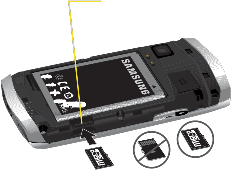
microSD card Slot
Incorrect
Correct
![]()
Re-inserting the microSD Card
1. Remove the battery cover.
• Grasp the device firmly and locate the cover release latch.
• Place your fingernail in the opening and firmly “pop” the cover off the device (similar to a soda can).
2. Orient the card with the gold strips facing down.
![]()
3. Firmly press the card into the slot and make sure that it catches with the push-click insertion.
Note: Make sure the microSD card's gold contacts are facing down.
microSD Icon Indicators
The following icons show your microSD card![]()
WARNING: Do not over-insert the card as this can damage the contact pins.
![]()
Note: Be sure to use only recommended microSD cards (<32GB). Using non-recommended microSD cards could cause data loss and damage your device.
connection status at a glance:
![]() – card has been unmounted (released from use)
– card has been unmounted (released from use)
from the device.
![]() – card is being prepared for use and for mounting.
– card is being prepared for use and for mounting.
![]() – card has been removed.
– card has been removed.
2H. microSD Card 109
WARNING: DO NOT remove a microSD card while the device is accessing or transferring files. Doing so will result in loss or damage of data. Make sure your battery is fully charged before using the microSD card. Your data may become damaged or lost if the battery runs out while you are using the microSD card.

microSD Adapter
The supplied microSD adapter allows you to use microSD cards in other SD-compatible devices, like computers, cameras, and printers. Before using the microSD card with an SD-compatible device, you will need to insert the microSD card into the microSD adapter.
To insert the microSD card into the microSD adapter:
� With the label side of the microSD card facing up, insert the card into the supplied microSD adapter, and gently slide the card until it is fully inserted.
To remove the microSD card from the microSD adapter:
� Hold the front edge of the microSD card, and gently pull it out to remove it from the adapter.
Write Protection
The microSD adapter has a built-in Write Protection lock to prevent accidental overwriting or removal of your data when the microSD card and adapter are inserted in another device.
� Slide the Write Protection lock tab down into the “Lock” position to prevent overwriting of data. To allow data to be added or removed from the microSD card, slide the Write Protection lock tab up into the normal position.
Connecting Your Device to Your
Computer
![]()
![]()
Before using your device’s mass storage capabilities, you need to prepare your device’s data services to synchronize with your desktop or laptop computer. Once you have connected the device to the computer, you can transfer your data to or from the microSD card.
Note: If you experience a setup issue, refer to the
“Troubleshooting the USB Connection” on page 112.
110 2H. microSD Card
Before You Begin
Here is what you will need to have before you can successfully establish a connection between your Samsung Replenish™ and a computer.
e microSD card (internally installed prior to start)
e compatible USB cable (included)
1. With the microSD card installed, connect your device to your computer using a compatible USB cable. (Wait for the connection to be completed. When connected, the host computer will automatically detect your device.)
2. The USB icon (![]() ) now appears in the top left
) now appears in the top left
Notifications area on your device.
3. Tap Mass storage from the Select USB mode
screen.
• Charging uses the connected USB cable to charge the device via your computer’s USB port.
• Mass storage uses the connected USB cable to provide data communication between the device and your computer. The device then appears as an external drive with its own drive letter.
![]()

• Tethered mode allows your computer to obtain an external data connection by using the device’s wireless data services and a wired USB connection. Tap USB tethering to activate tethering mode.
Important: If you are using your device for Tethering, you may be prompted for additional drivers.
The Samsung Mobile Driver for
SPH-M580 contains the ADB, CDMA, & WiMAX drivers that are required for using either Tethering (Phone as a Modem) or development tools.
● Go to www.samsung.com and visit the SPH- M580 Replenish™ Product page, where you can navigate to the Support tab to obtain this driver.
● The online FAQ also provide detailed information about this driver.
● A wireless data connection can be done by using the device’s Sprint Hotspot feature (page 154).
2H. microSD Card 111
![]()
4. Tap Turn on USB storage to join the card to your device. This “mounting” allows you to access and copy files between your computer and your device's microSD card.
Important: The external microSD card MUST BE MOUNTED before your computer detects it and you are able to communicate with it.
5. Locate the newly created drive letter on your computer. You can now begin to use the microSD card as a storage device.
To remove the connection:
� When you have finished transferring data, click the USB device icon on your computer's taskbar, and follow the onscreen instructions to safely unplug the USB cable.
Troubleshooting the USB Connection
If there is ever a circumstance where your setup of the device’s USB connection has an issue, try these troubleshooting tips.
1. Verify your computer is able to access the Internet prior to connection and that this connection is not lost during these troubleshooting procedures.
• Some system connection might require additional setup data available online.
2. Once the device is connected to the computer via USB, select Mass storage to begin the USB connection setup.
• Selecting the Charge option closes the USB data connection.
• Verify the device screen shows Mass storage.
3. From the Found New Hardware Wizard, select Install the software automatically and click Next.
4. Select a connection to the Internet and click Next.
5. If a Cannot install this Hardware screen appears, follow these steps:
• Click Finish.
• From your computer, right-click on the My Computer icon and select Properties (from the onscreen context menu).
• Click the Hardware tab and select the Device
Manager.
• Open the Other devices section from the list. Confirm there is a USB MMC Storage item listed.
112 2H. microSD Card
● This entry indicates an error occurred during the USB driver installation process.
• Using your mouse, right-click on USB MMC Storage and select Update Driver....
• From the Found New Hardware Wizard, select Install the software automatically and click Next > Finish.
Transferring data directly to and from the microSD
You can access the microSD card and use it just as easily as any other communicating storage device.
1. Connect the USB cable and on the phone screen, touch Mass storage.
2. From your computer, double-click My Computer > [device drive letter] entry to display the folders and files currently available on the internal microSD card.
3. Open a folder on your computer and begin the transfer process of files from your computer to the internal card’s target folder.
![]()
Note: This process can be reversed from copying data from the microSD card back to the connected computer.
![]()
To remove the connection:
� When you have finished transferring data, click the USB device icon on your computer’s taskbar, and follow the onscreen instructions to safely unplug the USB cable.
Creating Folders in the microSD Card
1. From your computer, double-click My Computer > [device drive letter].![]()
2. Right-click and select New > Folder.
WARNING: Do not alter or delete the four default folders.
These are used by the phone to parse-out the different file formats and contents.
2H. microSD Card 113
microSD Card Settings
![]()
Viewing Memory in the microSD Card
The Samsung Replenish™ allows you to review the memory allocation of both your device’s internal storage and that of the microSD card.
1. Press ![]() >
> ![]() >
> ![]() > Storage.
> Storage.
2. Review the available information.
• The storage settings page is divided into two sections: SD card and Internal storage.
3. Press ![]() to return to the previous page.
to return to the previous page.
Formatting the microSD Card
Formatting a microSD card permanently removes all files stored on the card.
1. Press ![]() >
> ![]() >
> ![]() > Storage.
> Storage.
2. Touch Unmount SD card to release the microSD card from its use by the device. The ![]() icon appears within the Notifications area to indicate an
icon appears within the Notifications area to indicate an
unmounted internal microSD card.
Note: The microSD card must first be mounted in order to unmount it.
![]()
3. Once released, tap Erase SD card > Erase SD card
> Erase everything.

• Once completely formatted, the card is automatically re-mounted (reconnected for use by the device).
Important: The formatting procedure erases all the data on the microSD card, after which the files CANNOT be retrieved. To prevent the loss of important data, please check the contents before you format the card.
Important Connection Information
![]()
e To avoid loss of data, DO NOT remove the USB cable, the microSD card, or the battery while accessing or transferring files.
114 2H. microSD Card
![]()
e DO NOT use your computer to change or edit folder or file names on the microSD card, and do not attempt to transfer large amounts of data from the computer to the microSD card. Doing so may cause the microSD card to fail.
e DO NOT turn off or restart your computer, or put it into standby mode, while using a mass storage device. Doing so will result in loss or damage of data.

e The microSD card can only be mounted for use by either the device or a connected computer. Prior to accessing the card via a different method, it must first be unmounted from its current device (phone or computer-USB).
Important: The microSD card can only share a connection with one device at a time, either your device or your computer (via its USB connection), not both. You can not browse the contents of the card via your device if they are currently being browsed via your PC.
2H. microSD Card 115
2I. Camera

• Taking Pictures (page 116)
![]()
• Recording Videos (page 120)
Note: All pictures and videos are stored on an external microSD card. The Samsung Replenish™ supports SDHC cards of up to 32GB.
Taking Pictures
![]()
Taking pictures with your device’s built-in camera is as simple as choosing a subject, pointing the lens, and pressing a button.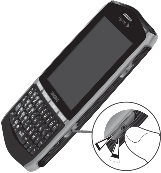
To take a picture:
1. Press and hold the camera key ( ![]() ) located on the side of the device.
) located on the side of the device.
– or –
Press ![]() and tap
and tap ![]() >
> ![]() (Camera) to
(Camera) to
activate the camera mode. (Additional camera
options are available through the camera settings page. See “Camera Settings” on page 117 for more information.)
116 2I. Camera
2. Holding the phone in landscape mode, use the display screen as a viewfinder and aim the camera lens at your subject.
![]()
3. Press or tap ![]() until the shutter sounds.
until the shutter sounds.
(Your device automatically saves the picture to the
DCIM folder on the microSD card.)
Camera Settings
To adjust camera settings, touch the camera’s panel on the right side and select from the following:
• Camera settings to access camera hardware settings:
● Review Mode allows you to access the Image viewer and the various viewing options for a selected picture. Image viewer options are described in the following section. The last picture you took, will be displayed as a thumbnail in the Image viewer icon. Choose from 2 sec or Off.
● Brightness to adjust the overall image brightness. Use the onscreen slider to adjust the value. Choose from 1, 2, 3 (default), 4, or 5.
● Night Mode select a camera setting for better image capture depending upon the brightness. Choose from Off or On.
● Picture Size to set the size of your image. Choose from: 2M Pixels, 1M Pixels, or VGA .
![]()
● Picture quality to set the image quality for your image. Choose from: Superfine (default), Fine, or Normal.
● Color effect to apply different color effects onto images. Choose from: None (default), Mono, Sepia, Negative, or Aqua.
● Camera settings to restore the settings to the default parameters.
• Store location to store the actual location (latitude and longitude) where the image was taken so the photo can later be displayed on Google Maps or used in other social applications. Choose from: On or Off (default).
• White balance to compensate for color differences found within different lighting conditions. Choose from: Auto (default), Incandescent, Daylight, Fluorescent, or Cloudy.
2I. Camera 117
• Metering allows you to set how the camera measures or meters the light source: Centre- weighted, Spot, or Matrix.
![]()
• Zoom to adjust the distance of your image. Choose from: 4x, 3x, 2.3x, 1.7x, 1.3x, or 1x.
Note: Self shot uses the Samsung Replenish™’s front-facing camera lens, so you can still use the display screen to see what you're shooting.
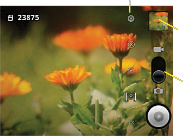
Image settings
Image
Viewer
Mode
View Your Pictures
The Gallery is where you can access the Gallery of stored camera images.
1. Press ![]() and tap
and tap ![]() >
> ![]() (Gallery).
(Gallery).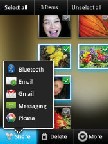
2. Select a folder location (e.g., Camera) and tap an image to view your picture.
● Pressing ![]() from the main Gallery screen reveals gallery-specific options Share,
from the main Gallery screen reveals gallery-specific options Share,
Delete, and More.
● From the image folder, touch and hold any desired
images to select them (indicated by a green
checkmark) and press ![]() for options such as Share (Picasa, Bluetooth, Messaging, Email, and Gmail), Delete, and More (Details, Set as,
for options such as Share (Picasa, Bluetooth, Messaging, Email, and Gmail), Delete, and More (Details, Set as,
Crop, Rotate left, or Rotate right).
118 2I. Camera
● Tap an image to open it, and press ![]() for options such as Share (Bluetooth, Email, Gmail, Messaging, or Picasa), Delete, and More
for options such as Share (Bluetooth, Email, Gmail, Messaging, or Picasa), Delete, and More
(Details, Set as, Crop, Rotate left, or Rotate
Right).
● Press ![]() to return to the previous screen.
to return to the previous screen.
Camera Image Settings
1. Press ![]() and tap
and tap ![]() >
> ![]() .
.
2. From Camera gallery, tap an image icon to open the image.
• Use the zoom buttons (upper-right of the image)
![]()
to zoom in or out.![]()
Note: Picture options can also be accessed by touching and holding the image from the gallery. These options include: Share, Delete, and More.
Note: Tap an onscreen image to display the available options
(Zoom, Slideshow, or Menu).
3. Tap Slideshow to initiate an onscreen slideshow displaying every image in the current folder.
– or –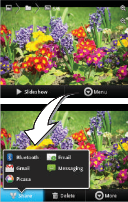
Tap Menu to display the following image menu options:![]()
• Share to activate the picture share menu from which you can choose to share the current image via one of many options:
● Bluetooth to send the image to another device via Bluetooth.
● Gmail to attach your image to a new Gmail email message.
● Messaging to insert your image into a new outgoing MMS message (multimedia text message)..
2I. Camera 119
● Email to attach your image to a new email message.
● Picasa to help you edit, organize, and share your images.
• Delete to delete the image.
• More to open additional image options.
● Details to display image details such as Title, Type, Date taken, Album, Location, Latitude, and Longitude.
● Set as to assign the image to a current Contact icon (display image) or as the Wallpaper (Home screen background).
● Crop to crop the image. Crop the image and tap Save to a new version of the original.
● Rotate to rotate the image. Options include:
Rotate left or Rotate right.
Assigning Pictures
After taking a picture, assign it as a picture ID for a Contacts entry or as the Home screen background image (wallpaper).
1. Press ![]() and tap
and tap ![]() >
> ![]() .
.
120 2I. Camera
2. From the Camera gallery (or other image folder), tap an image icon to open the image.
3. With the picture displayed, tap Menu > More >
Set as, and select an option.
• Contact icon to assign the picture to a Contacts entry as a picture ID. Tap an entry from the Contacts tab, crop the image by dragging the orange border box and tap Save to assign the picture.
• Wallpaper to assign the picture as a background image. Crop the image by dragging the orange border box and tap Save to assign the picture.
Recording Videos
![]()
In addition to taking pictures, you can record, view, and send videos with your device’s built-in video camera.
1. Press and hold the camera key ( ![]() ) located on the side of the device.
) located on the side of the device.
– or –
Press ![]() and tap
and tap ![]() >
> ![]() (Camera) to
(Camera) to
activate camera mode.
2. Tap ![]() to activate camcorder mode.
to activate camcorder mode.
3. Select a Recording Mode.
• Long Video (Normal) to record the video using the default quality.
• Video Mail (MMS) to downgrade the quality to
176x144 for faster message transferal.![]()
4. Holding the phone in landscape mode, use the display screen as a viewfinder and aim the camera lens at your subject.
5. Press ![]() or tap to begin recording.
or tap to begin recording.
Camcorder Settings
Image
Viewer
![]()
Mode
6. Press ![]() or tap to stop recording.
or tap to stop recording.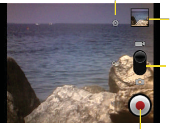
Begin and Stop Recording
2I. Camera 121
Camcorder Settings
![]()
From camcorder mode, touch the camera’s panel on the right side and select from the following:
Note: Access a menus multiple options by tapping the onscreen arrows.
• Camcorder setting to access camcorder hardware settings:
● Color effect to apply different color effects onto videos. Choose from: None (default), Mono, Sepia, Negative, or Aqua.
● Camera settings to restore the settings back to their default values.
• White balance to compensate for color differences found within different lighting conditions. Choose from: Auto (default), Incandescent, Daylight, Fluorescent, or Cloudy.
![]()
• Video quality to set the quality for your video. Choose from: High (30m) or MMS (Low, 30s).
Note: Choosing MMS will downgrade the quality to 176x144.
Video Settings
1. Press ![]() and tap
and tap ![]() >
> ![]() .
.
2. From Camera gallery, tap a video icon to begin video playback.
– or –
Touch and hold the video icon to select the video and display the following video menu context menu options:
• Select all to place a checkmark on all files within the current folder.
• Unselect all to remove checkmarks on all files within the current folder.
122 2I. Camera

• Share to share the selected video via one of many options:
![]()
● Bluetooth to send your selected videos to an external Bluetooth- compatible device.
● Email to attach your video to a new email message.
● Gmail to attach your video to a new
Gmail email message.
● Messaging to attach your video to a new MMS
message.
● YouTube to upload your video to YouTube.
• Delete to delete the current video.
• More to open additional video options such as
Details.
2I. Camera 123
2J. Bluetooth

• Turning Bluetooth On and Off (page 124)
• Using the Bluetooth Settings Menu (page 125)
• Pairing Bluetooth Devices (page 126)
• Sending Contacts via Bluetooth (page 127)
• Disconnecting Bluetooth Connection During an Active
Call (page 129)
About Bluetooth
Bluetooth is a short-range communications technology that allows you to connect wirelessly to a number of Bluetooth devices, such as headsets and hands-free car kits, and Bluetooth-enabled handhelds, computers, printers, and wireless devices. The Bluetooth communication range is usually up to approximately
30 feet.
Turning Bluetooth On and Off
![]()

By default, your device’s Bluetooth feature is set to Off. Turning Bluetooth on activates the internal Bluetooth antenna.
Note: Activating Bluetooth can drain your battery faster and reduce your available usage times. It is recommended that if you do not need it active, turn it off.
It is also recommended to turn off your Bluetooth within locations that prohibit its use.
To turn Bluetooth on:
1. Press ![]() >
> ![]() >
> ![]() >
>
Wireless & networks > Bluetooth settings.
2. Tap Bluetooth to activate it (a green checkmark indicates it is active). When active, ![]() appears
appears
within the Status area.
To turn Bluetooth off:
� Press ![]() >
> ![]() and tap
and tap ![]() > Wireless & networks > Bluetooth settings.
> Wireless & networks > Bluetooth settings.
• Tap to remove the green checkmark and deactivate Bluetooth.
124 2J. Bluetooth
Bluetooth Status Indicators
The following icons show your Bluetooth connection status at a glance:
![]() – Bluetooth is active
– Bluetooth is active
![]()
– Bluetooth is connected (paired) and communicating
[no icon] – Bluetooth is disabled (default status)
Using the Bluetooth Settings Menu
![]()
The Bluetooth settings menu allows you to set up many of the characteristics of your device’s Bluetooth service, including:
e Entering or changing the name your device uses for
Bluetooth communication and description
e Setting your device’s visibility (or “discoverability”) for other Bluetooth devices
e Displaying your device’s Bluetooth address
To access the Bluetooth Settings menu:
1. Press ![]() >
> ![]() >
> ![]() >
>
Wireless & networks > Bluetooth settings.
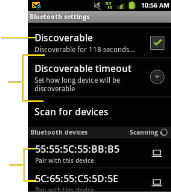
2. Set your Bluetooth options: Bluetooth, Device name, Discoverable, Discoverable timeout, and Scan for devices.![]()
Bluetooth Active
Bluetooth Settings
Bluetooth
Devices
2J. Bluetooth 125
To change your Bluetooth name:
1. Verify your Bluetooth is active.
2. From the Bluetooth settings page, tap Device name, and enter a new name.
3. Tap OK to complete the rename process.
To make your device visible:
1. Verify your Bluetooth is active.
2. From the Bluetooth settings page, tap Discoverable
![]()
• Making your device visible allows it to be detected by other devices for pairing and communication.
Note: Your device is visible for up to 120 seconds
(2 minutes). This value appears as a countdown within this field.
To set the time your device is discoverable:
1. Verify your Bluetooth is active.
2. From the Bluetooth settings page, tap Discoverable timeout. Choose from 2 Minutes, 5 Minutes, 1 Hour, or Never.
To scan for Bluetooth devices:
1. Verify your Bluetooth is active.
2. From the Bluetooth settings page, tap Scan for devices to search for visible external Bluetooth- compatible devices such as headsets, devices, printers, and computers.
Pairing Bluetooth Devices
![]()
Paired Devices
The Bluetooth pairing process allows you to establish trusted connections between your device and another Bluetooth device. When you pair devices, they share a passkey, allowing for fast, secure connections while bypassing the discovery and authentication process.
To pair your device with another Bluetooth device:
1. Verify your Bluetooth is active.
2. From the Bluetooth settings page, tap Discoverable.
Your device must be visible to successfully pair with an external device.
126 2J. Bluetooth
3. Tap Scan for devices. (Your device will display a list of discovered in-range Bluetooth devices.)
4. Tap a device from the list to initiate pairing.
5. Enter the passkey or PIN code and tap OK.
6. The external device will then have to also accept the connection and enter your device’s PIN code.

• Once successfully paired to an external device, appears within the Status area.

Note: Due to different specifications and features of other Bluetooth-compatible devices, display and operations may be different, and functions such as transfer or exchange may not be possible with all Bluetooth- compatible devices.
Note: Pairing between two Bluetooth devices is a one-time process. Once a pairing has been created, the devices will continue to recognize their partnership and exchange information without having to re-enter a passcode again.
To disconnect a paired device:
Disconnecting a paired device breaks the connection between the device and your Samsung Replenish™, but retains the knowledge of the pairing. At a later point when you wish to reconnect the device, there is no need to setup the connection information again.
1. Verify your Bluetooth is active.
2. From the Bluetooth settings page, touch and hold the name of the previously paired device.
![]()
![]()
3. Tap Unpair to confirm disconnection.
Note: Disconnections are manually done but often occur automatically if the paired device goes out of range of your Samsung Replenish™ or it is powered off.
Sending Contacts via Bluetooth
![]()
Depending on your paired devices’ settings and capabilities, you may be able to send pictures, Contacts information, or other items using a Bluetooth connection.
2J. Bluetooth 127
Note: Prior to using this feature, Bluetooth must first be enabled, and the recipient’s device must be visible.
In addition to Contact’s information, other file types

(video, image, or audio) can be sent using Bluetooth.

Note: If no devices are detected, tap Scan devices to begin a new search.
1. Press and tap > .
128 2J. Bluetooth
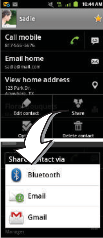
2. Touch an entry to open its overview page.
3. Press ![]() > Share > Bluetooth.
> Share > Bluetooth.
4. Tap a paired device.
• The external Bluetooth device must be visible and communicating for the pairing to be successful.
See “Sharing Contacts” on page 90.
Disconnecting Bluetooth
Connection During an Active Call
![]()
� During an active call, where the audio is being routed through a connected Bluetooth device (headset or hands-free connection), tap Bluetooth to route the device’s audio through the connected Bluetooth headset (On) or through the speaker (Off).![]()
• When the call is routed to a Bluetooth headset, the current call area is surrounded by a blue box, the Bluetooth button indicates it’s on, and shows the Bluetooth call icon ( ![]() ).
).
• When turned off, the call is routed through either

the earpiece or speaker, the call area is surrounded by a green box, the Bluetooth button indicates its off, and shows ( ).
Note: Communication can be toggled between the Bluetooth headset and the device speaker by tapping the Headset button On or Off.
2J. Bluetooth 129

Section 3
Sprint Service
![]()
3A. Sprint Service: The Basics
Always use a password to protect against unauthorized access.![]()
1. Press and hold 1 .
• Voicemail (page 132)
• Text Messaging (SMS) (page 133)
• Multimedia Messaging (MMS) (page 135)
• Caller ID (page 139)
• Call Waiting (page 139)
• Making a 3-Way Call (page 140)
• Call Forwarding (page 141)
• Roaming (page 141)
Voicemail
![]()
Setting Up Your Voicemail
Your phone automatically transfers all unanswered calls to your voicemail, even if your phone is in use or turned off. You should set up your Sprint Voicemail and personal greeting as soon as your phone is activated.
2. Follow the system prompts to:
• Create your password.
• Record your name announcement.

• Record your greeting.
Note: Voicemail Password
Sprint strongly recommends that you create a
password when setting up your voicemail to protect against unauthorized access. Without a password, anyone who has access to your phone is able to access your voicemail messages.
Voicemail Notification
There are several ways your phone alerts you to a new message:
e By displaying a message on the screen.
e By sounding the assigned ringer type.
e By the LED blinking red.
![]()
e By displaying at the top of your screen.
132 3A. Sprint Service: The Basics
New Voicemail Message Alerts
When you receive a new voice message, your phone alerts you and prompts you to call your voicemail.
To call your voicemail:
� Press and hold 1 .
Retrieving Your Voicemail Messages
You can review your messages directly from your wireless phone or from any other touch-tone phone. To dial from your wireless phone, either speed dial your voicemail or use the menu keys.
Using One-Touch Message Access
Note: When you are roaming off the Nationwide Sprint
Network, you may not receive notification of new voicemail messages. Sprint recommends that you periodically check your voicemail by dialing your ten-
![]()
� Press and hold 1
voicemail box.)
. (Your phone will dial your
digit wireless phone number. When your voicemail answers, press and enter your passcode.
Roaming rates apply when you access voicemail while roaming off the Nationwide Sprint Network.
Your phone accepts messages even when it is turned off. However, your phone notifies you of new messages only when it is turned on and you are in a Sprint service area.
Text Messaging (SMS)
![]()
![]()
With text messaging (SMS), you can send and receive instant text messages between your wireless device and another messaging-ready phone. When you receive a new message, it will automatically display on your device’s screen.
Messaging is available via the Messaging application
in your Applications screen. This icon ( ![]() ) appears in Status bar area when a new text message is
) appears in Status bar area when a new text message is
received.
3A. Sprint Service: The Basics 133
Note: See your service plan for applicable charges for text messaging and SMS voice messaging.
![]()
Viewing Notifications of Received Messages
When you receive a message, your device notifies you by displaying an icon within the Notification area at the top left of your Home screen.
• ![]() indicates a new text or MMS messages were received.
indicates a new text or MMS messages were received.
1. Press ![]() >
> ![]() >
> ![]() > Notifications.
> Notifications.
– or –
Touch and hold the Status bar, then slide your finger down the screen. (See “Using the Notifications Panel” on page 41.)
2. Tap a message entry to open the Messaging application.
Composing Text Messages
![]()
![]()
1. Press and tap > New message.
2. Tap the To field and enter a Contacts name, a mobile phone number, or an email address using the onscreen keyboard.
Note: If you are using an onscreen keyboard, you can switch between the default Swype to Android keyboard text entry method. Touch and hold either the To or the Type to compose field, tap Input method, and select your preferred method.
3. If applicable, tap a matching entry from the onscreen drop-down list. This list is populated by matches found from your managed accounts.
4. Touch the Type to compose field and enter your message.
5. Review your message and tap Send.
Accessing Text Messages
To read a text message:
� When you receive a text message, you will see it listed within the Messaging screen. Touch the message to open the message and then scroll down and view its entire content.
134 3A. Sprint Service: The Basics
To reply to a text message:
1. While the message is open, tap the Type to compose field and then type your reply message.
2. Compose your reply or
Multimedia Messaging (MMS)
![]()
With multimedia messaging (MMS), you can send and receive instant text messages that contain text, pictures,
use the preset messages or icons.
3. Review your reply and tap Send.
– or –
You may select additional messaging options by pressing![]() , and then tapping Send.
, and then tapping Send.
• Options include: Call, View Contact, Add subject, Attach, Insert Smiley, or More (Delete thread, All threads).
Current Recipient
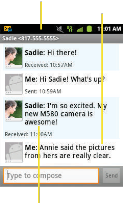
My Text
audio, recorded voice, or a picture slideshow.![]()
Messaging is available via the Messaging application in your Applications screen.
Note: See your service plan for applicable charges for text messaging and MMS voice messaging.
Composing MMS Messages
![]()
Composing MMS messages is exactly the same as composing text messages, except that you attach a picture, a video, or an audio file to the message.![]()
1. Press and tap > New message.
Note: From the Messages screen, you can also touch New message to begin creating a new outgoing message.
Reply Bubble
3A. Sprint Service: The Basics 135
2. Tap the To: field and enter a Contact's name, a mobile phone number, or an email address. As you enter text and numbers, matching contacts appear onscreen.
• If applicable, tap an available matching recipient or continue entering the phone number or email address.
3. Touch the Type to compose field and enter your message.
4. Press ![]() and tap Attach.
and tap Attach.
5. Select a multimedia attachment type:
• Pictures: Opens the Gallery application. Use the onscreen navigation to select the picture you wish to send with the outgoing message.
• Capture picture: Opens the camera application. Take a picture, then tap OK to use this image in your message. See “Taking Pictures” on
page 116.
• Videos: Opens the Gallery application. Use the onscreen navigation to select a video and attach it to your outgoing message.
• Capture video: Opens the camcorder application. Shoot a video, then tap OK to use this video in your message. See “Recording Videos” on
page 120.
• Audio: Opens the Select audio menu. Use the onscreen navigation to select an audio file and tap OK.
• Record audio: Opens the message recorder.
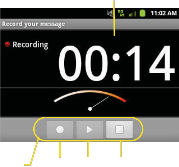
Recording duration
Controls Record Play Stop
136 3A. Sprint Service: The Basics
• Slideshow: Opens the Edit slideshow menu.
● Touch Add slide to create a new slide (this is a placeholder for new images to be added, similar to a playlist).
● Touch the created slide (example, Slide 1), tap Add picture, and then select the picture you want to add to the slide.
● Tap the text field below the image to enter a caption for the picture.
● When finished, tap Done to attach the slideshow to your message.
6. When you are finished creating your new MMS
message, touch Send.
To view and play a multimedia message:
1. Press ![]() and tap
and tap ![]() .
.
2. From the message list, tap a multimedia message
to open its contents.
Current Image
Image Navigation

3. While the message is open, tap the play icon (on a video or audio file) to play back the file or tap an image to view a picture.
![]()
Tip: The file attachment on the MMS message can be saved to the microSD card. To save the attachment, touch and hold the file and tap Copy attached to SD card from the Message options context menu.
To reply to a multimedia message:
1. Press ![]() and tap
and tap ![]() .
.
2. From the message list, tap a multimedia message
to open its contents.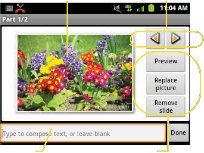
Caption Field
Slideshow Controls
3. While the message is open, tap the Type to compose field and then type your reply message.
3A. Sprint Service: The Basics 137

4. Once complete, tap Send.
Note: When replying to a text message with an MMS message, first open the text message, press and tap Add subject or Attach. The original text message is then automatically converted into a multimedia message.
Deleting a Message or Message Thread
1. Press ![]() and tap
and tap ![]() .
.
2. Touch and hold the message entry (onscreen
bubbles) to display the context menu.
3. Tap Delete thread and once prompted, tap Delete to complete the process. (From within a message, you may need to press ![]() to display the Delete thread option.)
to display the Delete thread option.)
Adjusting Message Settings
1. Press ![]() and tap
and tap ![]() .
.
2. From within the Messaging screen, press ![]() and tap Settings.
and tap Settings.
3. Adjust the following fields according to your needs:
• Delete old messages: Enable this option to delete older text messages that exceed the defined maximum number of text messages limit set below.
• Text message limit: Sets the maximum number of text messages that can be stored on the device (per conversation).
• Multimedia message limit: Sets the maximum number of multimedia messages that can be stored on the device (per conversation).
• Auto-retrieve: Enable this option to automatically retrieve the entire content of your MMS message. When checked, the MMS message header, message body, and any attachments will automatically download to your device.
● If you disable this option, only the MMS message header will be retrieved and shown in the message list.
• Roaming auto-retrieve: Disable this option if you only desire the MMS message headers to download while roaming. Enable this option to automatically download your complete multimedia messages even while roaming.
138 3A. Sprint Service: The Basics
• Notifications: Enable this option if you wish to receive a notification in the status bar when a new text or multimedia message arrives.
• Select ringtone: Allows you to select a ringer to sound when a new message is received. Tap this option, and then select a ring tone that is specific to new text and multimedia messages. A sample will briefly be played upon selection.
• Vibrate: Enable this option if you want the device to vibrate when a new text or multimedia message is received.
Caller ID
![]()
![]()
Caller ID allows people to identify a caller before answering the phone by displaying the number of the incoming call. If you do not want your number displayed when you make a call, follow these steps.
To permanently block your number, call Sprint
Customer Service.
Call Waiting
![]()
When you’re on a call, Call Waiting alerts you to incoming calls by sounding two beeps. Your device’s screen informs you that another call is coming in and displays the caller’s phone number (if it is available and you are in digital mode).
To respond to an incoming call while you’re on a call:
![]()
![]()
� Before accepting the incoming call, drag the onscreen caller ID to one of the following onscreen options:
• to answer the new
![]()
![]()
1. Press and tap >
onscreen dialer.
Phone
to access the
call. The first caller is placed on hold.![]()
2. Tap
![]()
![]()
6 M N O 7 P Q R S .
![]()
• to send the call to
3. Enter a phone number and then press .
your voicemail box.![]()
Call Swap
3A. Sprint Service: The Basics 139
To switch back to the first caller:
� From the In-Call options screen, tap Swap calls.
Making a 3-Way Call
![]()
![]()
With 3-Way calling, you can talk to two people at the same time. When using this feature, the normal airtime rates will be charged for each of the two calls.
1. Press ![]() and tap
and tap ![]() > to access the onscreen dialer.
> to access the onscreen dialer.
2. Make your call to the first recipient.
3. Once you have established the connection, tap
Add call.
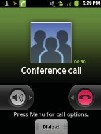
![]()
4. Enter the second caller’s phone number and tap ![]() or select a number from your Contacts
or select a number from your Contacts
( ). (Your first call is automatically put on hold.)
5. When you’re connected to the second party, press ![]() and tap Merge calls to combine both calls into a single 3-way call.
and tap Merge calls to combine both calls into a single 3-way call.
If one of the people you called hangs up during your call, you and the remaining caller stay connected. If you initiated the call and are the first to hang up, all callers are disconnected.
140 3A. Sprint Service: The Basics
Call Forwarding
![]()
Call Forwarding lets you forward all your incoming calls to another phone number – even when your device is turned off. You can continue to make calls from your phone when you have activated Call Forwarding.![]()
To activate Call Forwarding:
1. Press ![]() and tap
and tap ![]() > to access the onscreen dialer.
> to access the onscreen dialer.
Roaming
![]()
Roaming Icon
Your display screen always lets you know when you’re off the Nationwide Sprint Network. Anytime you are roaming, the phone displays the roaming icon (![]() ). If
). If
you are roaming on a digital system, you will see the
roaming icon along with the text – Digital Roam – .
Roaming on Other Digital Networks
![]()
2. Tap
![]()
![]()
7 P Q R S 2 A B C .
When you’re roaming on digital networks, your call
3. Enter the area code and phone number to which
you want your calls forwarded.
4. Tap ![]() .
.![]()
To deactivate Call Forwarding:
1. Press ![]() and tap
and tap ![]() > to access the onscreen dialer.
> to access the onscreen dialer.![]()

quality and security is similar to the quality you receive when making calls on the Nationwide Sprint Network. However, you may not be able to access certain features, such as data services, depending on the available network.
Note: If you’re on a call when you leave the Nationwide Sprint
Network, and your call is dropped in an area where you
![]()
2. Tap
![]()
![]()
![]()
7 P Q R S 2 A B C 0 +
. (You will
think Sprint service is available, turn your phone off and
![]()
see a message and hear a tone to confirm the deactivation.)
Note: You are charged a higher rate for calls you have forwarded.
on again to reconnect to the network.
3A. Sprint Service: The Basics 141
Checking for Voicemail Messages While
Roaming
When you are roaming off the Nationwide Sprint Network, you may not receive on-phone notification of new voicemail messages. Callers can still leave messages, but you will need to periodically check your voicemail for new messages if you are in a roaming service area for an extended period of time.
1. Dial your ten-digit wireless phone number and tap
![]() .
.
2. When you hear your voicemail greeting, tap ![]() .
.
3. Enter your password at the prompt and follow the voice prompts.
When you return to the Nationwide Sprint Network, voicemail notification will resume as normal.
142 3A. Sprint Service: The Basics
3B. Web and Data Services

• Getting Started With Data Services (page 143)
• Navigating the Web (page 145)
• Wi-Fi (page 151)
• Email (page 154)
• Books (page 169)
• Using the Android Market (page 170)
• Downloading Applications From the Web (page 172)
• Sprint Applications (page 172)
• Data Services FAQs (page 176)
![]()
Getting Started With Data Services
![]()

With your Sprint service, you are ready to start enjoying the advantages of data services. This section will help you learn the basics of using your data services, including managing your user name, launching a data connection, and navigating the Web with your device.
Important: Certain data services requests may require additional time to process. While your device is loading the requested service, the touchscreen may appear unresponsive when in fact they are functioning properly. Allow the device some time to process your data usage request.
Your User Name
When you buy your device and sign up for service, you’re automatically assigned a user name, which is typically based on your name and a number, followed by “@sprintpcs.com.” (For example, the third John Smith to sign up for Sprint data services might have [email protected] as his user name.)
3B. Web and Data Services 143
When you use data services, your user name is submitted to identify you to the Nationwide Sprint Network. Your user name is automatically programmed into your device. You don’t have to enter it.
Updating Your User Name
If you choose to change your user name and select a new one online, or make any changes to your services, you must then update the profile on your device.
1. Press ![]() >
> ![]() >
> ![]() > About phone > System updates.
> About phone > System updates.
2. Tap Update Profile.
Launching a Web Connection
![]()
� Press ![]() and tap
and tap ![]() >
> ![]() (Browser). (Your data connection starts and you see the home page.)
(Browser). (Your data connection starts and you see the home page.)
Note: Internet connections can be made either through the Sprint 3G or via Wi-Fi (configured within the > Wireless & networks page).
While connecting, you may see an animation. Once complete, you are connected to the default home page.![]()
Tip: To change the device’s default launch page to your current page, press and tap More > Settings > Set home page.
![]()
Note: The Browser automatically launches when a Web link is touched from within either an email or text message.
Data Connection Status and Indicators
Your device displays the current status of your data connection through indicators at the top of the screen. The following symbols are used:![]()
![]()
Your device is connected to the high-speed Sprint Mobile Broadband Network (EVDO). When the signal bands are animated, your device is transferring data (for example, when you are opening a Web page); when the signal bands are gray, your device is connected to the network but is not currently transferring data (for example, when you are viewing a Web page that is completely open). In either state, you can receive incoming calls.
144 3B. Web and Data Services
If you do not see an indicator, your phone does not have a current data connection. To launch a connection, see “Launching a Web Connection” on page 144.
Navigating the Web
![]()

Navigating through menus and websites during a data session is easy once you have learned a few basics.
Note: Prior to gaining access to the SprintWeb home page, you may be asked to enter your 10-digit PCS phone number and tap OK. Entering your phone number is not required for access to other Web pages.
Scrolling
As with other parts of your device’s menu, you’ll have to drag up and down to see everything on some websites.
To scroll through a website’s page:
� In a single motion, touch and drag across or up and down a page.
![]()
Selecting
To select onscreen items or links:
� Drag across a page, and then touch or tap an onscreen link to select the link.
Links, which are displayed as underlined text, allow you to jump to Web pages, select special functions, or even place phone calls.
Pinching and Zooming
Zooming in and out on a Web page can be done now without the need of an onscreen zoom tool. Just use your fingers to pinch in or spread out on the screen.
To zoom in:
1. Place your thumb and index finger on the screen.
2. Expand them outward (spread) to zoom in.
To zoom out:
1. Place your thumb and index finger on the screen.
2. Bring them together (pinch) to zoom out.
3B. Web and Data Services 145
Going Back
To go back one page:
� Press ![]() on your device. Repeat this process to keep going back through your Web page history of recently visited pages.
on your device. Repeat this process to keep going back through your Web page history of recently visited pages.
Going to a Web Page
1. Tap the Address field (top of the browser window)
and enter a new Web address.
• As you enter the address, possible matches are displayed within an onscreen list. Tap an entry to launch the desired website.
2. Tap Go to launch the new page (only from the![]()
Android keypad).
Note: You can use for deleting text (like a BACKSPACE
key) when you are entering text.
Browser Menu
The browser menu offers additional options to expand your use of the Web on your device.
Opening the Browser Menu
The browser menu may be opened anytime you have an active data session, from any page you are viewing.
� From any open Web page, press ![]() . (You will see the browser menu.)
. (You will see the browser menu.)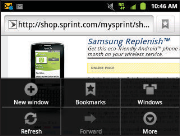
Options available within the browser menu include:
e New window: Launches a new Internet window while maintaining the current Web page active.
e Bookmarks: Allows you to access and manage your bookmarks.
146 3B. Web and Data Services
e Windows: Displays the currently active browser windows as an onscreen list. Tap a window entry to launch that window.
e Refresh: Reloads the current Web page.
e Forward: Returns you to a previously viewed page.
e More: Provide additional browser options:
• Add bookmark: Assigns the current Web page as a new bookmark.
• Find on page: Searches the current Web page for a word.
• Select text: Selects text from the current Web page.
• Page info: Displays the Name and URL (website address) of the site you’re currently viewing.
• Share page: Allows you to send a URL via Gmail, SMS, or Work Email (Outlook).
• Downloads: Keeps a list of previously downloaded content.
• Settings: Lets you configure and manage your browser settings.
![]()
Selecting Text on a Web Page
1. While on an active Web page, press ![]() > More > Select text.
> More > Select text.
2. Scroll to the area of the webpage containing the desired text.
3. Touch and hold the screen area containing the selected text.
4. Touch and drag across the screen and highlight the desired text. Any selected text will appear highlighted.
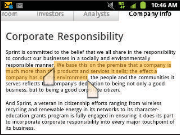
3B. Web and Data Services 147
5. Touch any area of the selected text to copy the selection to the clipboard.
Going to a Specific Website
To go to a particular website by entering a URL (website address):
1. Tap the URL field and enter a website address.
• As you type the address, if your desired website appears within the suggested sites list, tap the entry to begin surfing.
![]()
2. Tap Go.
Note: Not all websites are viewable on your device.
Adjusting Page Content Settings
1. Press ![]() to open the browser menu.
to open the browser menu.
2. Tap More > Settings.
Options available within the browser menu include:
• Text size: Adjusts the current onscreen text size. Options include: Tiny, Small, Normal, Large, or Huge.
• Default zoom: Sets the default browser viewing size. Choose from: Far, Medium, or Close.
• Open pages in overview: Provides an overview of recently opened pages.
• Text encoding: Adjusts the current text encoding.
• Block pop-up windows: Prevents popup advertisement or windows from appearing onscreen. Remove the checkmark to disable this function.
• Load images: Allows Web page images to be loaded along with the other text components of a loaded website.
• Auto-fit pages: Allows web pages to be resized to fit as much of the screen as possible.
• Landscape-only display: Displays pages only in the wider landscape screen orientation. Uncheck to view the page in Portrait mode.
• Enable JavaScript: Enables javascript for the current Web page. Without this feature, some pages may not display properly. Remove the checkmark to disable this function.
• Enable plug-ins: Allows you to determine the way your device handles program enhancements. Select either Always on, On demand or Off.
148 3B. Web and Data Services
• Open in background: New pages are launched in a separate page and displayed behind the current one. Remove the checkmark to disable this function.
• Set home page: Sets the current home page for the Web browser (page 150).
Adjusting Browser Privacy Settings
1. Press ![]() to open the browser menu.
to open the browser menu.
2. Tap More > Settings.
3. Navigate to the Privacy settings area and select from one of the following privacy settings:
• Clear cache: Deletes all currently cached data. Tap OK to complete the process.
• Clear history: Clears the browser navigation history. Tap OK to complete the process.
• Accept cookies: Allows sites that require cookies to save and read cookies from your device.
• Clear all cookie data: Clears all current browser cookie files.
• Remember form data: Allows the device to store data from any previously filled-out forms. Remove the checkmark to disable this function.
![]()
• Clear form data: Deletes any stored data from previously filled out forms. Tap OK to complete the process.
• Enable location: Allows sites to request access to your current location (using the built-in GPS).
• Clear location access: Clears location access for all websites.
4. Press ![]() to return to the browser.
to return to the browser.
Adjusting Browser Security Settings
1. Press ![]() to open the browser menu.
to open the browser menu.
2. Tap More > Settings.
3. Navigate to the Security settings area and select from one of the following privacy settings:
• Remember passwords. Stores usernames and passwords for visited sites. Remove the checkmark to disable this function.
• Clear passwords. Deletes any previously stored usernames or passwords. Tap OK to complete the process.
3B. Web and Data Services 149
• Show security warnings. Notifies you if there is a security issue with the current website. Remove the checkmark to disable this function.
4. Press ![]() to return to the browser.
to return to the browser.
Creating Website Settings
1. Press ![]() to open the browser menu.
to open the browser menu.
2. Tap More > Settings > Website settings. These advanced settings can be configured for individual sites (e.g., Clear location access).
Resetting the Browser to Default
1. Press ![]() to open the browser menu.
to open the browser menu.
2. Tap More > Settings > Reset to default.
3. Tap OK to complete the process.
Setting the Browser Home Page
1. Press ![]() to open the browser menu.
to open the browser menu.
2. Tap More > Settings > Set home page.
3. Delete the current address and enter a new web page.
4. Tap OK to complete the process.
Setting the Search Engine
1. Press ![]() to open the browser menu.
to open the browser menu.
2. Tap More > Settings > Set search engine. Choose from Google, Yahoo!, or Bing.
Creating Bookmarks
1. From any open Web page, tap ![]() (Bookmarks).
(Bookmarks).
Three tabs are revealed:
• Bookmarks: Displays a list of your current Web bookmarks.
• Most visited: Displays a list of your most frequently visited websites. Tap an entry to launch the selected page.
• History: Displays a record of your browsing history. These records are organized into folders such as: Today and Last 7 days.
2. Tap Add (first entry in the Bookmarks tab).
3. Enter a descriptive Name for the new bookmark and the Website Location.
4. Tap OK to store the new entry to your Bookmarks list.
150 3B. Web and Data Services
Creating Bookmarks From Other Tabs
1. From any open Web page, tap ![]() (Bookmarks).
(Bookmarks).
2. Tap either the Most visited or History tab.
3. Touch and hold an entry from the list to display an onscreen popup menu.
4. Tap Add bookmark to add the selected entry to your current list of bookmarks.
– or –
1. Repeat steps 1 and 2.
2. Tap the star icon adjacent to a website address.
The star now turns gold. This adds the “starred”
website to your current Bookmarks list.
Creating a New Homepage
1. From any open Web page, tap ![]() (Bookmarks).
(Bookmarks).
2. Tap either Most visited or History.
3. Touch and hold an entry from the list to display an onscreen popup menu.
4. Tap Set as homepage to assign the selected entry as your new homepage.![]()
Adding Bookmarks to Your Home Screen
1. From any open Web page, tap ![]() (Bookmarks).
(Bookmarks).
2. Touch and hold an existing entry from the list to display an onscreen popup menu.
3. Tap Add shortcut to Home to add the selected entry to your Home screen.
Wi-Fi
![]()
About Wi-Fi
Wi-Fi (short for "wireless fidelity") is a term used for certain types of wireless local area networks (WLAN). These device types use an 802.11 wireless specification to transmit and receive wireless data.
3B. Web and Data Services 151
Wi-Fi communication requires access to an existing and accessible Wireless Access Point (WAP). These WAPs can either be Open (unsecured) as within most Hot Spots, or Secured (requiring knowledge of the Router name and password).
The Samsung Replenish™ is capable of communication with devices using 802.11n speeds (802.11n connections should support data rates of over
100 Mbps). 802.11n also offers better communication ranges over earlier Wi-Fi standards due to increased signal intensity. The Samsung Replenish™ is backwards compatible with previous WAP technologies (802.11b and 802.11g).
Turning Wi-Fi On and Off
By default, your device’s Wi-Fi feature is turned off. Turning Wi-Fi on makes your device able to discover and connect to compatible in-range WAPs.
Turn Wi-Fi on:
1. Press ![]() >
> ![]() >
> ![]() > Wireless & networks > Wi-Fi settings.
> Wireless & networks > Wi-Fi settings.
2. Tap the Wi-Fi field to activate the feature (green checkmark indicates active). The device scans for available in-range wireless networks.
To turn Wi-Fi off:
1. Press ![]() >
> ![]() >
> ![]() >
>
Wireless & networks > Wi-Fi settings > Wi-Fi.
![]()
2. Tap to remove the green checkmark and deactivate Wi-Fi.
Note: Use of wireless data connections such as Wi-Fi and Bluetooth can cause an added drain to your battery and reduce your use times.
To connect to a Wi-Fi network:
1. Press ![]() >
> ![]() >
> ![]() > Wireless & networks > Wi-Fi settings.
> Wireless & networks > Wi-Fi settings.
![]()
• The network names and security settings (Open network or Secured with xxx) of detected Wi-Fi networks are displayed in the Wi-Fi networks section.
Note: When you select an open network, you will be automatically connected to the network.
152 3B. Web and Data Services
2. To manually add your new network connection:
• Touch Add Wi-Fi network.
• Enter the Network SSID. This is the name of your
Wi-Fi network.
• Tap the Security field and select a security option. This must match the current security setting on your target network.
• If secured, you will also need to enter the wireless password. The show password option, reveals the password as you type it instead of showing only asterisks (****).
• Tap Save to store the new information and connect to the Wi-Fi network.
Note: The next time your device connects to a previously accessed or secured wireless network, you are not prompted to enter the wireless password again, unless you reset your device back to its factory default settings.
To manually scan for a Wi-Fi network:
1. Press ![]() >
> ![]() >
> ![]() > Wireless & networks > Wi-Fi settings.
> Wireless & networks > Wi-Fi settings.
![]()
2. Press and tap Scan.![]()
Wi-Fi Status Indicators
The following icons show your Wi-Fi connection status at a glance:
![]() – Wi-Fi is connected and active.
– Wi-Fi is connected and active.
– Wi-Fi active but there is a communication ![]() issue with the target Wireless Access Point
issue with the target Wireless Access Point
(WAP).
Using the Wi-Fi Settings Menu
The Wi-Fi settings - Advanced menu allows you to set up many of your device’s Wi-Fi service, including:
e Setting your Wi-Fi sleep policy
e Viewing your device’s MAC Address
e Configuring use of either a DHCP or Static IP
To access the Wi-Fi Settings menu:
1. Press ![]() >
> ![]() >
> ![]() > Wireless & networks > Wi-Fi settings.
> Wireless & networks > Wi-Fi settings.
2. Press ![]() and tap Advanced.
and tap Advanced.
3B. Web and Data Services 153
Sprint Mobile Hotspot
Sprint Mobile Hotspot allows you to turn your phone into a Wi-Fi hotspot.
To set up your Sprint Mobile Hotspot:
1. Press ![]() and tap
and tap ![]() >
> ![]() (Sprint
(Sprint
Hotspot).
![]()
2. Tap Sprint Hotspot and place a checkmark in the adjacent field to activate the service.![]()
Note: The best way to keep using the device as a hotspot is to have it connected to a power supply.
Important: Write down the passkey (password) for this WPA
communication (shown onscreen).
To connect to the Sprint Mobile Hotspot:
1. Enable Wi-Fi (wireless) functionality on your target device (laptop, media device, etc.).
2. Scan for Wi-Fi networks from the device and select your Samsung Replenish™ hotspot from the network list.
• The default name for your Samsung Replenish™ hotspot is SPH-M580XXX. You can change the name by tapping Sprint Hotspot Settings > Router name from the Sprint Hotspot screen.
3. Select this device and follow your onscreen instructions to enter the passkey (provided on the Sprint Hotspot page).
4. Launch your Web browser to confirm you have an
Internet connection.
![]()
Your device’s Email applications let you access and manage multiple email accounts simultaneously in one convenient location.
Although there is a separate Gmail application, the main email application can manage both
Internet-based email services (Gmail™ and Yahoo™)
and Corporate Work Email (Outlook®).
The device can also be manually configured to connect to other email systems.
154 3B. Web and Data Services
Note: If you have multiple email accounts, you must configure each account with its own settings.
![]()
If you want to send and receive email messages through an Internet Service Provider (ISP) account (such as Outlook), or if you wish to use your device to access your corporate email through a Virtual Private Network (VPN), you will first need to set up an IMAP or POP account.
• IMAP (Internet Message Access Protocol) – This mail retrieval protocol is frequently used in large networks and commercial and institutional settings. IMAP4 is the current standard.
![]()
• POP (Post Office Protocol) – This protocol is supported by most ISPs and is currently more common among consumer applications. POP3 is the current standard.
Note: For more information, review your email carrier’s literature or contact your IT administrator.
![]()
Email Icons/Shortcuts
![]() – IMAP/POP3 Mail shortcut (such as Yahoo™
– IMAP/POP3 Mail shortcut (such as Yahoo™
and Outlook™)
![]() – Gmail shortcut
– Gmail shortcut
![]()
Status Bar - Notifications
– New email message received
– New Gmail message received
Google Mail (Gmail)
This email client is Google’s Web-based email service. A Gmail/Google Mail account is created once you
sign-up for a new Google account online. (See
“Creating a Google Account” on page 50.)
• From a computer, launch a Web browser and navigate to www.google.com.
Depending on your synchronization settings, Google Mail, along with calendar events, phone numbers and other contact information on your device are automatically synchronized between your device and your Gmail/Google Mail account on the Web.
3B. Web and Data Services 155
Note: You must have a valid and active Google account prior to using this email client.
Important: You must log into Google after every power cycle of your device. Logging into Gmail (via the device) does not sign you into your Google account. Gmail logging and access are separate from your main Google account.

Setting Up a Gmail Account via the Device
1. Press ![]() and tap
and tap ![]() >
> ![]() (Gmail).
(Gmail).
2. Enter your Email address and Password.
3. Follow the onscreen prompts.
• The first time you connect, you are asked to give this Internet mail account a unique onscreen name and enter From name (displayed in your outgoing emails within the From field).
• The unique account name is used to differentiate this account from other email accounts accessed by your device.
• See “Adding Additional Internet Email Accounts”
on page 162.
Note: You must have a valid and active Google account ([email protected]) prior to Gmail email setup and configuration.
![]()
Your Gmail address is then used to log into your account via the device.

Note: Signal interruptions or incorrect username or password information can cause completion issues.
Opening Gmail
1. Press ![]() and tap
and tap ![]() >
> ![]() .
.
2. Tap an existing email message.
To refresh your Gmail messages:
� Press ![]() and tap Refresh.
and tap Refresh.
Create and Send Gmail
1. Press ![]() and tap
and tap ![]() >
> ![]() .
.
2. Tap Inbox to open your inbox.
3. Press ![]() and tap Compose.
and tap Compose.
4. Enter the message recipient’s email address in the
To field.
156 3B. Web and Data Services
• If you are sending the email to several recipients, separate the email addresses with a comma.
• You can add as many message recipients as you want.
Note: To send a carbon copy (Cc) or a blind carbon copy (Bcc) of the current email to other recipients, press | ||
| and tap Add Cc/Bcc. |
5. Tap the Subject field and enter the email subject.
6. Tap the Compose Mail field and compose your email.
• To add a picture attachment, press ![]() and tap
and tap
Attach (from the bottom of the screen).
• Tap ![]() to delete a selected attachment from your current email.
to delete a selected attachment from your current email.
7. Once complete, tap ![]() .
.
• Press ![]() and tap Save draft to save the current email as a draft. To later view your draft email messages, from the Inbox, tap the Drafts
and tap Save draft to save the current email as a draft. To later view your draft email messages, from the Inbox, tap the Drafts
folder.![]()
Creating a Gmail Signature
� From a computer, launch your preferred Web browser and navigate to www.google.com.
– or –
1. From within your Gmail page, press ![]() >
> ![]() > Settings.
> Settings.
2. Touch an existing Gmail account and tap
Signature.
3. Enter your signature into the Signature field and tap OK. By default, signature is turned off.
Accessing Email Messages
Depending on your email type, account settings, Email notifications, ringtone notification, etc, the device displays the email message briefly in the status bar when you receive a new email.
A new Internet email message ( ![]() ) or Gmail message
) or Gmail message ![]() icon appears within the Notifications area of the Status bar to notify you of a new email.
icon appears within the Notifications area of the Status bar to notify you of a new email.
3B. Web and Data Services 157
To view a new email:
1. Press ![]() >
> ![]() >
> ![]() > Notifications.
> Notifications.
– or –
Touch and hold the Status bar, and then slide your finger down the screen. (See “Using the Notifications Panel” on page 41.)
2. Tap the new email from the Notifications list to launch the Inbox tab.
3. Scroll up and down the email by dragging your finger up and down the screen.
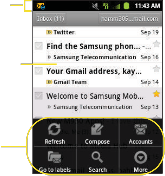
Status bar
Screen
Email functions
158 3B. Web and Data Services
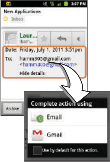
To reply to an email message:
1. With the email message displayed:
• From within Gmail, tap the recipient name from the To: field and select an email application to begin replying to the sender. Choose from:
Gmail or Email.
• From within Email, tap
Reply ![]() .
.
2. Enter a new message body and tap ![]() .
.
To delete an email message:
� With the email message displayed, tap Delete.
Configuring Gmail Settings
![]()
1. Press and tap ![]() >
> ![]() .
.
2. Press and tap More > Settings.![]()
3. This menu provides both field information and settings:
• General preferences allows you to configure general settings that apply to your acount.
● Message Actions: You can set whether or not you can iew the message actions at the top of the screen. Choose from Always show, Only show in portrait, or Don’t show.
● Clear search history: Allows you to remove all of your performed searches.
● Clear “Show pictures”: Allows you to restore the default for all senders. The default setting does not allow pictures to automatically display.
4. Press ![]() to return to the previous screen.
to return to the previous screen.
5. Tap the Gmail account for which you want to view account-specific settings.
6. This menu provides the following fields:
• Priority Inbox: You can set the priority for an email message you send with your Exchange ActiveSync account.
• Signature: Allows you to create an email signature for your outgoing Gmail emails.
3B. Web and Data Services 159
• Confirm actions: Shows a dialog whenever you perform selected actions.
• Reply all: Makes ’Reply all’ the default response for outgoing messages.
• Auto-advance: Selects which screen to show after you delete or archive a conversation.
• Message text size: Allows you to choose the text size displayed within messages: Tiny, Small, Normal, Large, or Huge.
• Batch operations: Allows label operations.
• Sync inboxes and labels: Provides synchronation options for each of your Gmail folders.
• Email notifications: Activates the email notification icon to appear within the Notifications area of the Status bar when a new Internet mail (Gmail, etc.) is received.
![]()
• Labels to notify: Provides notification options for both the default Inbox and Priority Inbox.
Note: You activate Priority Inbox within the General settings to activate notification opions for that Inbox.

● Email notifications: Activates the email notification icon to appear within the Notifications area of the Status bar when a new Internet mail (Gmail, etc.) is received.
Note: You must select this option for the remaining Labels to notify options become active. If active, the Email notifications option is automatically selected within the main Notification settings.
● Ringtone: Plays a selected ringtone once a new email message is received.
● Vibrate: Activates a vibration once a new email message is received.
● Notify once: Sets the device to notify you only once for new incoming emails and not for every new message.
Setting Up an Email Account via the Device
1. Press ![]() and tap
and tap ![]() (Email).
(Email).
2. Enter your account Email address and password.
160 3B. Web and Data Services
3. Tap Next and follow the remaining procedures.
– or –
Tap Manual setup to manually configure your connection settings (POP3 or IMAP). Follow the onscreen prompts and enter the information specific to your carrier.
• The first time you connect, you are asked to give this Internet mail account a unique onscreen name and enter From name (displayed in your outgoing emails within the From field).![]()
• The unique account name is used to differentiate this account from other email accounts accessed by your device.(See “Adding Additional Internet Email Accounts” on page 162.)
Note: Signal interruptions or incorrect username or password information can cause completion issues.
Opening Email
![]()
1. Press and tap ![]() (Email).
(Email).
2. Press and tap Accounts.
3. Select an email account.
4. Tap an existing email message.
![]()
To refresh your Email messages:
� Press ![]() and tap
and tap ![]()
Create and Send Email
![]()
1. Press and tap ![]() .
.
2. Press and tap Accounts.
3. Select an email account.
4. Tap Inbox to open the contents of your inbox.
5. Press ![]() and tap Compose.
and tap Compose.
6. Enter the message recipient’s email address in the
To field.
• If you are sending the email to several recipients, separate the email addresses with a comma.
![]()
• You can add as many message recipients as you want.
Note: To send a carbon copy (Cc) or a blind carbon copy (Bcc) of the current email to other recipients, tap the Cc/Bcc fields.
7. Tap the Subject field and enter the email subject.
8. Tap the Compose Mail field and compose your email.
3B. Web and Data Services 161
• To add a picture attachment, tap Attach (from the bottom of the screen).
• Select the picture you want to attach (indicated by a green checkmark) and tap OK.
• Tap ![]() to delete a selected attachment from your current email.
to delete a selected attachment from your current email.
9. Once complete, tap Send.
10. Enter a new message body and tap .
• Tap ![]() > Save as draft to save the current email as a draft. To later view your draft email messages, from the Inbox, tap the Drafts folder.
> Save as draft to save the current email as a draft. To later view your draft email messages, from the Inbox, tap the Drafts folder.
• To delete the current email message, tap Discard.
Adding Additional Internet Email Accounts Using ![]() only reveals all currently added Email accounts. To view additional email accounts within the
only reveals all currently added Email accounts. To view additional email accounts within the
main Email screen, they must first be added.![]()
1. Press and tap ![]() .
.
2. Press and tap Accounts.
3. Press and tap Add account.
4. Follow the onscreen prompts to add additional Internet-based email accounts such as Yahoo!, AOL, or other POP or IMAP accounts.
Configuring Email Settings
1. Press ![]() and tap
and tap ![]() .
.
2. Tap the email account from the Accounts area of the Email screen.
3. Tap Inbox to open the contents of your inbox.![]()
4. Press ![]() and tap More > Account settings.
and tap More > Account settings.
Note: Press | and tap More to access additional setting | |
Note: Press | and tap More to access additional setting | |
options such as Text size and View mode. |
5. This menu provides both field information and settings:
• Account name: displays your uniquely created account display name.
• Your name: displays the name used in the From
field of your outgoing emails.
• Email check frequency: Tap to adjust the time interval used by your device to check your email account for new emails.
162 3B. Web and Data Services
● Options include: Never, Every 5 minutes, Every
10 minutes, Every 15 minutes, Every 30 minutes, and Every hour.
• Default account: Assign this account as the default email used for outgoing messages.
• Email notifications: Activates the email notification icon to appear within the Notifications area of the Status bar when a new Internet mail (Gmail, etc.) is received.
• Select ringtone: Plays a selected ringtone once a new email message is received.
• Vibrate: Activates a vibration once a new email message is received.
• Incoming settings: Adjusts the incoming email parameters, such as username, password, and other incoming connection parameters (ex: IMAP server).
• Outgoing settings: Adjusts the outgoing parameters, such as username, password, and other incoming connection parameters (ex: SMTO server).
![]()
• Recent messages: Assign the number of onscreen displayed inbox messages. additional messages must be manually retrieved.
• Forward with files: Allows you to maintain any attachments while forwarding a current email.
• Add signature: Activates the email signature feature.
• Signature: Allows you to create an email signature for your outgoing emails.
Corporate Email (Outlook)
The main Email application (![]() ) also provides access to your Outlook Exchange server via your device. If your company uses Microsoft Exchange Server 2003 or 2007 as the corporate email system, you can use this email application to wirelessly
) also provides access to your Outlook Exchange server via your device. If your company uses Microsoft Exchange Server 2003 or 2007 as the corporate email system, you can use this email application to wirelessly
synchronize your email, Contacts, and Task information directly with your company’s Exchange server.
Important: This Outlook application does not utilize Microsoft® ActiveSync® to synchronize the device to your remote Exchange Server. This synchronization is done wirelessly over the air (OTA) and not via a direct connection.
3B. Web and Data Services 163
Setting Up a Corporate Email
1. Press ![]() and tap
and tap ![]() >
> ![]() .
.
2. Enter your Email address and Password information (typically your network access password [case- sensitive]), and then tap Next. Consult your Network Administrator for further details.
3. Tap Manual setup.
4. Tap Microsoft Exchange ActiveSync (from the add email account screen).
5. Enter a Domain\User name, Password, and
Exchange server information.
![]()
• Domain\Username: Use the arrow keys to place your cursor before your username and enter your network domain\desktop login username.
Important: Key info here is the Domain information. Maintain the “\” between the Domain and Username.
• Password: typically your network access password (case-sensitive).
• Exchange server: your exchange server remote email address. Typically starts with mail.XXX.com. Obtain this information from your company network administrator. Do not accept the default entry as this is a guess based on returned information.
![]()
● If your network requires SSL encryption, tap the Use secure connection (SSL) field to place a checkmark in the box and activate this additional level of security. If your exchange server requires this feature, leaving this field unchecked can prevent connection.
Note: Signal interruptions or incorrect username or password information can cause completion issues.
6. Tap Next.
7. Read the onscreen activation disclaimer and, if prompted, tap OK.
8. Configure your Email check frequency, Amount to synchronize (days to synchronize between your device and server), Emails retrieval size, and activate any other email settings, and then tap Next.
164 3B. Web and Data Services

9. Identify your new account with a unique name and provide the outgoing name text then tap Done.![]()
Important: You can synchronize over the air (not directly) with an Exchange Server running Microsoft Exchange Server 2003 Service Pack 2 (SP2) or Microsoft Exchange Server 2007.
Note: You can have multiple Work Email (Microsoft Exchange
ActiveSync) accounts active on your device.
Opening Corporate Email
1. Press ![]() and tap
and tap ![]() >
> ![]() .
.
2. Tap a message to read, manage, and reply to your email messages.
• From your Inbox screen, press ![]() to select options, such as Reply, Forward, Delete, Mark as unread, Show pictures, and More (Display mode, Text size, Move to [folder], Add to Contacts, and Save in Calendar).
to select options, such as Reply, Forward, Delete, Mark as unread, Show pictures, and More (Display mode, Text size, Move to [folder], Add to Contacts, and Save in Calendar).
• When replying to or forwarding an email, all or press ![]() to select messaging options, such as Save as draft, Add text, and Priority.
to select messaging options, such as Save as draft, Add text, and Priority.![]()
Create and Send Email
1. From the Inbox, press ![]() and tap Compose.
and tap Compose.
2. Enter the message recipient’s email address in the
To field.
• Choose recipients from the following sources:
● Recent to access your list of recent contacts.
● Contacts to access your current Contacts page
● Search to search for receipients located in your Contacts list.
• If you are sending the email to several recipients, separate the email addresses with a comma.
![]()
• You can add as many message recipients as you want.
Note: To send an additional carbon copy (Cc) or a blind carbon copy (Bcc) of the current email to other recipients, tap the Cc/Bcc fields.
3. Tap the Subject field and enter the email subject.
4. Tap the message field and compose your email.
• To add a picture attachment, tap Attach (from the bottom of the screen).
3B. Web and Data Services 165
● Press File to access the internal microSD card and navigate to the file you wish to attach.
• Tap the file you wish to attach and tap OK.
To reply to an email message:
1. From the Inbox, tap an email message.
2. Press ![]() and tap Reply.
and tap Reply.
• If you select Forward you must specify the message’s recipients.
3. Tap Sender or All from the onscreen context menu.
4. Enter a new message body and tap Send.
To delete an email message:
� Touch and hold an email (from your inbox list) and select Delete from the onscreen context menu.
– or –
With the email message displayed, press ![]() . tap Delete and then tap OK.
. tap Delete and then tap OK.
Configuring Corporate Email Settings
After your initial setup, you are taken to the Settings menu for your new Work Email account.
Account Settings: configures send and receive settings, such as email signature, notifications, syncing, etc.
1. Press ![]() >
> ![]() and tap
and tap ![]() > Accounts & sync.
> Accounts & sync.
2. Tap ![]() within the Corporate account field to reveal the account’s synchronization settings screen.
within the Corporate account field to reveal the account’s synchronization settings screen.
3. Toggle either the Sync Contacts or Sync Calendar fields to force the device to manually resync either the exchange Contacts or Calendar entries.
– or –
Tap Account settings and configure any other
email parameters you wish to synchronize. (See “Synchronizing Accounts” on page 65.)
Setting Options
166 3B. Web and Data Services
To configure Corporate Email settings:
1. Press ![]() >
> ![]() and tap
and tap ![]() > More > Account settings.
> More > Account settings.
2. Tap the parameters you wish to synchronize.
• Account settings allows you to configure:
● Account name displays the name used by the device to track the account.
● Your name allows you to enter a personal name to associate with the account.
● Amount to synchronize to assign the sync range for your incoming and outgoing emails between your device and your external exchange server. How many days worth of emails should the device and server synchronize. Choose from: 1 day, 3 days,
1 week, 2 weeks, 1 month, or All emails.
● Default account assigns this account as the default used when sending out new emails.
● Out of office settings activates and personalizes an automatic return email informing senders that you are unavailable.
![]()
● Empty deleted items: Allows you to delete your email account’s trash bin remotely.
● Sync schedule: Allows you to configure your email sync schedule.
● Email size: Configures the incoming email size allowed to pass through to your device automatically without user interaction. Larger emails will have to be retrieved manually. Choose from: Headers only, Half KB, 1 KB, 2 KB,
5 KB, 10 KB, 20 KB, 50 KB, 100 KB, or All.
● Email notifications enables the device to display a status bar icon ![]() when new emails have been received.
when new emails have been received.
● Select ringtone assigns an audible ringtone when a new or upcoming event is pending.
● Vibrate assigns a vibration when a new or upcoming event is pending.
● Incoming settings provides access to the Domain, password, and exchange server settings.
3B. Web and Data Services 167
● Sync Contacts synchronizes the contacts between your device and the remote exchange server. A checkmark indicates the feature is enabled.
● Sync Calendar synchronizes your exchange calendar entries between your device and the remote exchange server. A checkmark indicates the feature is enabled.
● Period to sync Calendar assigns a period for your device to sync calendar events. Choose from: 2 weeks, 1 month, 3 months, 6 months, or All calendar.
● Add signature: Activates the email signature feature.
● Signature allows you to create an outgoing email signature attached to new emails sent from your device.
• Sync Contacts allows you to manually synchronize the contacts from the corporate server to the device. A checkmark indicates the feature is enabled.
• Sync Calendar allows you to manually synchronize calendar events from the corporate server to the device. A checkmark indicates the feature is enabled.
3. Press ![]() to return to the previous screen. For more detailed Corporate email information, see
to return to the previous screen. For more detailed Corporate email information, see
“Corporate Email (Outlook)” on page 163. For more
information on Corporate Calendar synchronizing, see
“Synchronizing Corporate Calendar Events” on page
93.
To create a Corporate Email Signature:
This signature can differ from any current Email signature on your local Outlook client. This signature is applied to any outgoing emails originating on your device.
1. Press ![]() >
> ![]() and tap
and tap ![]() > More > Account settings.
> More > Account settings.
2. Scroll to the bottom of the list and tap Signature.
3. Delete the current default text and enter your new email signature.
4. Tap OK to store the new signature.
168 3B. Web and Data Services
Configuring Data Synchronization Settings
This feature allows you to determine which current applications are synchronized with external server and at what intervals.
1. Press ![]() >
> ![]() and tap
and tap ![]() >
>
Accounts & sync. These settings can affect data
minute usage, please refer to your current data plan for more details.
2. Tap any of the following options:
• Background data: Allows data synchronization to occur as a background function. It allows this to occur behind the scenes and does not affect any current use of the device.
• Auto-sync: Requires the device to maintain synchronization with the remote server providing data to your selected applications.
3. Press ![]() to store your changes and return to the Home screen.
to store your changes and return to the Home screen.![]()
Books
![]()

The Books application allows you to purchase ebooks through the Google ebooks Website.![]()
� Press > ![]()
and tap .
Your downloaded ebooks display on the Books screen.
To search for an ebook:
1. Tap ![]() to search for an ebook.
to search for an ebook.
2. Enter keywords to narrow your search results
(author, title, etc.).
3. Tap ![]() to view the results of your keyword search.
to view the results of your keyword search.
4. Read and follow the onscreen instructions to download the ebook of your choice.
3B. Web and Data Services 169
![]()
![]()
To manage your downloaded ebooks:
![]()
![]()
1. Press > and tap .
2. Press and tap
![]()
3. Tap any of the following options:
• allows you to delete the selected ebook.
• allows you to view the ebook while offline.
![]()
![]()
To access Books settings:
![]()
![]()
1. Press > and tap .
2. Press and tap
• Storage location allows you to copy your ebook from the device’s internal storage to the SD card.
• About displays the Books application software version.
• Terms of Service allows you to display the Mobile Terms of Service associated with the Books application.
• Privacy Policy allows you to display the Mobile Privacy Policy associated with the Books application.
• Open source licenses to view license details for open source software and fonts.
Using the Android Market
![]()
The Android Market provides direct access to a large selection of applications which you can download and install on your device.
Accessing the Market
![]()
1. Press and tap ![]() (Market).
(Market).
2. If not already logged in with your Google account, tap Next.
3. Tap Sign in and enter your Google account information.
4. Touch Accept to agree to the Android Market terms of service.
Selecting and Installing a Google Application
1. Press ![]() and tap
and tap ![]() .
.
2. Browse through the categories (Apps, Games, or Sprint), find an application you're interested in, and tap the name.
170 3B. Web and Data Services
3. Read the application descriptions.
![]()
4. Tap Install.
Note: Use caution with applications which request access to any personal data, functions, or significant amounts of data usage times.
5. If prompted, follow the onscreen instructions to pay for the application.
6. Check the progress of the current download by opening the Notifications panel.
7. After the item is downloaded and installed on your device, the content download icon ![]() appears in the notification area of the status bar.
appears in the notification area of the status bar.
8. On the Android Market screen, tap ![]() > My apps > (the installed application) > Open.
> My apps > (the installed application) > Open.
Launching an Installed Google Application
1. Press ![]() and tap
and tap ![]() .
.![]()
2. Tap the newly installed application.
Tip: You can also access recent apps from the Google
Market. Tap > My apps and tap the application.
![]()
Reinstalling a Google Application
![]()
If the Android operating system is ever updated, any data contained on the device will be erased. The only data stored on the device are Google applications available via the Android Market.
Note: Pictures and music are stored on the microSD card.
Contacts and Calendars are stored remotely on with your remote Google or Outlook servers.
1. Log into your Google account via the device.
2. Press ![]() and tap
and tap ![]() >
> ![]() > My apps.
> My apps.
3. Scroll through the list of previously downloaded Google applications and choose the one you wish to reinstall.
4. Follow the onscreen instructions.
3B. Web and Data Services 171
Downloading Applications From the
Web
![]()
Sprint Applications
You can access a wide variety of Sprint applications in
You can download applications while browsing the Web, but you must first set permissions in settings to allow applications from unknown sources. Applications downloaded from Android Market (see “Using the Android Market” on page 170) do not require additional permissions.
1. Press ![]() >
> ![]() >
> ![]() > Applications.
> Applications.
2. Select the Unknown sources check box.
3. When the Attention dialog box opens, read the disclaimer and tap OK.
Note: All downloaded applications are saved to your device's microSD storage card. Your device came with a pre- installed microSD card. For information on installing a new card, please see the User Guide at
sprint.com/ support.
many different categories with your phone and data service. Currently, various applications, such as NASCAR, Sprint Football Live, TeleNav GPS Navigator, and Sprint TV are available when you download and install the Sprint ID pack.
Download the Sprint ID Pack
� Press ![]() and tap
and tap ![]() . On the Choose your ID screen tap Get New ID Packs > Sprint. Follow the onscreen prompts to install the Sprint ID Pack.
. On the Choose your ID screen tap Get New ID Packs > Sprint. Follow the onscreen prompts to install the Sprint ID Pack.
– or –
Press ![]() and tap
and tap ![]() > Sprint ID > Get New ID Packs > Sprint. Follow the onscreen prompts to
> Sprint ID > Get New ID Packs > Sprint. Follow the onscreen prompts to
install the Sprint ID Pack.
172 3B. Web and Data Services
Note: Once you download and install the Sprint pack, Sprint applications such as NASCAR Sprint Cup Mobile, Sprint Football Live, and TeleNavTM GPS Navigator will appear on your applications screen. When you switch from the Sprint pack to another ID pack, or choose a new ID pack, the Sprint applications will remain installed and visible on your applications screen.

To download and install Sprint apps:
� Press ![]() and tap
and tap ![]() > [application name].
> [application name].
The browser will start and take you to the
download menu for the application.![]()
4. Follow the instruction to customize your application (such as selecting a favorite team or driver) or press to explore your options.
![]()
![]()
Important Privacy Message – Sprint’s policies often do not apply to third-party applications. Third-party applications may access your personal information or require Sprint to disclose your customer information to the third-party application provider. To find out how a third-party application will collect, access, use, or disclose your personal information, check the application provider’s policies, which can usually be found on their website. If you aren’t comfortable with the third-party application’s policies, don’t use the application.

Note: Some Sprint data applications may not work with a Wi- Fi connection present. If prompted, disable your device's Wi-Fi feature while using these applications.
Sprint Zone
Sprint Zone is a free application that lets you stay connected to all the latest news and information from Sprint. Included here are sprint customer promotions, news, feedback, featured apps and tips/tricks for your device.
1. Press ![]() and tap
and tap ![]() >
> ![]() (SprintZone).
(SprintZone).
3B. Web and Data Services 173
2. From the Sprint Zone Web page, scroll up or down and tap an item to check your account, read the latest news about your device, load an application, and more.
NASCAR Sprint Cup Mobile
Now you have the ability to get every bit of NASCAR
coverage, news, and stats right on your device.![]()
1. Press ![]() and tap
and tap ![]() > (NASCAR).
> (NASCAR).
2. If prompted, read the permission check disclaimer, make a selection and tap OK. Follow the onscreen instructions until you reach the main NASCAR Sprint Cup Mobile page.
3. Tap an onscreen option to activate features that include:
• Home is the main NASCAR homepage where you can view stats on a current race, choose to follow a specific driver, view special NASCAR promotions and other NASCAR-specific multimedia content.
● Press ![]() and tap HOME to return to the main NASCAR page. This applies to each of these options.
and tap HOME to return to the main NASCAR page. This applies to each of these options.
• Race Recap provides overviews of the current races, pictures, commentary, additional photos, and race stats.
• SPEED displays a list of selectable multimedia video clips from the SPEED channel that are specific to NASCAR.
• Chase for the latest from Chase including Chase News, Who's Hot, Top 5s, Most Wins, Best this Week, Chase Tweets, and Chase 101.
• My Driver to customize your NASCAR experience by following specific drivers. Information includes driver-specific stats and NASCAR RSS feeds. You can also get additional stats, review other driver info, or change drivers.
• Stats & Schedule lets you track race information such as: NSCS Recap, NNS Recap, Point Standings, Season Stats, Schedules, Past Results, and Fantasy Insights.
174 3B. Web and Data Services
• Miss Sprint Cup is your insider to NASCAR by providing news, information, blogs and twitter updates to the goings-on within NASCAR photos, etc. for the All-Star race.
• Video displays a list of selectable multimedia content. Other features include streaming multimedia content from NASCAR radio stations or other racing radio shows.
• News & Alerts provides you with quick access to NASCAR-specific news, photos, and driver stats. You can also customize alerts for new information such as ALL NASCAR News, Sprint Cup News, etc.
• Twitter lets you receive the latest Twitter updates, including those for My Driver, Media, Track, MSC, and MSC Friends.
• Fantasy lets you take part in online fantasy racing, and access Fantasy Insights, Fantasy News, and Fantasy Videos. You will have to login using a NASCAR.COM Community login. If you do not have this information, visit community.nascar.com to get an account.![]()
• FanZone displays a list of selectable content available to Sprint subscribers such as Sweepstakes, Video clips (footage and music) and Screensavers.
• Settings & Help displays help information for usage of the NASCAR application and features.
• Exit to quit the NASCAR application.
● Press ![]() and tap Exit.
and tap Exit.
Sprint Football Live
Get Sprint Football Live on your phone. It lets you be right in the middle of your favorite game by being a part of previews, blogs, discussions groups, fantasy football, etc.
1. Press ![]() and tap
and tap ![]() >
> ![]() (Sprint Football
(Sprint Football
Live).
2. Select PRO or COLLEGE football and select from options such as the following:
• My Team launches a team-specific page with content such as top stories, RSS feeds, Rumor information, Schedules, Team Alerts, and the ability to change your favorite team selection.
3B. Web and Data Services 175
• Scores & Schedules provides final scores and future game schedules. The content can be viewed By Week or By Team.
• News & Blogs provides AP league news, Rumor and News, PFTV, Injury Info, Transactions, Legal, and other football related information, photos and videos.
• Standings provides regular season team standings by conference (NFC or AFC).
• Statistics provides regular season rundowns. You can view them by Weekly Leaders, League Leaders, Team League Leaders, Player Stats and Team Stats.
• Videos and Photos provides images, highlights, previews, and commentaries about your favorite football news.
• Fantasy allows you to choose from a list of applications associated with fantasy football leagues (PRO football only).
• Twitter launches an onscreen Twitter page specific to the NFL. Also included onscreen is a real-time RSS new feed.
• Odds launches a spreadsheet of game outcome predictions.
176 3B. Web and Data Services
• Team Pages allows you select from wither the AFC or NFC conferences, and then display content such as top stories, RSS feeds, Rumor information, Schedules, Team Alerts, and the ability to change your favorite team selection.
• Alerts allows you to receive automatic updates based upon your selection. Selection categories include: MY ALERTS, TEAM ALERTS, GAME ALERTS, and PLAYER ALERTS.
• Settings/Help displays help information for Sprint Football Live topics such as: Choose Favorite Team, About, and Help.
• To exit, press ![]() and tap EXIT.
and tap EXIT.
Data Services FAQs
![]()
How do I sign in for the first time?
You are automatically signed in to access data services when you turn on your device.
How do I know when my device is connected to data services?
Your device automatically connects when you use data![]()
![]()
service or an incoming message arrives. You will also see the or indicator.![]()
Can I make calls and use data services at the same time? No, you can not use voice and data services simultaneously.
When is my data connection active?
Your connection is active when data is being transferred. Outgoing calls are allowed; incoming calls go directly to voicemail. When active, the![]() or
or ![]() indicator is animated on the display screen.
indicator is animated on the display screen.
When is my data connection dormant?
If your device receives no data for 10 seconds, the connection goes dormant. When the connection is dormant, you can make and receive voice calls. (The connection may become active again quickly.) If your device receives no data for an extended period, the connection will terminate.
Can I re-download paid applications without being charged again?
Your Market applications are associated to your
Google account login information. Even if your device is reset and reinstalled with an update to Android, you can log back into your Google account and reinstall these applications.
3B. Web and Data Services 177
3C. Entertainment: TV and Music

• Getting Started with Sprint TV, Music, and Movies (page
178)
• Sprint Music (page 179)
• Music Player (page 179)
• Sprint Radio (page 180)
• Sprint TV & Movies (page 181)
• YouTube (page 182)
Getting Started with Sprint TV, Music, and Movies
![]()
In order to access Sprint applications on your device, such as Sprint TV, you must first download and install the Sprint ID Pack. Once you have installed the Sprint pack, you can switch back to any other pack or install a new pack. The Sprint applications will always be stored on your applications screen.
� Press ![]() and tap
and tap ![]() . On the Choose your ID
. On the Choose your ID
screen tap Get New ID Packs > Sprint. Follow the
onscreen prompts to install the Sprint ID Pack.
– or –
Press ![]() and tap
and tap ![]() >
> ![]() Sprint ID > Get
Sprint ID > Get
New ID Packs > Sprint. Follow the onscreen
prompts to install the Sprint ID Pack.
178 3C. Entertainment: TV and Music
Sprint Music
![]()
The new Sprint Music Plus gives you exactly that with a full-featured music and tone manager allowing you to easily manage your music content all in one convenient place. Sprint Music Plus lets you rock out while you create music and ringtone playlists, assign ringback tones to play for different callers, and get song recommendations based on your music tastes.
1. Press ![]() >
> ![]() >
> ![]() (Sprint Music).
(Sprint Music).
2. Follow the onscreen instructions.
Music Player
![]()
Accessing the Music Player
1. Press ![]() and tap
and tap ![]() >
> ![]() (Music).
(Music).
2. From the Music display, select an option:
• Artists to display your current local music files sorted by artist.
• Albums to display your current local music files sorted by album.
• Songs to browse through all of your downloaded music and any additional songs you have loaded onto your microSD card from your computer.
• Playlists to select a customized playlist you’ve created to organize your music.
![]()
3. Once you’ve displayed a list of songs, you can browse through your available titles.
• To play a song, tap it to display the title and track information.
• To listen to a song or playlist, tap it to begin playing from the selected song. (You can also highlight the playlist to begin listening.)
Creating a Playlist
1. Press ![]() and tap
and tap ![]() >
> ![]() > Songs. Your device searches through your device and microSD card for compatible music files and then displays them onscreen.
> Songs. Your device searches through your device and microSD card for compatible music files and then displays them onscreen.
2. Touch and hold a song you’d like to add to a playlist. This action reveals an onscreen context menu.
3. Tap Add to playlist and select either a Current playlist or select New (to create a new playlist).
3C. Entertainment: TV and Music 179
• If you select New, delete the current default name, enter a name for your new playlist, and tap Save.
Assigning a Song as a Ringtone
1. Press ![]() and tap
and tap ![]() >
> ![]() > Songs.
> Songs.
2. Touch and hold a song you’d like to use as your new ringtone. This action reveals an onscreen popup menu.
3. Tap Use as phone ringtone to store the selected song as your new default ringtone.
4. Confirm the song has been successfully assigned by navigating to your Phone ringtone menu.
• Press ![]() >
> ![]() >
> ![]() > Sound settings> Phone ringtone.
> Sound settings> Phone ringtone.
5. Confirm the new song is selected.
Backing Up Your Downloaded Music Files
Sprint recommends you back up your downloaded music files to your computer. (See “Connecting Your Device to Your Computer” on page 110.)
180 3C. Entertainment: TV and Music
1. Connect your phone using a USB cable or the built-in connection on Bluetooth-enabled phones.
2. Use your computer to navigate to the microSD
card’s Music folder.
3. Select and copy the music files to a folder on your computer’s hard drive.
Sprint Radio
![]()
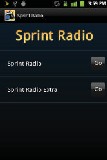
The Sprint Radio application provides you with a variety of radio stations to listen to your favorite music or get caught up on what’s new in music. Genres include: Hip-Hop/ R&B, Rock, Pop, Latin, Alternative, and nationwide live-local stations. Visit www.sprint.com/radio for more information on channels and pricing.
Accessing Sprint Radio
1. Press ![]() >
> ![]() >
> ![]() (Sprint Radio).
(Sprint Radio).
2. Tap Go (located to the right of Sprint Radio).
Once you’ve displayed the list of genres and search options, you can browse through your available titles.
• To play a song, tap it to display the title and track information.
• To locate artists similar to the one currently playing, tap ![]() > Find Similar Artists.
> Find Similar Artists.
Using Sprint Radio Extra
Sprint Radio Extra is a premium service that allows you to access commercial-free stations, music videos, and stations such as FoxSports, AccuWeather, ABC News, NPR, PRI, and more. You can also create and personalize stations that play your favorite artists and songs.
3. Press ![]() >
> ![]() >
> ![]() .
.
4. Tap Go (located to the right of Sprint Radio Extra).
Once you’ve displayed the list of genres and search options, you can browse through your available titles.
• To play a song, tap it to display the title and track information.
![]()
• To locate artists similar to the one currently playing, tap ![]() > Find Similar Artists.
> Find Similar Artists.
Sprint TV & Movies
![]()
Your Sprint TV Channel Options
![]()
The Sprint TV & Movies application offers a wide variety of accessible channels. Subscription options include comprehensive basic packages as well as a full menu of “a la carte” channels. Visit www.sprint.com/ tvguide for more information on channels and pricing.
Note: Available categories and content are subject to change.
Watching TV & Movies
1. Press ![]() >
> ![]() >
> ![]() (Sprint TV & Movies).
(Sprint TV & Movies).
Depending on your settings, your device may
prompt you to accept a data connection.
3C. Entertainment: TV and Music 181
Note: SprintTV can only be viewed over a cellular connection.
Turn off your Wi-Fi communication prior to using this application. If prompted, tap Disable Wi-Fi to continue.
![]()
2. Select Live TV, On Demand, Movies, Shop, or Help to display channel options.
3. Tap an entry to select a channel from the Sprint TV

listings or to select an available category.
Note: The first time you access a channel, the system will prompt you to purchase access (unless the channel doesn't have a monthly fee). Tap Subscribe to purchase access, or tap Preview to view a preview of the selected channel.

4. Tap a desired clip to view the program. The clip will automatically load and begin playing.
Tip: Scroll through the channels to view more selections.
Once you find a channel that you want to watch or listen to, simply tap it and wait approximately three seconds,
and the channel begins loading.
182 3C. Entertainment: TV and Music
YouTube
![]()
YouTube™ is a video sharing website on which users can upload and share videos. The site is used to display a wide variety of user-generated video content, including movie clips, TV clips, and music videos, as well as video content such as video blogging, informational shorts and other original videos.![]()
![]()
> ![]() (YouTube).
(YouTube).
2. Read the Terms of Service and press Accept
3. Tap ![]() to search for specific videos, scroll down to browse through the main page thumbnails, or
to search for specific videos, scroll down to browse through the main page thumbnails, or
scroll to the bottom to explore additional options.
4. To view a video, touch an available preview thumbnail or touch the title link.
![]()
5. Press to return to the previous page.
![]()
Note: It is not necessary to sign in to the YouTube site to view content. However, if you wish to sign in to access additional options, access the page via the Web browser and tap Sign in at the top right corner, enter your YouTube or Google username and password, and tap Sign in.

3C. Entertainment: TV and Music 183
3D. GPS Navigation

• GPS Services (page 184)
• Google Maps (page 184)
• Navigation (page 186)
• TeleNav GPS Navigator (page 186)
• Getting Driving Directions (page 188)
GPS Services
![]()
Your device’s built-in GPS capability gives you access to a number of location-based services, including Google Maps and TeleNav GPS Navigator.
Activating Location Mode
Before using any of the location-based services, you must turn on your device’s location mode.
� Press ![]() >
> ![]() >
> ![]() > Location & security > Use GPS satellites.
> Location & security > Use GPS satellites.
Note: Enabling the GPS hardware can drain your battery faster.
![]()
Activating Using Wireless Networks
This additional location feature uses open Wi-Fi and mobile network connections to assist in providing additional location accuracy.
1. Press ![]() >
> ![]() >
> ![]() > Location & security > Use wireless networks.
> Location & security > Use wireless networks.
• Since this feature is based on Google’s location service, you will need to agree to allow Google to collect anonymous information.
2. Tap Agree to accept the terms of service.
Google Maps
![]()
Use this application to find directions, location information, business addresses, etc., all right from your Samsung Replenish™. Determine your current location with or without GPS, get driving and transit directions and get phone numbers and addresses for local businesses.
184 3D. GPS Navigation
Before you begin using this feature you must activate your GPS hardware and agree to share location information with Google.
To enable your device’s GPS Location feature:
1. Press ![]() >
> ![]() >
> ![]() > Location & security.
> Location & security.
2. Tap Use GPS satellites. A green checkmark indicates the GPS location feature is enabled.
(For additional location information, see “Location
Settings” on page 64.)
• ![]() appears in the Notification area when the
appears in the Notification area when the
GPS is active.
• ![]() appears in the Notification area when the
appears in the Notification area when the
GPS is communicating.![]()
![]()
![]()
To launch the Google Maps application:
� Press and tap > (Maps).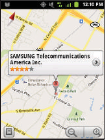
![]()
To use Google Maps:
1. Press and tap
![]() > .
> .
• If prompted, read the “What’s new” message and tap OK.
2. Tap the magnification icons to zoom in or out of the current map view.
![]()
– or –
Press ![]() to use other Google Map features.
to use other Google Map features.
• Choose from: Search, Directions, Layers,
My Location, Join Latitude, and More (Clear Map, My Places, Labs, Cache Settings, Help, Terms, Privacy & Notices, and About).
![]()
![]()
To search for a keyword:
![]()
1. Press and tap > .
2. Press and tap Search.
3D. GPS Navigation 185
3. Tap the search field (at the top of the screen), enter a keyword, and tap ![]() .
.
• This keyword can be a category name (such as
pizza, steak, burger), a business name (Samsung, Sprint), or a Google friend who is sharing their location.
4. Tap ![]() (bottom left) to reveal a detailed list of information corresponding to those matches now displayed on your screen with lettered pins.
(bottom left) to reveal a detailed list of information corresponding to those matches now displayed on your screen with lettered pins.
Navigation
![]()
Another Google Maps navigation application is available on your device. It uses your current location (provided by GPS communication to your device) to provide various location-based services.
1. Press ![]() and tap
and tap ![]() >
> ![]() (Navigation).
(Navigation).
2. Read the onscreen disclaimer and tap Accept.
3. Choose from the following onscreen options:
• Speak Destination to use the voice recognition feature to search for matching locations in your area.
• Type Destination to manually enter a destination address.
• Contacts to receive turn-by-turn directions to the address stored for a selected Contacts entry.
• Starred Places to obtain directions to locations that have been starred within Google maps (maps.google.com).
TeleNav GPS Navigator
![]()
![]()
TeleNav GPS Navigator gives you turn-by-turn directions onscreen and over speakerphone. In order to use this application, you must first turn on the Enable GPS Satellites setting.![]()
Note: Depending on your service plan, TeleNav may require a monthly subscription. Contact Sprint for information and pricing.
Note: Some features may be available only with a subscription to TeleNav GPS Navigator Premium.
186 3D. GPS Navigation
Getting Started with TeleNav GPS Navigator
Before you can use TeleNav GPS Navigator, you must first install the Sprint ID pack.
� Press ![]() and tap
and tap ![]() . On the Choose your ID
. On the Choose your ID
screen tap Get New ID Packs > Sprint. Follow the
onscreen prompts to install the Sprint ID Pack.
– or –
Press ![]() and tap
and tap ![]() >
> ![]() > Get New ID Packs. Follow the onscreen prompts to install the
> Get New ID Packs. Follow the onscreen prompts to install the
Sprint ID Pack.
To install the TeleNav GPS Navigator application:
![]()
1. Press ![]() and tap
and tap ![]() >
> ![]() (TeleNav GPS Navigator).
(TeleNav GPS Navigator).
Note: Once TeleNav GPS Navigator is installed on your device, you will have the option of Upgrading to Premium. Follow the onscreen prompts to learn more.
2. Tap Install.
3. Tap the NAV.pak file from the download history screen.
4. If prompted to allow installation of blocked content, tap Settings and select Unknown sources. (See “Unblocking Unknown Installations” on page 74.)
5. Tap Install.
Registering TeleNav GPS Navigator
![]()
Before you can use the TeleNav GPS Navigator, your device and service must be registered.
1. Press ![]() and tap
and tap ![]() >
> ![]() .
.
2. Read the disclaimer and touch Accept to
acknowledge the terms of use.
3. Tap each of the onscreen registration fields and enter the required information.
• First Name, Last Name, and Email (optional).
• If using the onscreen keyboard, tap Next to store your information.
4. Tap Continue to register your information.
3D. GPS Navigation 187
5. Tap Yes to take a brief tour of the Navigation features and functionality, or No, Skip Tour to continue to the main navigation screen.
Using TeleNav GPS Navigator
1. Press ![]() and tap
and tap ![]() >
> ![]() .
.
2. Select an option and follow the onscreen
instructions to take advantage of TeleNav’s full suite of features.
• Drive To lets you get driving directions from wherever you are to wherever you’re going. Choices include:
● Set Up Home: default starting location for all driving directions.
● My Favorites: user-defined favorite locations.
● Recent Places: recently entered locations.
● Address: manually entered street addresses.
● Contacts: those local addresses assigned to previously entered Contacts.
● Places lets you search for locations from dozens of names or category options such as ATM, Food/Coffee, Gas, Grocery, Lodging, Theaters, Nightlife, Parking, Shopping, Transportation, Wi-Fi, and More (Community and Business).
● Airport: local airports based on current GPS
![]()
location.
Note: For more information about Sprint Navigation powered by TeleNav, visit www.sprint.com/navigation.
Getting Driving Directions
![]()
The built-in GPS hardware (when enabled) allows you to get driving directions to selected locations or establishments based on your current location.
Using a Physical Address
1. Press ![]() and tap
and tap ![]() >
> ![]() > Drive To > Address.
> Drive To > Address.
188 3D. GPS Navigation
2. Tap the Street number and name field to manually enter the new address and receive driving directions from the GPS network.
– or –
Tap ![]() to place a call to the TeleNav™ operator where you will speak the desired address. This is similar to calling 411 for directory assistance. (A fee may be incurred.)
to place a call to the TeleNav™ operator where you will speak the desired address. This is similar to calling 411 for directory assistance. (A fee may be incurred.)
3. Tap Submit to initiate your search.
4. Follow both the onscreen and audio directions. After you enter the location and receive driving
directions, you can alter the information being displayed by using one of three other driving options: Places, Map, Directions, and Traffic.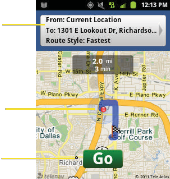
Current Street location
![]()
Your location
Get
Directions
To receive turn-by-turn directions (2D):
![]()
1. Press ![]() and tap
and tap ![]() >
> ![]() > Drive To > Address.
> Drive To > Address.
Note: A 2D map is a flat representation of your projected driving directions. A 3D map (shown here) represents the driving directions with a representation of depth.
3D. GPS Navigation 189
2. Tap the Street number and name field, enter the physical address information, and tap Submit.
2. Enter a keyword into the Search field to begin retrieving matches. Once you see a matching
3. Press
![]()
business name, touch the entry.
view and a detailed turn-by-turn description for navigating to your desired location.
To search nearby locations based on type:
1. Press ![]() and tap
and tap ![]() >
> ![]() > Drive To > Address.
> Drive To > Address.
2. Tap Address field, enter the physical address information, and tap Submit.
– or –
Tap the Category field and then choose from one of the available category entries by touching an onscreen entry such as: ATM, Food/Coffee, Gas, Grocery, Lodging, Theaters, Nightlife, Parking, Shopping, Transportation, Wi-Fi, and More (Community and Business).
• Entries with more than one available category (a
3. Press
![]()
Go and tap Places to search for a
subcategory) appear with an adjacent gray arrow.
location based on a category such as Food/ Coffee, etc.
Using a Local Business Category
The Samsung Replenish™ can also cross-reference your current location with local business and points of interest, such as Grocery Stores, Gas Stations, Wi-Fi Spots, Malls, Hospitals, etc.
1. Press ![]() and tap
and tap ![]() >
> ![]() > Drive To > Places.
> Drive To > Places.
These entries can be expanded and then closed.
3. Tap Search to store your information and begin the search.
4. Tap a matching entry based upon star ratings and distances.
To search for the lowest gas prince in your area:
1. Press ![]() and tap
and tap ![]() >
> ![]() > Drive To > Places > Gas > By Price (Regular, Plus, Premium,
> Drive To > Places > Gas > By Price (Regular, Plus, Premium,
Diesel).
190 3D. GPS Navigation
2. Touch an entry from the list to display a new route to the selected gas station.
Creating a My Favorites Location
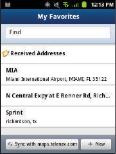
Once you have begun using Sprint Navigation to find your destination, you can then either recall those locations and add them to your list of favorite destinations or create a new entry from one of the available location categories (Address, Business, Airport, or Contacts).
To create a My Favorites location from your Current Location:
1. Press ![]() and tap
and tap ![]() >
> ![]() > Drive To > My Favorites > New > Current Location.
> Drive To > My Favorites > New > Current Location.
2. Tap Save to complete the process.
To create a My Favorites location from a Recent Place:
1. Press ![]() and tap
and tap ![]() >
> ![]() > My Favorites
> My Favorites
> New > Recent Places.
2. Tap a previous destination location from the list and tap Save.
Sharing a Recent Location with Others
![]()
Recently queried locations can be saved to your My Favorites list and also shared with other cellular devices.
1. Press ![]() and tap
and tap ![]() >
> ![]() > Drive To > Recent Places.
> Drive To > Recent Places.
2. Press and hold the address of your choice.
3. Tap Share. Choose from: Select from Contacts or
Enter Phone Numbers.
4. Touch Send to complete the delivery process.
Configuring Your Navigation Preferences
1. Press ![]() and tap
and tap ![]() >
> ![]() >
> ![]() > Settings.
> Settings.
3D. GPS Navigation 191
2. Touch an entry to change its current setting:
• Profile: allows you to add personal information registered with the service.
● Phone: contains your device phone number by default and cannot be altered.
● First Name/Last Name: allows you to alter the current first and last name registered with the service.
● Email: allows you to create an associated email account for this application.
• General: allows change general settings, including:
● Language: allows you to assign a current language. Default is English (US).
● Distance Units: allows you to alter the descriptions used for distances: Km/Meters or Miles/Feet.
• Navigation: lets you change navigation settings, including:
● Route Style: allows you to choose the method which is used to provide you directions from Point A to Point B. The default is Fastest.
● Map Color: allows you to alter the appearance of the onscreen map: Auto, Daytime, or Nightime.
● Avoid: allows you to setup obstacles that should be avoided when determining travel routes: HOV Lanes, Tolls, and Traffic Delays. Tap Done to set these parameters.
● Map Style: allows you to setup a preferred traffic display view: 2D Moving Maps or 3D Moving Maps.
● BackLight: allows you to assign the backlight settings: Always On, On at Turns, or Device Default.
• Audio: lets you change the audio read out given during your navigation session:
● Audio Guidance: allows you to setup the level of detail used for the directions when spoken: With Street Names, Without Street Names, or No Audio.
192 3D. GPS Navigation

Section 4
Safety and Warranty
Information
![]()
4A. Important Safety
Information

• General Precautions (page 194)
• Maintaining Safe Use of and Access to Your Phone
(page 195)
• Using Your Phone With a Hearing Aid Device (page 196)
• Caring for the Battery (page 198)
• Radio Frequency (RF) Energy (page 199)
• Samsung Mobile Products and Recycling (page 201)
• Owner’s Record (page 201)
• User Guide Proprietary Notice (page 202)
This phone guide contains important operational and safety information that will help you safely use your phone. Failure to read and follow the information provided in this phone guide may result in serious bodily injury, death, or property damage.
General Precautions
![]()
There are several simple guidelines to operating your phone properly and maintaining safe, satisfactory service.
e To maximize performance, do not touch the bottom portion of your phone where the internal antenna is located while using the phone.
e Speak directly into the mouthpiece.
e Avoid exposing your phone and accessories to rain or liquid spills. If your phone does get wet, immediately turn the power off and remove the battery.
e Do not expose your phone to direct sunlight for extended periods of time (such as on the dashboard of a car).
e Although your phone is quite sturdy, it is a complex piece of equipment and can be broken. Avoid dropping, hitting, bending, or sitting on it.
![]()
e Any changes or modifications to your phone not expressly approved in this document could void your warranty for this equipment and void your authority to operate this equipment.
Note: For the best care of your phone, only Sprint-authorized personnel should service your phone and accessories. Failure to do so may be dangerous and void your warranty.
194 4A. Important Safety Information
Maintaining Safe Use of and Access to Your Phone
Using Your Phone Near Other Electronic Devices Most modern electronic equipment is shielded from radio frequency (RF) signals. However, RF signals from wireless
phones may affect inadequately shielded electronic
Do Not Rely on Your Phone for Emergency Calls Mobile phones operate using radio signals, which cannot guarantee connection in all conditions. Therefore you should never rely solely upon any mobile phone for essential communication (e.g., medical emergencies). Emergency calls may not be possible on all cellular networks or when certain network services or mobile phone features are in use. Check with your local service provider for details.
Using Your Phone While Driving
Talking on your phone while driving (or operating the phone
without a hands-free device) is prohibited in some jurisdictions. Laws vary as to specific restrictions. Remember that safety
![]()
always comes first.
Purchase an optional hands-free accessory at your local Sprint Store, or call Sprint at 1-866-866-7509. You can also dial # 2 2 2 on your phone.
Following Safety Guidelines
To operate your phone safely and efficiently, always follow any
special regulations in a given area. Turn your phone off in areas where use is forbidden or when it may cause interference or
danger.
equipment.
![]()
RF signals may affect improperly installed or inadequately shielded electronic operating systems or entertainment systems in motor vehicles. Check with the manufacturer or their representative to determine if these systems are adequately shielded from external RF signals. Also check with the manufacturer regarding any equipment that has been added to your vehicle.
![]()
Consult the manufacturer of any personal medical devices, such as pacemakers and hearing aids, to determine if they are adequately shielded from external RF signals.
Note: Always turn off the phone in healthcare facilities, and request permission before using the phone near medical equipment.
Turning Off Your Phone Before Flying
Turn off your phone before boarding any aircraft. To prevent
possible interference with aircraft systems, the U.S. Federal
Aviation Administration (FAA) regulations require you to have permission from a crew member to use your phone while
the plane is on the ground. To prevent any risk of interference,
FCC regulations prohibit using your phone while the plane is in the air.
4A. Important Safety Information 195
Turning Off Your Phone in Dangerous Areas
To avoid interfering with blasting operations, turn your phone
off when in a blasting area or in other areas with signs indicating two-way radios should be turned off. Construction crews often use remote-control RF devices to set off explosives.
Turn your phone off when you’re in any area that has a potentially explosive atmosphere. Although it’s rare, your phone and accessories could generate sparks. Sparks can cause an explosion or fire, resulting in bodily injury or even death. These areas are often, but not always, clearly marked. They include:
• Fueling areas such as gas stations.
• Below deck on boats.
• Fuel or chemical transfer or storage facilities.
• Areas where the air contains chemicals or particles such as grain, dust, or metal powders.
![]()
• Any other area where you would normally be advised to turn off your vehicle’s engine.
Note: Never transport or store flammable gas, flammable liquids, or explosives in the compartment of your vehicle that contains your phone or accessories.
Restricting Children’s Access to Your Phone
Your phone is not a toy. Do not allow children to play with it as
they could hurt themselves and others, damage the phone or make calls that increase your Sprint invoice.
Please Note the Following Information When Using Your
Handset
1. WARNING REGARDING DISPLAY
• The display on your handset is made of glass or acrylic and could break if your handset is dropped or if it receives significant impact. Do not use if screen is broken or cracked as this could cause injury to you.
2. WARRANTY DISCLAIMER: PROPER USE OF A TOUCHSCREEN HANDSET
• If your handset has a touchscreen display, please note that a touchscreen responds best to a light touch from the pad of your finger. Using excessive force or a metallic object when pressing on the touchscreen may damage the tempered glass surface and void the warranty. For more information, please refer to the “4B. Manufacturer’s Warranty” on page 203.
Using Your Phone With a Hearing
Aid Device
![]()
A number of Sprint phones have been tested for hearing aid device compatibility. When some wireless phones are used with certain hearing devices (including hearing aids and cochlear implants), users may detect a noise which can interfere with the effectiveness of the hearing device.
196 4A. Important Safety Information
Some hearing devices are more immune than others to this interference noise, and phones also vary in the amount of interference noise they may generate. ANSI standard C63.19 was developed to provide a standardized means of measuring both wireless phone and hearing devices to determine usability rating categories for both.
Ratings have been developed for mobile phones to assist hearing device users find phones that may be compatible with their hearing device. Not all phones have been rated for compatibility with hearing devices. Phones that have been rated have a label located on the box. Your SPH-M580 has an M4 T3 - 2007 rating.
These ratings are not guarantees. Results will vary depending on the user’s hearing device and individual type and degree of hearing loss. If a hearing device is particularly vulnerable to interference noise; even a phone with a higher rating may still cause unacceptable noise levels in the hearing device. Trying out the phone with your hearing device is the best way to evaluate it for your personal needs.
M-Ratings: Phones rated M3 or M4 meet FCC requirements for hearing aid compatibility and are likely to generate less interference to hearing devices than unrated phones. (M4 is the better/higher of the two ratings.)
T-Ratings: Phones rated T3 or T4 meet FCC requirements and are likely to be more usable with a hearing device’s telecoil (“T Switch”or “Telephone Switch”) than unrated phones. (T4 is the better/higher of the two ratings.

Note that not all hearing devices have telecoils in them.
Note: New Technologies, Including Wi-Fi
This phone has been tested and rated for use with hearing aids for some of the wireless technologies that it uses. However,
there may be some newer wireless technologies used in this phone that have not been tested yet for use with hearing aids. It
is important to try the different features of this phone thoroughly and in different locations, using your hearing aid or cochlear
implant, to determine if you hear any interfering noise. Consult your service provider or the manufacturer of this phone for
information on hearing aid compatibility. If you have questions about return or exchange policies, consult your service
![]()
provider or phone retailer.
Hearing aid devices may also be measured for immunity to interference noise from wireless phones and should have ratings similar to phones. Ask your hearing healthcare professional for the rating of your hearing aid. Add the rating of your hearing aid and your phone to determine probable usability:
e Any combined rating equal to or greater than six offers excellent use.
e Any combined rating equal to five is considered normal use. e Any combined rating equal to four is considered usable. Thus, if you pair an M3 hearing aid with an M3 phone, you will
have a combined rating of six for “excellent use.” This is
synonymous for T ratings.
Sprint further suggests you experiment with multiple phones
(even those not labeled M3/T3 or M4/T4) while in the store to
4A. Important Safety Information 197
find the one that works best with your hearing aid device. Should you experience interference or find the quality of service unsatisfactory after purchasing your phone, promptly return it to the store within 14 days of purchase. (A restocking fee may be applied to exchanges. Visit www.sprint.com/returns for details.) More information about hearing aid compatibility may be found at: www.fcc.gov, www.fda.gov, and www.accesswireless.org.
Getting the Best Hearing Device
Experience With Your Phone
To further minimize interference:
e Set the phone’s display and keypad backlight settings to ensure the minimum time intervals.
1. Press ![]() >
> ![]() and touch
and touch ![]() >
>
Display settings > Brightness, or Screen timeout.
2. Touch the minimum time interval setting.
e Position the phone so the internal antenna is farthest from your hearing aid.
e Move the phone around to find the point with least interference.
Caring for the Battery
![]()
Protecting Your Battery
The guidelines listed below help you get the most out of your
battery’s performance.
e Recently there have been some public reports of wireless phone batteries overheating, catching fire, or exploding. It appears that many, if not all, of these reports involve counterfeit or inexpensive, aftermarket-brand batteries with unknown or questionable manufacturing standards. Sprint is not aware of similar problems with Sprint phones resulting from the proper use of batteries and accessories approved by Sprint or the manufacturer of your phone. Use only Sprint- approved or manufacturer-approved batteries and accessories found at Sprint Stores or through your phone’s manufacturer, or call 1-866-866-7509 to order. They’re also available at www.sprint.com — click Accessories. Buying the right batteries and accessories is the best way to ensure they’re genuine and safe.
e In order to avoid damage, charge the battery only in temperatures that range from 32° F to 113° F (0° C to 45° C).
e Don’t use the battery charger in direct sunlight or in high humidity areas, such as the bathroom.
e Never dispose of the battery by incineration.
e Keep the metal contacts on top of the battery clean.
e Don’t attempt to disassemble or short-circuit the battery.
e The battery may need recharging if it has not been used for a long period of time.
198 4A. Important Safety Information
e It’s best to replace the battery when it no longer provides acceptable performance. It can be recharged hundreds of times before it needs replacing.
e Don’t store the battery in high temperature areas for long periods of time. It’s best to follow these storage rules:
• Less than one month:
-4° F to 140° F (-20° C to 60° C)
• More than one month:
-4° F to 113° F (-20° C to 45° C)
Disposal of Lithium Ion (Li-Ion) Batteries
Do not handle a damaged or leaking Li-Ion battery as you can
be burned.
For safe disposal options of your Li-Ion batteries, contact your nearest Sprint authorized service center.
Special Note: Be sure to dispose of your battery properly. In some areas, the disposal of batteries in household or business trash may be prohibited.
Radio Frequency (RF) Energy
![]()
Understanding How Your Phone Operates
Your phone is basically a radio transmitter and receiver. When
it’s turned on, it receives and transmits radio frequency (RF)
signals. When you use your phone, the system handling your call controls the power level. This power can range from 0.006
watt to 0.2 watt in digital mode.
Knowing Radio Frequency Safety
The design of your phone complies with updated NCRP
![]()
standards described below.
In 1991–92, the Institute of Electrical and Electronics Engineers (IEEE) and the American National Standards Institute (ANSI) joined in updating ANSI’s 1982 standard for safety levels with respect to human exposure to RF signals. More than 120 scientists, engineers and physicians from universities, government health agencies and industries developed this updated standard after reviewing the available body of research. In 1993, the Federal Communications Commission (FCC) adopted this updated standard in a regulation. In August
1996, the FCC adopted hybrid standard consisting of the existing ANSI/IEEE standard and the guidelines published by
the National Council of Radiation Protection and
Measurements (NCRP).
4A. Important Safety Information 199
Body-Worn Operation
To maintain compliance with FCC RF exposure guidelines, if
you wear a handset on your body, use a Sprint-supplied or Sprint-approved carrying case, holster or other body-worn accessory. If you do not use a body-worn accessory, ensure the antenna is at least 7/16 inch (1.5 centimeters) from your body when transmitting. Use of non-Sprint-approved accessories may violate FCC RF exposure guidelines.
For more information about RF exposure, visit the FCC website at www.fcc.gov.
Specific Absorption Rates (SAR) for Wireless
Phones
The SAR value corresponds to the relative amount of RF
energy absorbed into the head of a user of a wireless handset.
The SAR value of a phone is the result of an extensive testing, measuring and calculation process. It does not represent how much RF the phone emits. All phone models are tested at their highest value in strict laboratory settings. But when in operation, the SAR of a phone can be substantially less than the level reported to the FCC. This is because of a variety of factors including its proximity to a base station antenna, phone design and other factors. What is important to remember is that each phone meets strict federal guidelines. Variations in SARs do not represent a variation in safety.
All phones must meet the federal standard, which incorporates a substantial margin of safety. As stated above, variations in
SAR values between different model phones do not mean variations in safety. SAR values at or below the federal standard of 1.6 W/kg are considered safe for use by the public.
The highest reported SAR values of the SPH-M580 are:
Cellular CDMA mode (Part 22):
Head: 0.34 W/kg; Body-worn: 0.75 W/kg
PCS mode (Part 24):
Head: 0.54 W/kg; Body-worn: 1.09 W/kg
WLAN (2.4GHz):
Head: 0.20 W/kg; Body-worn: 0.12 W/kg
FCC Radio Frequency Emission
This phone meets the FCC Radio Frequency Emission
Guidelines.
FCC ID number: A3LSPHM580.
More information on the phone’s SAR can be found from the following FCC website: http://www.fcc.gov/oet/ea/.
FCC Notice
This device complies with Part 15 of the FCC Rules. Operation is subject to the following two conditions: (1) this device may not cause harmful interference, and (2) this device must accept any interference received, including interference that may cause undesired operation.
200 4A. Important Safety Information
![]()
Changes or modifications not expressly approved by the party responsible for compliance could void the user’s authority to operate the equipment.
Note: This equipment has been tested and found to comply with the limits for a Class B digital device, pursuant to Part 15 of the FCC Rules.
These limits are designed to provide reasonable protection against harmful interference in a residential installation. This equipment generates, uses and can radiate radio frequency energy and, if not installed and used in accordance with the instructions, may cause harmful interference to radio communications.
However, there is no guarantee that interference will not occur in a particular installation.
If this equipment does cause harmful interference to radio or television reception, which can be determined by turning the equipment off and on, the user is encouraged to try to correct the interference by one or more of the following measures:
Samsung Mobile Products and
Recycling
![]()
Samsung cares for the environment and encourages its customers to recycle Samsung mobile devices and genuine Samsung accessories, and other unwanted electronics, in accordance with local regulations and through an approved recycler. Proper disposal of your mobile device and its battery is not only important for safety, it benefits the environment. Batteries must be recycled or disposed of properly.
![]()
Dispose unwanted electronics through an approved recycler.
To find the nearest recycling location, go to:
![]()
www.samsung.com/recyclingdirect or call, 1-877-278-0799.
Note: Never dispose of batteries in a fire because they may explode.
Owner’s Record
e Reorient the direction of the internal antenna.
e Increase the separation between the equipment and receiver.
e Connect the equipment into an outlet on a circuit different from that to which the receiver is connected.
e Consult the dealer or an experienced radio/TV technician for help.
The model, regulatory, and serial number are located on a nameplate inside the battery compartment. Record the serial number in the space provided below. This is helpful if you need to contact us about your phone in the future.
Model: Samsung Samsung™ (M580) Serial No.:
4A. Important Safety Information 201
User Guide Proprietary Notice
![]()
Nuance®, VSuite™, and the Nuance logo are trademarks or registered trademarks of Nuance Communications, Inc., or its affiliates in the United States and/or other countries.
User Guide template version 11a_FM (September 2010)
202 4A. Important Safety Information
4B. Manufacturer’s Warranty

• Manufacturer’s Warranty (page 203)
Your phone has been designed to provide you with reliable, worry-free service. If for any reason you have a problem with your equipment, please refer to the manufacturer’s warranty in this section.

For information regarding the terms and conditions of service for your phone, please visit www.sprint.com or call Sprint Customer Service at 1-888-211-4727.
Note: In addition to the warranty provided by your device’s manufacturer, which is detailed on the following pages, Sprint offers a number of optional plans to cover your equipment for non-warranty claims. Sprint Total Equipment Protection provides the combined coverage of the Sprint Equipment Replacement Program and the Sprint Equipment Service and Repair Program, both of which are available separately. Each of these programs may be signed up for within 30 days of activating your device. For more details, please visit your nearest Sprint Store or call Sprint at 1-800-584-3666.
![]()
Manufacturer’s Warranty
![]()
STANDARD LIMITED WARRANTY
What is Covered and For How Long?
SAMSUNG TELECOMMUNICATIONS AMERICA, LLC ("SAMSUNG") warrants to the original purchaser ("Purchaser") that SAMSUNG's phones and accessories ("Products") are free from defects in material and workmanship under normal use and service for the period commencing upon the date of purchase and continuing for the following specified period of time after that date:
Phone 1 Year Batteries 1 Year Leather Case 90 Days Other Phone Accessories 1 Year
What is Not Covered?
This Limited Warranty is conditioned upon proper use of Product by Purchaser. This Limited Warranty does not cover: (a) defects or damage resulting from accident, misuse, abnormal use, abnormal conditions, improper storage, exposure to moisture or dampness, neglect, unusual physical, electrical or electromechanical stress, or defects in appearance, cosmetic, decorative or structural items, including framing, and any non-operative parts unless caused by SAMSUNG; (b) defects or damage resulting from excessive
4B. Manufacturer’s Warranty 203
force or use of a metallic object when pressing on a touch screen; (c) equipment that has the serial number or the enhancement data code removed, defaced, damaged, altered or made illegible; (d) any plastic surfaces or other externally exposed parts that are scratched or damaged due to normal use; (e) malfunctions resulting from the use of Product in conjunction or connection with accessories, products, or ancillary/peripheral equipment not furnished or approved by SAMSUNG; (f) defects or damage from improper testing, operation, maintenance, installation, service, or adjustment not furnished or approved by SAMSUNG; (g) defects or damage from external causes such as collision with an object, or from fire, flooding, sand, dirt, windstorm, lightning, earthquake, or from exposure to weather conditions, or battery leakage, theft, blown fuse, or improper use of any electrical source; (h) defects or damage caused by cellular signal reception or transmission, or viruses or other software problems introduced into the Product; (j) any other acts which are not the fault of SAMSUNG; or (i) Product used or purchased outside the United States. This Limited Warranty covers batteries only if battery capacity falls below 80% of rated capacity or the battery leaks, and this Limited Warranty does not cover any battery if (i) the battery has been charged by a battery charger not specified or approved by SAMSUNG for charging the battery, (ii) any of the seals on the battery are broken or show evidence of tampering, or (iii) the battery has been used in equipment other than the SAMSUNG phone for which it is specified.
What are SAMSUNG's Obligations?
During the applicable warranty period, SAMSUNG will repair or replace, at SAMSUNG's sole option, without charge to Purchaser, any defective component part of Product. To obtain service under this Limited Warranty, Purchaser must return Product to an authorized phone service facility in an adequate container for shipping, accompanied by Purchaser's sales receipt or comparable substitute proof of sale showing the original date of purchase, the serial number of Product and the sellers' name and address. To obtain assistance on where to deliver the Product, call Samsung Customer Care at 1-888-
987-4357. Upon receipt, SAMSUNG will promptly repair or replace the defective Product. SAMSUNG may, at SAMSUNG's sole option, use rebuilt, reconditioned, or new parts or components when repairing any Product or replace Product with a rebuilt, reconditioned or new Product. Repaired/replaced cases, pouches and holsters will be warranted for a period of ninety (90) days. All other repaired/replaced Product will be warranted for a period equal to the remainder of the original Limited Warranty on the original Product or for 90 days, whichever is longer. All replaced parts, components, boards and equipment shall become the property of SAMSUNG. If SAMSUNG determines that any Product is not covered by this Limited Warranty, Purchaser must pay all parts, shipping, and labor charges for the repair or return of such Product.
204 4B. Manufacturer’s Warranty
What Are The Limits On Samsung's Warranty/liability? SET FORTH IN THE EXPRESS WARRANTY CONTAINED HEREIN, PURCHASER TAKES THE PRODUCT "AS IS," AND SAMSUNG MAKES NO WARRANTY OR REPRESENTATION AND THERE ARE NO CONDITIONS, EXPRESS OR IMPLIED, STATUTORY OR OTHERWISE, OF ANY KIND WHATSOEVER WITH RESPECT TO THE PRODUCT, INCLUDING BUT NOT LIMITED TO:
e THE MERCHANTABILITY OF THE PRODUCT OR ITS FITNESS FOR ANY PARTICULAR PURPOSE OR USE;
e WARRANTIES OF TITLE OR NON-INFRINGEMENT;
e DESIGN, CONDITION, QUALITY, OR PERFORMANCE OF THE PRODUCT;
e THE WORKMANSHIP OF THE PRODUCT OR THE COMPONENTS CONTAINED THEREIN; OR
e COMPLIANCE OF THE PRODUCT WITH THE REQUIREMENTS OF ANY LAW, RULE, SPECIFICATION OR CONTRACT PERTAINING THERETO.
NOTHING CONTAINED IN THE INSTRUCTION MANUAL SHALL BE CONSTRUED TO CREATE AN EXPRESS WARRANTY OF ANY KIND WHATSOEVER WITH RESPECT TO THE PRODUCT. ALL IMPLIED WARRANTIES AND CONDITIONS THAT MAY ARISE BY OPERATION OF LAW, INCLUDING IF APPLICABLE THE IMPLIED WARRANTIES OF MERCHANTABILITY AND FITNESS FOR A PARTICULAR PURPOSE, ARE HEREBY LIMITED TO THE SAME DURATION OF TIME AS THE EXPRESS WRITTEN WARRANTY STATED HEREIN. SOME STATES DO NOT ALLOW LIMITATIONS ON HOW LONG AN IMPLIED
![]()
WARRANTY LASTS, SO THE ABOVE LIMITATION MAY NOT APPLY TO YOU. IN ADDITION, SAMSUNG SHALL NOT BE LIABLE FOR ANY DAMAGES OF ANY KIND RESULTING FROM THE PURCHASE, USE, OR MISUSE OF, OR INABILITY TO USE THE PRODUCT OR ARISING DIRECTLY OR INDIRECTLY FROM THE USE OR LOSS OF USE OF THE PRODUCT OR FROM THE BREACH OF THE EXPRESS WARRANTY, INCLUDING INCIDENTAL, SPECIAL, CONSEQUENTIAL OR SIMILAR DAMAGES, OR LOSS OF ANTICIPATED PROFITS OR BENEFITS, OR FOR DAMAGES ARISING FROM ANY TORT (INCLUDING NEGLIGENCE OR GROSS NEGLIGENCE) OR FAULT COMMITTED BY SAMSUNG, ITS AGENTS OR EMPLOYEES, OR FOR ANY BREACH OF CONTRACT OR FOR ANY CLAIM BROUGHT AGAINST PURCHASER BY ANY OTHER PARTY. SOME STATES DO NOT ALLOW THE EXCLUSION OR LIMITATION OF INCIDENTAL OR CONSEQUENTIAL DAMAGES, SO THE ABOVE LIMITATION OR EXCLUSION MAY NOT APPLY TO YOU.
THIS WARRANTY GIVES YOU SPECIFIC LEGAL RIGHTS, AND YOU MAY ALSO HAVE OTHER RIGHTS, WHICH VARY FROM STATE TO STATE. THIS LIMITED WARRANTY SHALL NOT EXTEND TO ANYONE OTHER THAN THE ORIGINAL PURCHASER OF THIS PRODUCT AND STATES PURCHASER'S EXCLUSIVE REMEDY. IF ANY PORTION OF THIS LIMITED WARRANTY IS HELD ILLEGAL OR UNENFORCEABLE BY REASON OF ANY LAW, SUCH PARTIAL ILLEGALITY OR UNENFORCEABILITY SHALL NOT AFFECT THE ENFORCEABILITY FOR THE REMAINDER OF THIS LIMITED
4B. Manufacturer’s Warranty 205
WARRANTY WHICH PURCHASER ACKNOWLEDGES IS AND WILL ALWAYS BE CONSTRUED TO BE LIMITED BY ITS TERMS OR AS LIMITED AS THE LAW PERMITS.
THE PARTIES UNDERSTAND THAT THE PURCHASER MAY USE THIRD-PARTY SOFTWARE OR EQUIPMENT IN CONJUNCTION WITH THE PRODUCT. SAMSUNG MAKES NO WARRANTIES OR REPRESENTATIONS AND THERE ARE NO CONDITIONS, EXPRESS OR IMPLIED, STATUTORY OR OTHERWISE, AS TO THE QUALITY, CAPABILITIES, OPERATIONS, PERFORMANCE OR SUITABILITY OF ANY THIRD-PARTY SOFTWARE OR EQUIPMENT, WHETHER SUCH THIRD-PARTY SOFTWARE OR EQUIPMENT IS INCLUDED WITH THE PRODUCT DISTRIBUTED BY SAMSUNG OR OTHERWISE, INCLUDING THE ABILITY TO INTEGRATE ANY SUCH SOFTWARE OR EQUIPMENT WITH THE PRODUCT.
THE QUALITY, CAPABILITIES, OPERATIONS, PERFORMANCE AND SUITABILITY OF ANY SUCH THIRD-PARTY SOFTWARE OR EQUIPMENT LIE SOLELY WITH THE PURCHASER AND THE DIRECT VENDOR, OWNER OR SUPPLIER OF SUCH THIRD-PARTY SOFTWARE OR EQUIPMENT, AS THE CASE MAY BE.
This Limited Warranty allocates risk of Product failure between Purchaser and SAMSUNG, and SAMSUNG's Product pricing reflects this allocation of risk and the limitations of liability contained in this Limited Warranty. The agents, employees, distributors, and dealers of SAMSUNG are not authorized to make modifications to this Limited Warranty, or make additional warranties binding on SAMSUNG. Accordingly, additional
statements such as dealer advertising or presentation, whether oral or written, do not constitute warranties by SAMSUNG and should not be relied upon.
Samsung Telecommunications America, LLC
1301 E. Lookout Drive
Richardson, Texas 75082
Phone: 1-800-SAMSUNG Phone: 1-888-987-HELP (4357)
©2011 Samsung Telecommunications America, LLC. All rights reserved.
No reproduction in whole or in part allowed without prior written approval. Specifications and availability subject to change without notice. [021710]
End User License Agreement for Software
IMPORTANT. READ CAREFULLY: This End User License Agreement ("EULA") is a legal agreement between you (either an individual or a single entity) and Samsung Electronics Co., Ltd. for software owned by Samsung Electronics Co., Ltd. and its affiliated companies and its third party suppliers and licensors that accompanies this EULA, which includes computer software and may include associated media, printed materials, "online" or electronic documentation ("Software"). BY CLICKING THE "I ACCEPT" BUTTON (OR IF YOU BYPASS OR OTHERWISE DISABLE THE "I ACCEPT", AND STILL INSTALL, COPY, DOWNLOAD, ACCESS OR OTHERWISE USE
206 4B. Manufacturer’s Warranty
THE SOFTWARE), YOU AGREE TO BE BOUND BY THE TERMS OF THIS EULA. IF YOU DO NOT ACCEPT THE TERMS IN THIS EULA, YOU MUST CLICK THE "DECLINE" BUTTON, DISCONTINUE USE OF THE SOFTWARE.
1. GRANT OF LICENSE. Samsung grants you the following rights provided that you comply with all terms and conditions of this EULA: You may install, use, access, display and run one copy of the Software on the local hard disk(s) or other permanent storage media of one computer and use the Software on a single computer or a mobile device at a time, and you may not make the Software available over a network where it could be used by multiple computers at the same time. You may make one copy of the Software in machine- readable form for backup purposes only; provided that the backup copy must include all copyright or other proprietary notices contained on the original.
2. RESERVATION OF RIGHTS AND OWNERSHIP. Samsung reserves all rights not expressly granted to you in this EULA. The Software is protected by copyright and other intellectual property laws and treaties. Samsung or its suppliers own the title, copyright and other intellectual property rights in the Software. The Software is licensed, not sold.
3. LIMITATIONS ON END USER RIGHTS. You may not reverse engineer, decompile, disassemble, or otherwise attempt to discover the source code or algorithms of, the Software (except and only to the extent that such activity is expressly permitted by applicable law notwithstanding this limitation), or modify, or disable any features of, the Software, or create derivative works
![]()
based on the Software. You may not rent, lease, lend, sublicense or provide commercial hosting services with the Software.
4. CONSENT TO USE OF DATA. You agree that Samsung and its affiliates may collect and use technical information gathered as part of the product support services related to the Software provided to you, if any, related to the Software. Samsung may use this information solely to improve its products or to provide customized services or technologies to you and will not disclose this information in a form that personally identifies you.
5. UPGRADES. This EULA applies to updates, supplements and add-on components (if any) of the Software that Samsung may provide to you or make available to you after the date you obtain your initial copy of the Software, unless we provide other terms along with such upgrade. To use Software identified as an upgrade, you must first be licensed for the Software identified by Samsung as eligible for the upgrade. After upgrading, you may no longer use the Software that formed the basis for your upgrade eligibility.
6. SOFTWARE TRANSFER. You may not transfer this EULA or the rights to the Software granted herein to any third party unless it is in connection with the sale of the mobile device which the Software accompanied. In such event, the transfer must include all of the Software (including all component parts, the media and printed materials, any upgrades, this EULA) and you may not retain any copies of the Software. The transfer may not be an indirect transfer, such as a consignment. Prior to the
4B. Manufacturer’s Warranty 207
transfer, the end user receiving the Software must agree to all the EULA terms.
7. EXPORT RESTRICTIONS. You acknowledge that the Software is subject to export restrictions of various countries. You agree to comply with all applicable international and national laws that apply to the Software, including the U.S. Export Administration Regulations, as well as end user, end use, and destination restrictions issued by U.S. and other governments.
8. TERMINATION. This EULA is effective until terminated. Your rights under this License will terminate automatically without notice from Samsung if you fail to comply with any of the terms and conditions of this EULA. Upon termination of this EULA, you shall cease all use of the Software and destroy all copies, full or partial, of the Software.
9. DISCLAIMER OF WARRANTIES. You expressly acknowledge and agree that use of the Software is at your sole risk and that the entire risk as to satisfactory quality, performance, accuracy and effort is with you. TO THE MAXIMUM EXTENT PERMITTED BY APPLICABLE LAW, THE SOFTWARE IS PROVIDED "AS IS" AND WITH ALL FAULTS AND WITHOUT WARRANTY OF ANY KIND, AND SAMSUNG AND ITS LICENSORS (COLLECTIVELY REFERRED TO AS "SAMSUNG" FOR THE PURPOSES OF SECTIONS 9, 10 and 11) HEREBY DISCLAIM ALL WARRANTIES AND CONDITIONS WITH RESPECT TO THE SOFTWARE, EITHER EXPRESS, IMPLIED OR STATUTORY, INCLUDING, BUT NOT LIMITED TO, THE IMPLIED WARRANTIES AND/OR CONDITIONS OF MERCHANTABILITY, OF SATISFACTORY QUALITY OR WORKMANLIKE EFFORT, OF
FITNESS FOR A PARTICULAR PURPOSE, OF RELIABILITY OR AVAILABILITY, OF ACCURACY, OF LACK OF VIRUSES, OF QUIET ENJOYMENT, AND NON-INFRINGEMENT OF THIRD PARTY RIGHTS. SAMSUNG DOES NOT WARRANT AGAINST INTERFERENCE WITH YOUR ENJOYMENT OF THE SOFTWARE, THAT THE FUNCTIONS CONTAINED IN THE SOFTWARE WILL MEET YOUR REQUIREMENTS, THAT THE OPERATION OF THE SOFTWARE WILL BE UNINTERRUPTED OR ERROR-FREE, OR THAT DEFECTS IN THE SOFTWARE WILL BE CORRECTED. NO ORAL OR WRITTEN INFORMATION OR ADVICE GIVEN BY SAMSUNG OR A SAMSUNG AUTHORIZED REPRESENTATIVE SHALL CREATE A WARRANTY. SHOULD THE SOFTWARE PROVE DEFECTIVE, YOU ASSUME THE ENTIRE COST OF ALL NECESSARY SERVICING, REPAIR OR CORRECTION. SOME JURISDICTIONS DO NOT ALLOW THE EXCLUSION OF IMPLIED WARRANTIES OR LIMITATIONS ON APPLICABLE STATUTORY RIGHTS OF A CONSUMER, SO THESE EXCLUSIONS AND LIMITATIONS MAY NOT APPLY TO YOU.
10. EXCLUSION OF INCIDENTAL, CONSEQUENTIAL AND CERTAIN OTHER DAMAGES. TO THE EXTENT NOT PROHIBITED BY LAW, IN NO EVENT SHALL SAMSUNG BE LIABLE FOR PERSONAL INJURY, OR ANY INCIDENTAL, SPECIAL, INDIRECT OR CONSEQUENTIAL DAMAGES WHATSOEVER, OR FOR LOSS OF PROFITS, LOSS OF DATA, BUSINESS INTERRUPTION, OR FOR ANY PECUNIARY DAMAGES OR LOSSES, ARISING OUT OF OR RELATED TO YOUR USE OR INABILITY TO USE THE SOFTWARE, THE
208 4B. Manufacturer’s Warranty
PROVISION OF OR FAILURE TO PROVIDE SUPPORT OR OTHER SERVICES, INFORMATION, SOFTWARE, AND RELATED CONTENT THROUGH THE SOFTWARE OR OTHERWISE ARISING OUT OF THE USE OF THE SOFTWARE, OR OTHERWISE UNDER OR IN CONNECTION WITH ANY PROVISION OF THIS EULA, HOWEVER CAUSED, REGARDLESS OF THE THEORY OF LIABILITY (CONTRACT, TORT OR OTHERWISE) AND EVEN IF SAMSUNG HAS BEEN ADVISED OF THE POSSIBILITY OF SUCH DAMAGES. SOME JURISDICTIONS DO NOT ALLOW THE LIMITATION OF LIABILITY FOR PERSONAL INJURY, OR OF INCIDENTAL OR CONSEQUENTIAL DAMAGES, SO THIS LIMITATION MAY NOT APPLY TO YOU.
11. LIMITATION OF LIABILITY. Notwithstanding any damages that you might incur for any reason whatsoever (including, without limitation, all damages referenced herein and all direct or general damages in contract or anything else), the entire liability of Samsung under any provision of this EULA and your exclusive remedy hereunder shall be limited to the greater of the actual damages you incur in reasonable reliance on the Software up to the amount actually paid by you for the Software or US$5.00. The foregoing limitations, exclusions and disclaimers (including Sections 9, 10 and 11) shall apply to the maximum extent permitted by applicable law, even if any remedy fails its essential purpose.
![]()
12. U.S. GOVERNMENT END USERS. The Software is licensed only with "restricted rights" and as "commercial items" consisting of "commercial software" and "commercial software documentation" with only those rights as are granted to all other end users pursuant to the terms and conditions herein.
13. APPLICABLE LAW. This EULA is governed by the laws of TEXAS, without regard to conflicts of laws principles. This EULA shall not be governed by the UN Convention on Contracts for the International Sale of Goods, the application of which is expressly excluded. If a dispute, controversy or difference is not amicably settled, it shall be finally resolved by arbitration in Seoul, Korea in accordance with the Arbitration Rules of the Korean Commercial Arbitration Board. The award of arbitration shall be final and binding upon the parties.
14. ENTIRE AGREEMENT; SEVERABILITY. This EULA is the entire agreement between you and Samsung relating to the Software and supersedes all prior or contemporaneous oral or written communications, proposals and representations with respect to the Software or any other subject matter covered by this EULA. If any provision of this EULA is held to be void, invalid, unenforceable or illegal, the other provisions shall continue in full force and effect.
Precautions for Transfer and Disposal
If data stored on this device is deleted or reformatted using the standard methods, the data only appears to be removed on a superficial level, and it may be possible for someone to retrieve and reuse the data by means of special software.
4B. Manufacturer’s Warranty 209

To avoid unintended information leaks and other problems of this sort, it is recommended that the device be returned to Samsung’s Customer Care Center for an Extended File System (EFS) Clear which will eliminate all user memory and return all settings to default settings. Please contact the Samsung Customer Care Center for details.
Note: Please provide warranty information (proof of purchase) to Samsung’s Customer Care Center in order to provide this service at no charge. If the warranty has expired on the Galaxy Tab, charges may apply.
©2011 Samsung Telecommunications America. All rights reserved.
No reproduction in whole or in part allowed without prior written approval. Specifications and availability subject to change without notice.
Customer Care Center:
1000 Klein Rd. Plano, TX 75074
Toll Free Tel: 1.888.987.HELP (4357)
Samsung Telecommunications America, LLC:
1301 East Lookout Drive
Richardson, Texas 75082
![]()
Phone: 1-800-SAMSUNG (726-7864) Phone: 1-888-987-HELP (4357)
Important: If you are using a handset other than a standard numeric dialpad, dial the numbers listed in brackets.
210 4B. Manufacturer’s Warranty
Index
![]()
Numerics
3-Way Call 55, 140
4G Hotspot 154
A
Activation 4
Adapter
microSD Card 110
Add 2 Sec Pause 52
Add Account 67
Add to Home screen 37
Add Wait 52
Airplane Mode 70
Activating 70
Deactivating 71
Alarm
Creating an Alarm 99
Delete an Existing Alarm 100
Disable an Existing Alarm
100
Alarm Clock 98
Creating a New Alarm 98
Alarm Volume 60
Amount to Synchronize 67, 167
Android Market 170
Accessing 170
Downloads 102
Installing a Google
Application 170
Launching a Google
Application 171
My Apps 171
My Downloads 171
Re-downloading a Paid
Application 177
Reinstalling a Google
Application 171
Selecting a Google
Application 170
Animation 62
Answering Calls 52
Applications 33, 172
Applications Screens
Using 32
Assigning Pictures 120
Audible Touch Notifications 60
Audible selection 60
![]()
Audible touch tones 60
Haptic feedback 60
Screen lock sounds 60
Auto-Rotate Feature 40
Auto-Rotate Screen 40, 62
Auto-sync 169
Enabling 65
B
Back Key 25
Back Up All Data 101
Backing Up Text Messages
101
Backlight 62
Battery 20–24
Capacity 21
Charging 22
Disposal 199
Index 211
Extending Battery Life 23
Installing 21
Battery Use
Viewing 63
Bluetooth 124–129
Changing Your Bluetooth
Name 126
Disconnecting Paired
Devices 127
Discoverable 126
Making Your Device
Discoverable 126
Pairing 126
Scanning for Bluetooth
Devices 126
Sending Items 127
Setting Discoverability
Timeout 126
Settings 125
Brightness 62
Browser
Adding Bookmarks to Home
Screen 151
Clear cache 149
Clear history 149
Clear Location Access 150
Clear Passwords 149
Cookies 149
Creating Bookmarks 150
Creating Bookmarks from other Tabs 151
Creating Website Settings
150
Default zoom 148
Enable Javascript 148
Home Page 150
Landscape-Only Display 148
Navigation 148
Page Settings 148
Pop-up Windows 148
Privacy Settings 149
Remember Passwords 149
Resetting to Default 150
Search Engine 150
Security Settings 149
Selecting Onscreen Text 147
Text Size 148
Browser Menu 146–151
C
Calculator 100
Calendar 93–98
Adding Corporate Events 93
Adding Events 95
Event Reminders 97
Call
Add call 55
Bluetooth 55
Mute 55
Speaker 55
Three-way call 55
Call Forwarding 141
Call Logs 79–83
Accessing From Notifications
80
212 Index
Altering a Number 83
Erasing 83
Making a Call 82
Options 80
Saving a Number 82
Call Waiting 139
Caller ID 139
Calling in Lock Mode 75
Camcorder
Bluetooth 123
Delete 123
Email 123
Flash Mode 122
Gmail 123
Messaging 123
Settings 122
Share 123
Video Quality 122
White Balance 122
YouTube 123
Camera 116–123 see also Pictures
Gallery 118
Image Settings 119
Settings 117
Share 119
Store location in pictures 117
Taking Pictures 116
Cannot install this Hardware
112
Clear Data 78
Clear Default 78
Clear Location Access 150
Clock 98
Connection
Troubleshooting 112
Contact Icon 120
Contacts 84–92
Adding a Number 89
Adding an Entry 84
Adding Entries to Your
Favorites 92
Assigning a Picture 91
Assigning a Picture from
Device 91
Assigning a Picture from online Gmail 91
Contact Menu Options 88
![]()
Deleting Entries 91
Dialing From 57
Editing 89
Editing a Number 90
Entry Options 88
Saving a Phone Number 86
Sending via Bluetooth 90,
127
Sending via Email 90
Sending via Gmail 90
Sending via Messaging 91
Context Menus 41
Corporate Email 163
Account Management
Settings 67
Account Settings 166
Account Synchronization 67
Index 213
ActiveSync Settings 166
Add Account 67
Adding a Sync Account 67
Back up 101
Calendar Event
Synchronization 93
Configuration 166
Configuring Settings 167
Create and Send 165
Creating a Signature 168
Creation 164
Deleting 166
Opening 165
Replying 166
Signature 68, 168
D
Data Services 143–177 see also Web
FAQs 176
Launching the Web 144
Password 7
User Name 143
Data Synchronization
Configuring 169
Date and Time 64
Automatic 64
Device (illus.) 13
Device Lock 73
Device Settings 59–78
Airplane Mode 70
Display Settings 62–64
Location Settings 64
Messaging Settings 133–
139
Sound Settings 59–61
TTY Use 71
Device Updates 101, 103
Dialing Options 52
Disconnecting a Bluetooth
Device 127
Display Screen 17, 63
Downloads 171
E
Edit Sync Groups
Assigning a Picture to Device
91
Edit text menu 90
Email 154
Account Settings 162
Add Signature 68, 163, 168
Create and Send 161
Creation 160
Forward with files 163
Icons/Shortcuts 155
Notifications 155
Opening 161
Refresh 161
Signature 163
Text Size 162
View Mode 162
Emergency call 75
Emergency Numbers 54
Emoticons (Smileys) 17, 47
Enhanced 911 (E911) 54
214 Index
Entering Text 42–50
ABC Mode 45
Additional QWERTY Text
Options 46
Emoticons 50
Numbers 45, 48
Onscreen Keyboard 42
QWERTY Keyboard 46
Selecting Mode 43
Smileys 49, 50
Symbols 45, 49
Erasing Device Content 78
Event Reminders 97
Events
Erasing a Day’s 98
Erasing All Events 98
Exchange Mail
Back up 101
F
Factory data reset 78
Favorites 57, 92
FCC Notice 200
Folders
Creating and Managing 38
Forgot My Unlock Pattern 74
G
Gallery 63, 118
Gmail 87
Accessing Email Messages
157
Account Settings 159
Assigning a Contacts Image
91
Back up 101
Create and Send 156
Creation 156
Deleting 159
Opening 156
Refresh 156
Replying 159
Signature 157, 159
Text Size 160
Viewing a New Email 158
Account Management
Settings 66
Account Sign in 50
Account Synchronization 66
![]()
Add Account 66
Adding a Sync Account 66
Creating an Account 50
Synchronizing an Account
65
Google Applications
Back up 102
Google Contact
Updating Images 91
Google Maps 184
Enabling the GPS 185
Launching 185
Searching 185
Google Search 26, 30
Using Text 26, 27
Google Talk 35
Index 215
GPS Satellites
Usage 65
GPS Services 184
H
Haptic Feedback 61
History 79
Home Key 25
Home Screen 29
Adding Web Bookmarks
151
Customizing 35
Extended Screens 29
Overview 29
Homepage
Creating 151
I
ID Pack 5
Installation of First Pack 5
Installing Your First ID Pack 5
Overview 5
Sprint ID 5
Switching Packs 6
ID Wallpapers 63
In-Call Options 55
Input Method
Changing 43
International Dialing 70
International Dialing Code
Changing 70
Internet
see Web
Internet Email
Adding Additional Accounts
162
K
Key Functions 13
L
Language
Settings 64
Live Wallpapers 63
Location Mode
Activating 184
Location Settings 64
Lock Mode
Calling 75
Locking Your Device 73
Locking Your Device Screen
72
M
Making Calls 51
Market
Downloads 171
My Apps 171
Media Volume 60
Memory
Clearing Application Cache
78
Internal storage 76
Management 76
SD card 76
Uninstalling Third-Party
Applications 78
Menu i
Navigation 28
216 Index
Menu Key 24
Add 24
Search 25
Settings 25
Wallpaper 24
Menu Navigation
Using Your Fingers 40
Message
Settings 138
Message Threads
Deleting 138
Messaging
Email 154
Multimedia Messaging 135
Notification 134
Text Messaging 133
Voicemail 132 microSD 108, 109
Available space 77
Before You Begin 111
Erasing 77
Total space 77
Troubleshooting Connection
112
Unmount 77 microSD Card 108–115
Adapter 110
Formatting 114
Re-insertion 109
Removal 108
Write Protection 110
Microsoft Exchange
ActiveSync 164
Missed Calls 53
MMS
Attaching Slideshow 136
MMS Text Messaging 135
Multimedia Messaging 135
Composing 135
Opening 137
Replying to 137
Settings 138
Music
Assigning a New Ringtone
180
Creating a Playlist 179
Getting Started 178
![]()
Player 179
Playlist 179
Using a Song as a Ringtone
180
My Apps 171
My Driver 175
My Favorites
Creating from a Category
191
Creating from a Recent Place
191
N
NASCAR Exit 175
Fantasy 175
FanZone 175
Miss Sprint 175
Index 217
News & Alerts 175
Race Recap 174
Settings & Help 175
Settings and Help 175
Synchronizing 67
Outlook Email 163
Owner’s Record 201
P
PIN
Changing 75
Locking and Unlocking
Screen 75
Speed 174
Stats & Schedule 174
Stats/Sched 175
Twitter Updates 175
Video 175
Navigating the Menus 28
Navigating the Web 145
Navigation 186
Finding the Lowest Gas Price
190
Preferences 191
North American Dialing 70
Notification Flash 63
Notifications Volume 60
O
Outlook
Account Management
Settings 67
Pairing Bluetooth Devices 126
Passwords
Changing 76
Locking and Unlocking
Screen 75
Phone Book
see Contacts
Phone Number
Displaying 42
Finding 57
Saving 56, 86
Picasa 119
Pico TTS 107
Picture ID 120
Pictures
Sending via Bluetooth 127
Taking Pictures 116
Plus Code Dialing 58, 70
Primary Shortcuts 31
PRL Updates
Downloading 103
Profile Updates
Downloading 103
Q
Quick Screen Access 32
R
Recent Location
Adding to My Favorites 191
Sharing 191
Recently-Used Applications
Accessing 39
Resetting Your Device 78
Ringers
Setting Audible Touch Tones
60
218 Index
Setting for Messages 59
Setting for Notifications 59
Setting for Voice Calls 59
Silence All 61
Types 59
Vibrate 61
Ringtone Volume 60
Roaming 141
Auto-Retrieve Messages 138
Receiving Voicemail 133
Running Services
Managing 77
Stop Service 77
S
Safety Information 194–202
Samsung Mobile Driver 111
Samsung Software Updates
Downloading 103
Saving a Phone Number 56, 86
Screen Lock 72
Screen Orientation 62
Screen Timeout 62
Search Key 25
Searching
Using Voice 27
Security 72–76
Menu 72
Select Language 64
Set Wallpaper 63
Setting the Language
English 64
Español 64
Settings 59–78
Share
AllShare 119
Bluetooth 119
Email 119
Gmail 119
Messaging (MMS) 119
Shortcuts
Adding via Home screen 37
Creating 35
Deleting 37
Via Applications Screens 36
Signature 68, 159, 163, 168
Silence All 61
Silent mode 61
Smileys (Emoticons) 17, 47
SMS Text Messaging 133
![]()
Software Updates
Downloading 101
Firmware 101
Speed Dialing 57
Favorites 57
Sprint Football Live
Draft 175
Exit 176
News and Analysis 176
Scores and Schedules 176
Settings/Help 176
Team Pages 176
Twitter 176
Sprint ID 5
Sprint Mobile Hotspot 154
Passkey 154
Sprint Music 179
Index 219
Sprint Navigation
Creating Favorites 191
Sprint Radio 180
Accessing 181
Sprint Radio Extra 181
Sprint Service
Account Passwords 7
Activation 4
Operator Services 9
Sprint 411 9
Sprint TV 181
Getting Started 178
Status bar 29
Stop 77
Stop Service 77
Suggested Word Choices 44
Synchronizing Accounts 65
System Update 102
T
Taking Pictures 116
Talk 35
Tethered Mode 111
Tethering 111
Text
Selecting on Web Page 147
Text Entry
see Entering Text 46
Text Message
Back up 101
Text Messaging 133
Settings 138
Text-to-Speech 106
Language 107
Settings 106
Third-Party Applications
Uninstalling 78
Three-Way Calling 140
TRS 71
TTY Use 71
Turning Your Device On and
Off 20
TV 181
U
Unlock
Creating a Password 75
Creating a PIN 75
Unlock Pattern 73
Changing the Pattern 74
Configuring Settings 74
Creating 73
Forgotten Your Pattern 74
Use visible pattern 74
Unlocking Your Device Screen
73
Update Firmware 101
Updating Firmware
OTA 102
Updating Your Device
Firmware 101
Updating Your PRL 103
Updating Your Profile 103
Updating Your Samsung
Software 103
Use GPS Satellites 184
220 Index
Use GPS satellites 185
Use Wireless Networks
Activating 184
User Name 143
Updating 144
V
Vibrate 61
Haptic Feedback 61
Videos
Recording 120
Settings 122
Visible Passwords 76
Disable 76
Voice Dialer 104
Activation 104
Calling a Contact 105
Calling a Number 105
Voice Dialing 105
Voice Input 43
Voice Search 14, 26, 27
Additional Functions 28
Voicemail
Notification 132
Retrieving 133
Setting Up 6, 132
Volume
Alarm volume 60
Media 60
Media volume 60
Ringer 60
Ringtone 60
W
Wallpaper 63, 120
Gallery 63
Home screen 120
Wallpapers 63
ID 63
Live 63
Warranty 203
Web 143–151
see also Data Services
Browser Menu 146–151
Email 154
Going to a Web page 146
Launching 144
Navigating 145
User Name 143
Zooming In and Out 145
![]()
Wi-Fi
Connecting to a Network
152
Manually Scanning 153
Settings 152, 153
Status Indicators 153
Turning Off 152
Turning On 152
Wi-Fi Hotspot 154
Window Animation 62
Wireless Networks 65
Location 65
Write Protection 110
Y
YouTube 182
Index 221
Mobile Phones | Mobile Ringtones | Mobiles Apps | Scrup Mobile